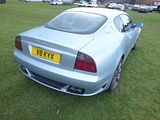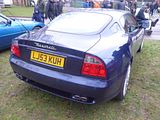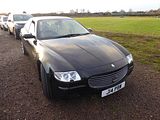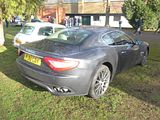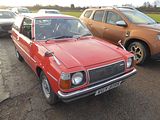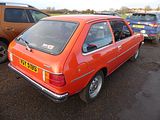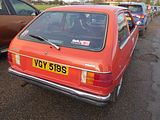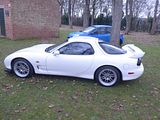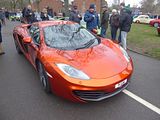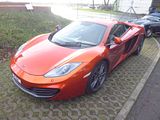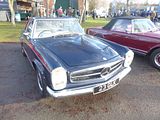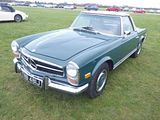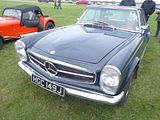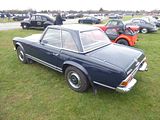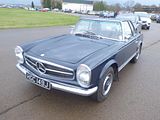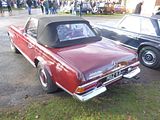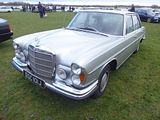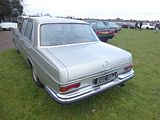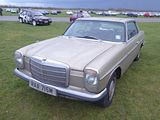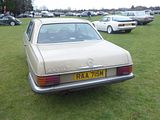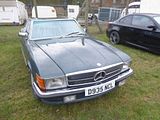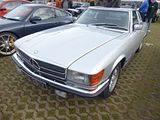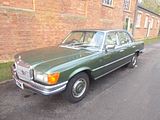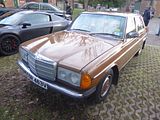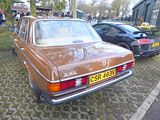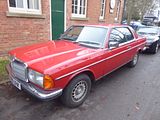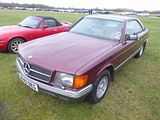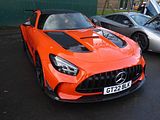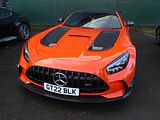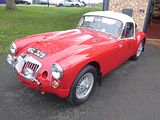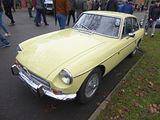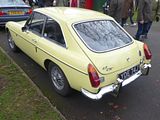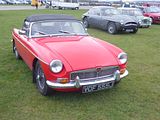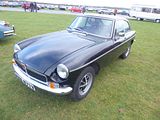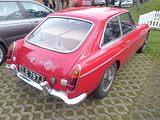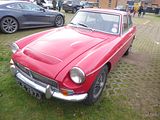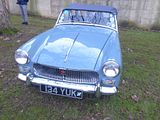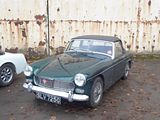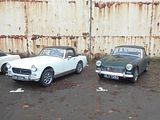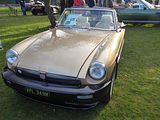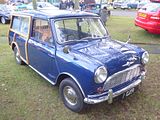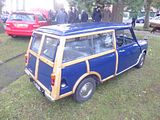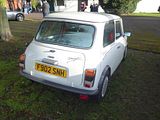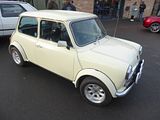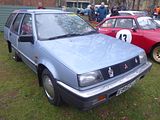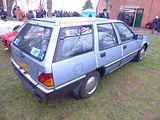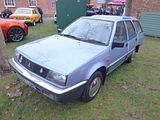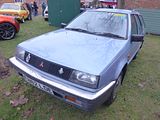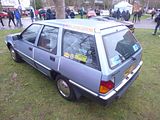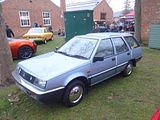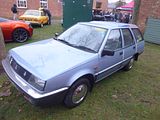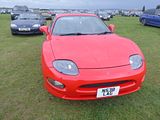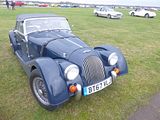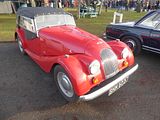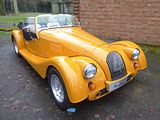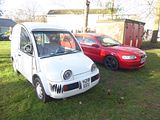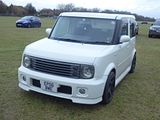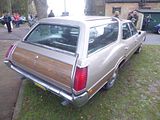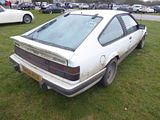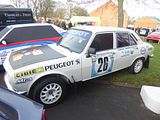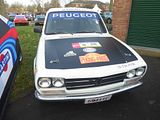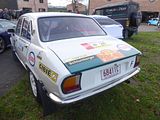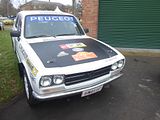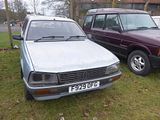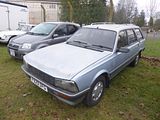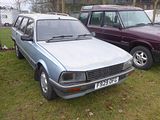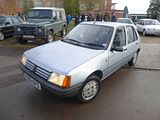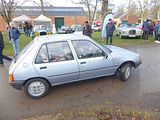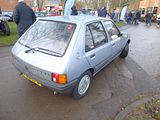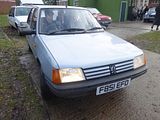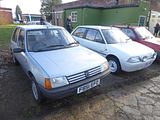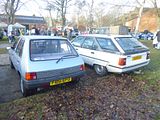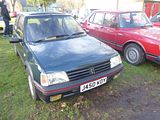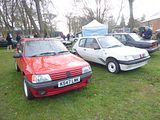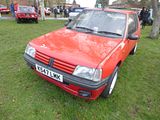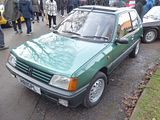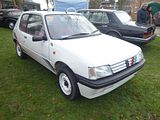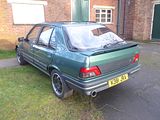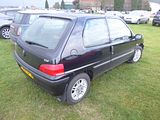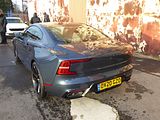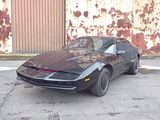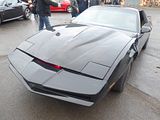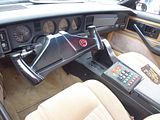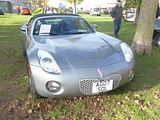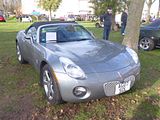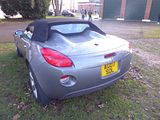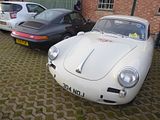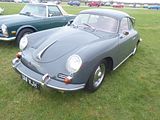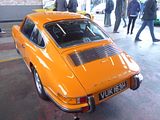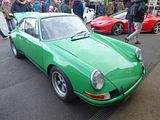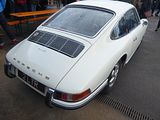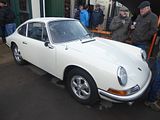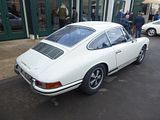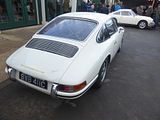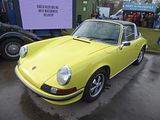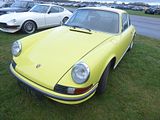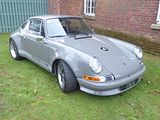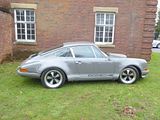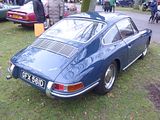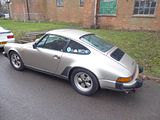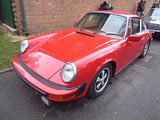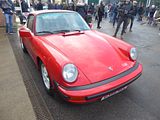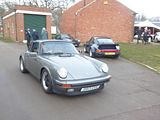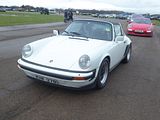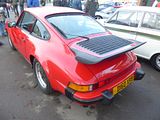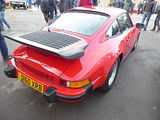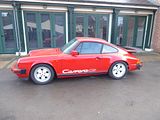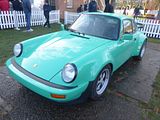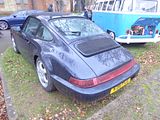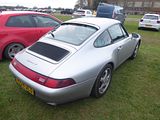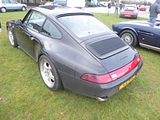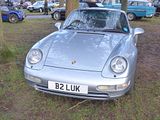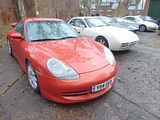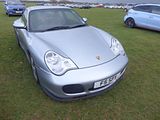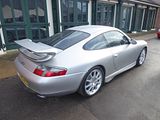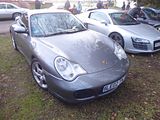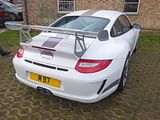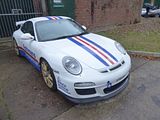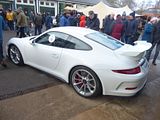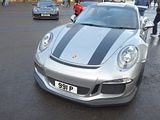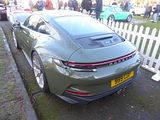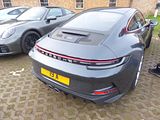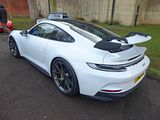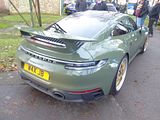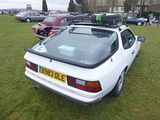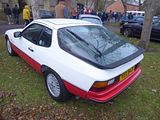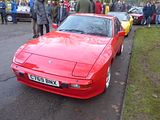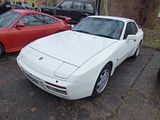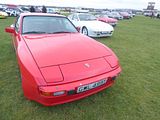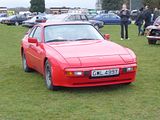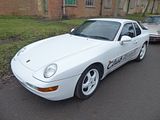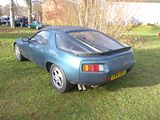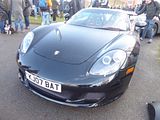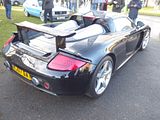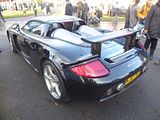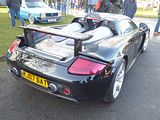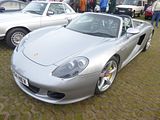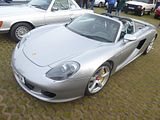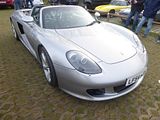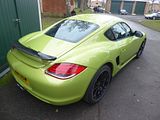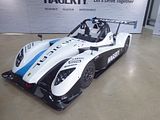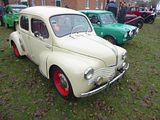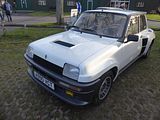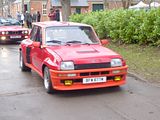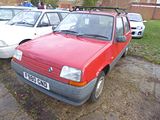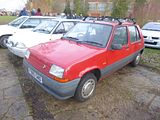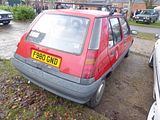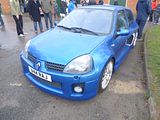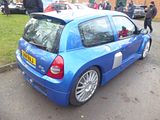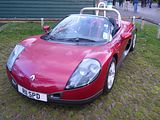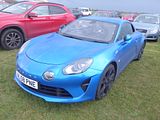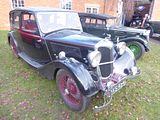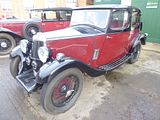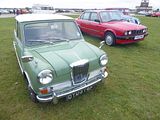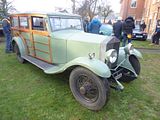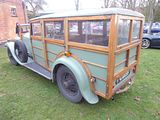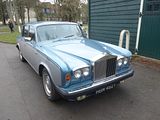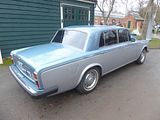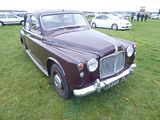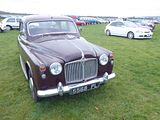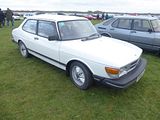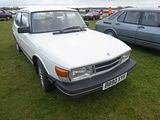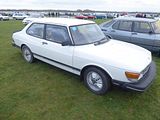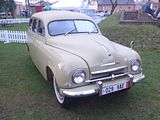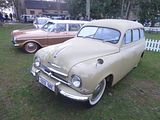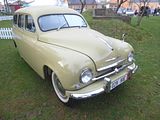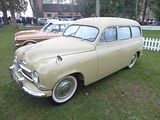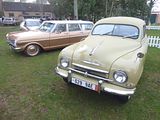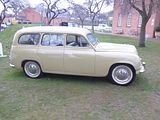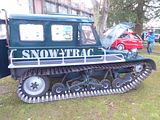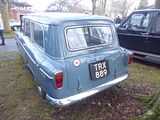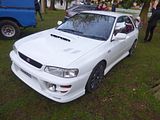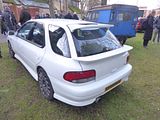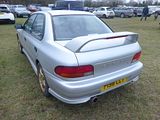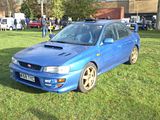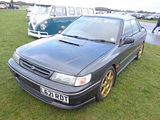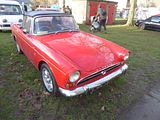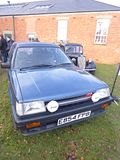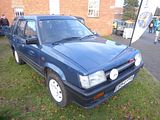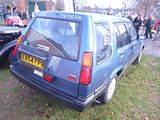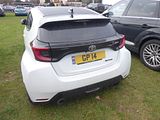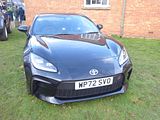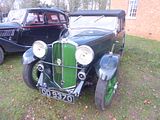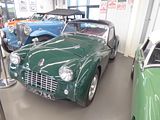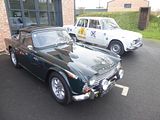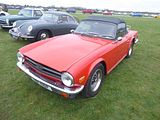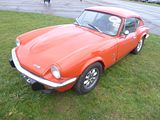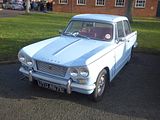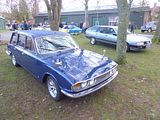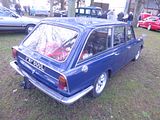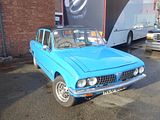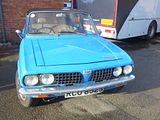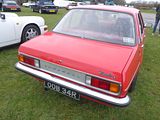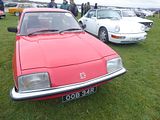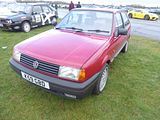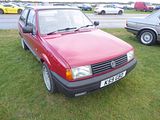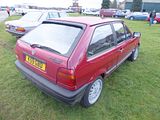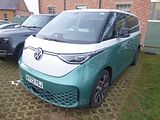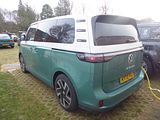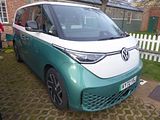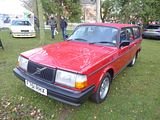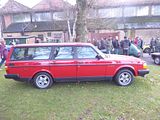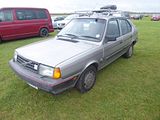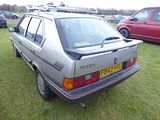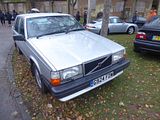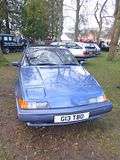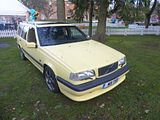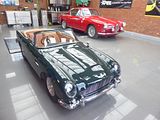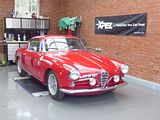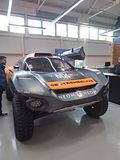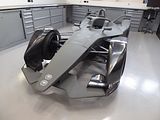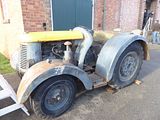MASERATI
After producing BiTurbo based cars for 17 years, Maserati replaced their entire range with a new model in July 1998, the 3200 GT. This very elegant 2+2 grand tourer was styled by Italdesign, whose founder and head Giorgetto Giugiaro had previously designed, among others, the Ghibli, Bora and Merak. The interior design was commissioned to Enrico Fumia. Its name honoured the Maserati 3500 GT, the Trident’s first series production grand tourer. Sold mainly in Europe, the 3200 GT was powered by the twin-turbo, 32-valve, dual overhead cam 3.2-litre V8 engine featured in the Quattroporte Evoluzione, set up to develop 370 PS (365 hp). The car was praised for its styling, with the distinctive array of tail-lights, consisting of LEDs, arranged in the shape of boomerang being particularly worthy of comment. The outer layer of the ‘boomerang’ provided the brake light, with the inner layer providing the directional indicator. The car was also reviewed quite well by the press when they got to drive it in early 1999, though it was clear that they expected more power and excitement. That came after 4,795 cars had been produced, in 2001, with the launch of the 4200 models. Officially called the Coupé and joined by an open-topped Spyder (Tipo M138 in Maserati speak), these models had larger 4.2 litre engines and had been engineered so the cars could be sold in America, marking the return to that market for Maserati after an 11 year gap. There were some detailed styling changes, most notable of which were the replacement of the boomerang rear lights with conventional rectangular units. Few felt that this was an improvement. The cars proved popular, though, selling strongly up until 2007 when they were replaced by the next generation of Maserati. Minor changes were made to the model during its six year production, but more significant was the launch at the 2004 Geneva Show of the GranSport which sported aerodynamic body cladding, a chrome mesh grille, carbon fibre interior trim, and special 19-inch wheels. It used the Skyhook active suspension, with a 0.4 inch lower ride height, and the Cambiocorsa transmission recalibrated for quicker shifts. The exhaust was specially tuned to “growl” on start-up and full throttle. The GranSport was powered by the same 4244 cc, 90° V8 petrol engine used on the Coupé and Spyder, but developing 400 PS (395 hp) at 7000 rpm due primarily to a different exhaust system and improvements on the intake manifolds and valve seats. A six-speed paddle shift transmission came as standard. The GranSport has a claimed top speed of 180 mph (290 km/h) and a 0–62 mph (0–100 km/h) time of 4.8 seconds.
Still acclaimed as one of the best-looking saloons ever produced is this car, the fifth generation Quattroporte, a couple of which were on show. Around 25,000 of these cars were made between 2004 and 2012, making it the second best selling Maserati of all time, beaten only by the cheaper BiTurbo of the 1980s. The Tipo M139 was unveiled to the world at the Frankfurt Motor Show on 9 September 2003, with production starting in 2004. Exterior and interior design was done by Pininfarina, and the result was widely acclaimed to be one of the best looking saloons not just of its time, but ever, an opinion many would not disagree with even now. Built on an entirely new platform, it was 50 cm (19.7 in) longer than its predecessor and sat on a 40 cm (15.7 in) longer wheelbase. The same architecture would later underpin the GranTurismo and GranCabrio coupés and convertibles. Initially it was powered by an evolution of the naturally aspirated dry sump 4.2-litre V8 engine, mounted on the Maserati Coupé, with an improved output of 400 PS . Due to its greater weight compared to the Coupé and Spyder, the 0-62 mph (0–100 km/h) time for the Quattroporte was 5.2 seconds and the top speed 171 mph (275 km/h). Initially offered in only one configuration, equipped with the DuoSelect transmission, the gearbox was the weak point of the car, receiving most of the criticism from the press reviews. Maserati increased the range at the 2005 Frankfurt Motor Show, with the launch of the Executive GT and Sport GT trim levels. The Executive GT came equipped with a wood-rimmed steering wheel, an alcantara suede interior roof lining, ventilated, adaptive, massaging rear seats, rear air conditioning controls, veneered retractable rear tables, and curtain shades on the rear windows. The exterior was distinguished by 19 inch eight-spoke ball-polished wheels and chrome mesh front and side grilles. The Quattroporte Sport GT variant offered several performance upgrades: faster shifting transmission and firmer Skyhook suspensions thanks to new software calibrations, seven-spoke 20 inch wheels with low-profile tyres, cross-drilled brake rotors and braided brake lines. Model-specific exterior trim included dark mesh front and side grilles and red accents to the Trident badges, as on vintage racing Maseratis. Inside there were aluminium pedals, a sport steering wheel and carbon fibre in place of the standard wood inserts. A new automatic transmission was presented at the 2007 Detroit Motor Show, marketed as the Maserati Quattroporte Automatica. As all three trim levels were offered in both DuoSelect and Automatica versions, the lineup grew to six models. The Quattroporte Sport GT S was introduced at the 2007 Frankfurt Motor Show. Taking further the Sport GT’s focus on handling, this version employed Bilstein single-rate dampers in place of the Skyhook adaptive system. Other changes from the Sport GT comprised a lowered ride height and 10 mm wider 295/30 rear tyres, front Brembo iron/aluminium dual-cast brake rotors and red-painted six piston callipers. The cabin was upholstered in mixed alcantara and leather, with carbon fibre accents; outside the door handles were painted in body colour, while the exterior trim, the 20 inch wheels and the exhaust pipes were finished in a “dark chrome” shade. After Images of a facelifted Quattroporte appeared on the Internet in January 2008; the car made its official début at the 2008 Geneva Motor Show. Overseen by Pininfarina, the facelift brought redesigned bumpers, side sills and side mirrors, a convex front grille with vertical bars instead of horizontal, new headlights and tail lights with directional bi-xenon main beams and LED turn signals. Inside there was a new navigation and entertainment system. All Quattroporte models now used the ZF automatic transmission, the DuoSelect being discontinued. The 4.2-litre Quattroporte now came equipped with single-rate damping comfort-tuned suspension and 18 inch wheels. Debuting alongside it was the Quattroporte S, powered by a wet-sump 4.7-litre V8, the same engine of the Maserati GranTurismo S, with a maximum power of 424 bhp and maximum torque of 361 lb·ft. In conjunction with the engine, the braking system was upgraded to cross-drilled discs on both axles and dual-cast 360 mm rotors with six piston callipers at the front. Skyhook active damping suspension and 19 inch V-spoke wheels were standard. Trim differences from the 4.2-litre cars were limited to a chrome instead of titanium-coloured front grille. The Quattroporte Sport GT S was premièred at the North American International Auto Show in January 2009. Its 4.7-litre V8 produced 440 PS (434 hp), ten more than the Quattroporte S, thanks to revised intake and to a sport exhaust system with electronically actuated bypass valves. Other mechanical changes were to the suspensions, where as on the first Sport GT S single-rate dampers took place of the Skyhook system, ride height was further lowered and stiffer springs were adopted. The exterior was distinguished by a specific front grille with convex vertical bars, black headlight bezels, red accents to the Trident badges, the absence of chrome window trim, body colour door handles and black double oval exhaust pipes instead of the four round ones found on other Quattroporte models. Inside veneers were replaced by “Titan Tex” composite material and the cabin was upholstered in mixed Alcantara and leather. This means that there are quite a number of different versions among the 25,256 units produced, with the early DuoSelect cars being the most numerous.
The Maserati GranTurismo and GranCabrio (Tipo M145) are a series of a grand tourers produced from 2007 to 2019. They succeeded the 2-door V8 grand tourers offered by the company, the Maserati Coupé, and Spyder. The GranTurismo set a record for the most quickly developed car in the auto industry, going from design to production stage in just nine months. The reason being that Ferrari, after selling off Maserati to the Fiat Chrysler Group, took the designs of the proposed replacement of the Maserati Coupé and after some modifications, launched it as the Ferrari California. Unveiled at the 2007 Geneva Motor Show, the GranTurismo has a drag coefficient of 0.33. The model was initially equipped with a 4.2-litre V8 engine developed in conjunction with Ferrari. The engine generates a maximum power output of 405 PS and is equipped with a 6-speed ZF automatic transmission. The 2+2 body was derived from the Maserati M139 platform, also shared with the Maserati Quattroporte V, with double-wishbone front suspension and a multilink rear suspension. The grand tourer emphasises comfort in harmony with speed and driver-enjoyment. The better equipped S variant was unveiled at the 2008 Geneva Motor Show and features the enlarged 4.7-litre V8 engine shared with the Alfa Romeo 8C Competizione, rated at 440 PS at 7,000 rpm and 490 Nm (361 lb/ft) of torque at 4,750 rpm. At the time of its introduction, it was the most powerful road-legal Maserati offered for sale (excluding the homologation special MC12). The engine is mated to the 6-speed automated manual shared with the Ferrari F430. With the transaxle layout weight distribution improved to 47% front and 53% rear. The standard suspension set-up is fixed-setting steel dampers, with the Skyhook adaptive suspension available as an option along with a new exhaust system, and upgraded Brembo brakes. The seats were also offered with various leather and Alcantara trim options. The upgrades were made to make the car more powerful and more appealing to the buyers while increasing performance, with acceleration from 0–100 km/h (0–62 mph) happening in 4.9 seconds and a maximum speed of 295 km/h (183 mph). Aside from the power upgrades, the car featured new side skirts, unique 20-inch wheels unavailable on the standard car, a small boot lip spoiler, and black headlight clusters in place of the original silver. The variant was available in the North American market only for MY2009 with only 300 units offered for sale. The GranTurismo MC is the racing version of the GranTurismo S developed to compete in the FIA GT4 European Cup and is based on the Maserati MC concept. The car included a 6-point racing harness, 120 litre fuel tank, 380 mm (15.0 in) front and 326 mm (12.8 in) rear brake discs with 6-piston calipers at the front and 4-piston calipers at the rear, 18-inch racing wheels with 305/645/18 front and 305/680/18 rear tyres, carbon fibre bodywork and lexan windows throughout along with a race interior. All the weight-saving measures lower the weight to about 3,000 lb (1,361 kg). The car shares the 4.7-litre V8 engine from the GranTurismo S but is tuned to generate a maximum power output of 450 PS along with the 6-speed automated manual transmission. The GranTurismo MC was unveiled at the Paul Ricard Circuit in France. It went on sale in October, 2009 through the Maserati Corse programme. 15 GranTurismo MC racecars were developed, homologated for the European Cup and National Endurance Series, one of which was taken to be raced by GT motorsport organization Cool Victory in Dubai in January, 2010. Introduced in 2008, the GranTurismo MC Sport Line is a customisation programme based on the GranTurismo MC concept. Changes include front and rear carbon-fibre spoilers, carbon-fibre mirror housings and door handles, 20-inch wheels, carbon-fibre interior (steering wheel rim, paddle shifters, instrument panel, dashboard, door panels), stiffer springs, shock absorbers and anti-roll bars with custom Maserati Stability Programme software and 10 mm (0.4 in) lower height than GranTurismo S. The programme was initially offered for the GranTurismo S only, with the product line expanded to all GranTurismo variants and eventually all Maserati vehicles in 2009. Replacing both the GranTurismo S and S Automatic, the Granturismo Sport was unveiled in March 2012 at the Geneva Motor Show. The revised 4.7L engine is rated at 460 PS. The Sport features a unique MC Stradale-inspired front fascia, new headlights and new, sportier steering wheel and seats. The ZF six-speed automatic gearbox is now standard, while the six-speed automated manual transaxle is available as an option. The latter has steering column-mounted paddle-shifters, a feature that’s optional with the automatic gearbox. New redesigned front bumper and air splitter lowers drag coefficient from Cd=0.33 to 0.32. In September 2010, Maserati announced plans to unveil a new version of the GranTurismo – the MC Stradale – at the 2010 Paris Motor Show. The strictly two-seat MC Stradale is more powerful than the GranTurismo at 450 PS, friction reduction accounts for the increase, says Maserati, due to the strategic use of “diamond-like coating”, an antifriction technology derived from Formula 1, on wear parts such as the cams and followers. It is also 110 kg lighter (1,670 kg dry weight) from the GranTurismo, and more aerodynamic than any previous GranTurismo model – all with the same fuel consumption as the regular GranTurismo. In addition to two air intakes in the bonnet, the MC Stradale also receives a new front splitter and rear air dam for better aerodynamics, downforce, and improved cooling of carbon-ceramic brakes and engine. The body modifications make the car 48 mm (2 in) longer. The MC Race Shift 6-speed robotised manual gearbox (which shares its electronics and some of its hardware from the Ferrari 599 GTO) usually operates in an “auto” mode, but the driver can switch this to ‘sport’ or ‘race’ (shifting happening in 60 milliseconds in ‘race’ mode), which affects gearbox operations, suspension, traction control, and even the sound of the engine. The MC Stradale is the first GranTurismo to break the 300 km/h (186 mph) barrier, with a claimed top speed of 303 km/h (188 mph). The push for the Maserati GranTurismo MC Stradale came from existing Maserati customers who wanted a road-legal super sports car that looked and felt like the GT4, GTD, and Trofeo race cars. It has been confirmed by the Maserati head office that only 497 units of 2-seater MC Stradales were built in total from 2011 to 2013 in the world, Europe: 225 units, China: 45 units, Hong Kong: 12, Taiwan: 23 units, Japan: 33 units, Oceania: 15 units and 144 units in other countries. US market MC’s do not have the “Stradale” part of the name, and they are sold with a fully automatic six-speed transmission rather than the one available in the rest of the world. US market cars also do not come with carbon fibre lightweight seats like the rest of the world. The MC Stradale’s suspension is 8% stiffer and the car rides slightly lower than the GranTurismo S following feedback from racing drivers who appreciated the better grip and intuitive driving feel of the lower profile. Pirelli has custom-designed extra-wide 20-inch P Zero Corsa tyres to fit new flow-formed alloy wheels. The Brembo braking system with carbon-ceramic discs weighs around 60% less than the traditional system with steel discs. The front is equipped with 380 x 34 mm ventilated discs, operated by a 6 piston caliper. The rear discs measure 360 x 32 mm with four-piston calipers. The stopping distance is 33 m at 100 km/h (62 mph) with an average deceleration of 1.2g. At the 2013 Geneva Motor Show, an update to the GranTurismo MC Stradale was unveiled. It features an updated 4.7 litre V8 engine rated at 460 PS at 7,000 rpm and 520 Nm (384 lb/ft) of torque at 4,750 rpm, as well as the MC Race Shift 6-speed robotized manual gearbox which shifts in 60 milliseconds in ‘race’ mode. The top speed is 303 km/h (188 mph). All models were built at the historic factory in viale Ciro Menotti in Modena. A total of 28,805 GranTurismos and 11,715 units of the convertible were produced. The final production example of the GranTurismo, called Zéda, was presented painted in a gradient of blue, black and white colours.
MAZDA
The Familia AP (323 in most of the world, GLC for “Great Little Car” in North America) debuted in January 1977 as a rear-wheel-drive subcompact, replacing both the Grand Familia (818) and the preceding Familia (1000/1300). There was a choice of hatchbacks and station wagon bodies, both available with a three- or five-door bodystyle. The station wagon version was a bit later, first being introduced in June 1978, which also meant that the commercial versions based on the 1970 Familia could finally be retired. Three Mazda engines were available, the 985 cc PC, 1,272 cc TC, and the 1415 cc UC (introduced in March 1978). The 1.0-liter unit was only made for export markets. The new Familia shared many parts with the older Mazda Grand Familia. This was the first appearance of the 323 name, for export markets only. The Familia AP was marketed to a new kind of youthful Japanese consumer, and sold very well at home as well as abroad. Nonetheless, the cars traditional rear-wheel-drive underpinnings limited interior space and betrayed themselves in having a very narrow track when compared to the body. The FA4 was somewhat of an interim solution while Mazda worked on a front-wheel-drive car, but still managed to sell around 890,000 examples in its three full years of production. In June 1979 the 323/Familia underwent a facelift, replacing the previous round headlights with rectangular units which were designed as a single unit along with the grille. The new style was in line with that of the recently released Mazda Capella/626 (CB). Other minor differences occurred along with the facelift. The range was replaced in 1980, however, the station wagon models continued in production until 1986.
The third-generation RX‑7, FD (chassis code FD3S for Japan and JM1FD for the North America), featured an updated body design. The 13B-REW was the first-ever mass-produced sequential twin-turbocharger system to be exported from Japan, boosting power to 255 PS (252 bhp) in 1992 and finally to 280 PS (276 bhp) by the time production ended in Japan in 2002. The RX-7 FD’s chief designer was Yoichi Sato (佐藤 洋一, Satō Yōichi). Another key designer was Wu-huang Chin (秦無荒), a Taiwanese automotive artist who also worked on the Mazda MX-5 Miata. In Japan, sales were affected by this series’ non-compliance with Japanese dimension regulations and Japanese buyers paid annual taxes for the car’s non-compliant width. As the RX‑7 was now considered an upper-level luxury sports car due to the increased width dimensions, Mazda also offered two smaller offerings, the Eunos Roadster, and the Eunos Presso hatchback. The sequential twin turbocharging system, introduced in 1992, was extremely complex and was developed with the aid of Hitachi. It was previously used on the exclusive-to-Japan Cosmo JC Series. The system used two turbochargers, one to provide 10 psi (0.69 bar) of boost from 1,800 rpm. The second turbocharger activated in the upper half of the rpm range, during full-throttle acceleration – at 4,000 rpm to maintain 10 psi (0.69 bar) until redline. The changeover process occurred at 4,500 rpm, with a momentary dip in pressure to 8 psi (0.55 bar), and provided semi-linear acceleration from a wide torque curve throughout the entire rev range under normal operation. Under high-speed-driving conditions, the changeover process produced a significant increase in power output and forced technical drivers to adjust their driving style to anticipate and mitigate any over-steer during cornering. The standard turbo control system used 4 control solenoids, 4 actuators, both a vacuum and pressure chamber, and several feet of preformed vacuum/pressure hoses, all of which were prone to failure in part due to complexity and the inherent high temperatures of the rotary engine. The initial Series 6 was produced from 1992-1995, and was exported throughout the world and had the highest sales. In Japan, Mazda sold the RX-7 through its ɛ̃fini brand as the ɛ̃fini RX-7. Models in Japan included the Type S, the base model, Type R, the lightweight sports model, Type RZ, Type RB, A-spec and the Touring X, which came with a four-speed automatic transmission. The RX-7 was sold in 1993–1995 in the U.S. and Canada. The Series 6 was rated at 255 PS (252 hp) and 294 Nm (217 lb/ft). In the United Kingdom, for 1992, customers were offered only one version of the FD, which was based on a combination of the US touring and the base model. For the following year, in a bid to speed up sales, Mazda reduced the price of the RX-7 to £25,000, down from £32,000, and refunded the difference to those who bought the car before that was announced. From 1992 to 1995, only 210 FD RX-7s were officially sold in the UK. The FD continued to be imported to the UK until 1996. In 1998, for a car that had suffered from slow sales when it was officially sold, with a surge of interest and the benefit of a newly introduced SVA scheme, the FD would become so popular that there were more parallel and grey imported models brought into the country than Mazda UK had ever imported. The Series 7 ran from 1996-1998 and included minor changes to the car. Updates included a simplified vacuum routing manifold and a 16-bit ECU which combined with an improved intake system netted an extra 10 PS. This additional horsepower was only available on manual transmission cars as the increase in power was only seen above 7,000 rpm, which was the redline for automatic transmission equipped cars. The rear spoiler and tail lights were also redesigned. The Type RZ model was now equipped with larger brake rotors as well as 17-inch BBS wheels. In Japan, the Series 7 RX-7 was marketed under the Mazda and ɛ̃fini brand name. Series 7 RX-7s were also sold in Australia, New Zealand and the UK. Series 7 models were produced only with right-hand drive (RHD), which likely explains why they were only exported to these RHD markets. Sold from 1998-2002, the series 8 was the final series, and was only available in the Japanese market. More efficient turbochargers were available on certain models, while improved intercooling and radiator cooling was made possible by a redesigned front fascia with larger openings. The seats, steering wheel, and instrument cluster were all changed. The rear spoiler was modified and gained adjustability on certain models. Three horsepower levels are available: 255 PS (252 bhp) for automatic transmission equipped cars, 265 PS (261 bhp) for the Type RB, and 280 PS (276 bhp) available on the top-of-the-line sporting models. The high-end “Type RS” came equipped with Bilstein suspension and 17-inch wheels as standard equipment, and reduced weight to 1,280 kg (2,822 lb). Power was increased with the addition of a less restrictive muffler and more efficient turbochargers which featured abradable compressor seals, 280 PS (276 bhp) at 6,500 rpm and 314 Nm (232 lb/ft) of torque at 5000 rpm as per the maximum Japanese limit. The Type RS had a brake upgrade by increasing rotor diameter front and rear to 314 mm (12.4 in) and front rotor thickness from 22 mm (0.9 in) to 32 mm (1.3 in). The Type RS version also sported a 4.30 final drive ratio, providing a significant reduction in its 0–100 km/h (62 mph) time. The gearbox was also modified, 5th gear was made longer to reduce cruising rpm and improve fuel efficiency. The very limited edition Type RZ version included all the features of the Type RS, but at a lighter weight, at 1,270 kg (2,800 lb). It also featured gun-metal coloured BBS wheels and a red racing themed interior. An improved ABS system worked by braking differently on each wheel, allowing the car better turning during braking. The effective result made for safer driving for the average buyer. Easily the most collectible of all the RX-7s was the last model limited to 1,500 units. Dubbed the “Spirit R”, they combined all the extra features Mazda had used on previous limited-run specials with new exclusive features like cross-drilled brake rotors. Sticker prices when new were 3,998,000 yen for Type-A and B and 3,398,000 yen for Type-C. Mazda’s press release said “The Type-A Spirit R model is the ultimate RX-7, boasting the most outstanding driving performance in its history.” There are three models of “Spirit R”: the “Type A”, “Type B”, and “Type C”. The “Type A” is a two-seater with a 5-speed manual transmission. It features lightweight red trim Recaro front seats as seen in the earlier RZ models. The “Type B” shares all features of the “Type A” but with a 2+2 seat configuration. The “Type C” is also a 2+2, but has a four-speed automatic transmission. Of the 1504 Spirit R’s made, 1044 were Type A, 420 Type B and 40 Type C. An exclusive Spirit R paint colour, Titanium Grey, adorned 719 of the 1504 cars produced.
McLAREN
The MP4 12C was the first ever production car wholly designed and built by McLaren, and their first production road car produced since the McLaren F1, which ended production in 1998. McLaren started developing the car in 2007 and secretly purchased a Ferrari 360 to use as a test mule. The mule called MV1 was used to test the 3.8-litre twin-turbocharged V8 engine. The car also featured side vents for additional cooling which were later incorporated in the final production model. Later in the year, the company purchased an Ultima GTR to test the braking system and suspension components, that mule was called the MV2. The space frame and body of that car were modified in order to accommodate the new components. Later another prototype was purchased which was another Ferrari 360 dubbed the MV3 which was used to test the exhaust system. McLaren then built two prototypes themselves called CP1 and CP2 incorporating the Carbon Monocell monocoque which were used for testing the heat management system and performance. The MP4-12C features a carbon fibre composite chassis, and is powered by a longitudinally-mounted Rear mid-engine, rear-wheel-drive layout McLaren M838T 3.8 litre twin-turbocharged V8 engine, developing approximately 600 PS (592 bhp) at 7500 rpm and around 600 N⋅m (443 lbf⋅ft) of torque at 5600 rpm. The car makes use of Formula 1-sourced technologies such as “brake steer”, where the inside rear wheel is braked during fast cornering to reduce understeer. Power is transmitted to the wheels through a seven-speed dual-clutch transmission. The entire drivetrain is the first to be entirely designed and produced in house by McLaren. The chassis is based around a F1 style one-piece carbon fibre tub, called the Carbon MonoCell, weighing only 80 kg (176 lb). The MonoCell is made in a single pressing by using a set of patented processes, using Bi-Axial and Tri-Axial carbon fibre multi-axial fabrics produced by Formax UK Ltd. with the MonoCell manufactured by Carbo Tech in Salzburg, Austria. This has reduced the time required to produce a MonoCell from 3,000 hours for the F1 and 500 hours for the Mercedes-Benz SLR McLaren, to 4 hours for the MP4-12C. The McLaren MP4-12C utilizes a unique hydraulic configuration to suspend the vehicle as opposed to more traditional coil springs, dampers and anti-roll bars. What McLaren has called “ProActive Chassis Control,” the system consists of an array of high and low pressure valves interconnected from both left to right and front to back, and the typical anti-roll bars were omitted entirely. When high pressure meets high pressure under roll conditions, stiffness results; and subsequently when high pressure meets low under heave and warp, more give is allowed, ultimately providing a firmer, competent suspension setup in spirited driving, and a very plush, compliant and comfortable ride when moving at slower, constant speeds. The car has a conventional two side-by-side seating arrangement, unlike its predecessor the McLaren F1 which featured an irregular three seat formation (front centre, two behind either side). To make up for this however, the car’s central console is narrower than in other cars, seating the driver closer to the centre. Interior trim and materials can be specified in asymmetric configuration – known as “Driver Zone”. The final car was unveiled to the public on 9 September 2009 before the company’s launch in 2010. A convertible version of the car called the MP4-12C Spider, as added to the range in 2012. The name’s former prefix ‘MP4’ has been the chassis designation for all McLaren Formula 1 cars since 1981. ‘MP4′ stands for McLaren Project 4 as a result of the merger between Ron Dennis’ Project 4 organisation with McLaren. The ’12’ refers to McLaren’s internal Vehicle Performance Index through which it rates key performance criteria both for competitors and for its own cars. The criteria combine power, weight, emissions, and aerodynamic efficiency. The coalition of all these values delivers an overall performance index that has been used as a benchmark throughout the car’s development. The ‘C’ refers to Carbon, highlighting the application of carbon fibre technology to the future range of McLaren sports cars. At the end of 2012, the name of the MP4-12C was reduced to 12C – that name is usually used when referring to the coupe. The open-top version now being called the 12C Spider.
In June 2018, McLaren unveiled the top-of-the-line sports series variant online. The car, called the 600LT is based on the 570S and is the third McLaren production car to receive the longtail treatment. Inspired by the 675LT and the F1 GTR Longtail, the body of the car has been extended by 73.7 mm (2.9 in). The car also features enhanced aerodynamic elements such as an extended front splitter and rear diffuser, new side sills, and an aero-enhancing fixed rear wing for increased downforce. McLaren claims that 23% parts on the 600LT are new as compared to the 570S. The carbon fibre monocoque utilised in the 600LT is modified and this combined with the extensive use of carbon fibre in the roof along with the cantrails and front wings, results in a weight saving of 96 kg (212 lb) over the 570S, with the total weight amounting to 1,247 kg (2,749 lb). Another distinguishing feature of the 600LT is the lightweight titanium exhaust system which is mounted on top of the rear of the car which harks back to its original application in the Senna. The interior features sports bucket seats from the P1 and Alcantara trim but can be optioned with the much lighter bucket seats found in the Senna. The 3.8-litre twin-turbocharged V8 engine utilised in the 600LT is tuned to produce a maximum power output of 600 PS (592 bhp) (hence the 600 in the name) and 620 N⋅m (457 lb⋅ft) of torque, achieving a power-to-weight ratio of 479 PS per tonne. Performance figures and production numbers of the car remain unknown. Production of the 600LT started in October 2018. In January 2019, McLaren unveiled the convertible variant of the 600LT at the Detroit Auto Show. Due to the use of the same carbon monocoque as the other models in the 570S lineage the 600LT Spider required did not need any extra modifications to incorporate a folding hardtop roof. As a result, the Spider weighs 50 kg (110 lb) more than the coupé while maintaining the same performance statistics. The Spider has the same engine and aerodynamic components as the coupé and share the roof folding mechanism with the standard 570S Spider which can be operated at speeds upto 40 km/h (25 mph). The car can accelerate to 100 km/h (62 mph) in 2.9 seconds, to 200 km/h (124 mph) in 8.4 seconds (0.2 seconds more than the coupé) and can attain a top speed of 315 km/h (196 mph) with the roof retracted and 323 km/h (201 mph) with the roof closed. The car can achieve a dry weight of 1,297 kg (2,859 lb) when equipped with the MSO ClubSport package which includes the removal of air-conditioning and radio, titanium wheel nuts and the replacement of the standard seats with the carbon fibre seats from the Senna. The car has received rave reviews.
MERCEDES-BENZ
Replacement for the 190SL cars of the 1950s were the “Pagoda” series of W113 cars. By 1955, Mercedes-Benz Technical Director Prof. Fritz Nallinger and his team held no illusions regarding the 190 SL’s lack of performance, while the high price tag of the legendary 300 SL supercar kept it elusive for all but the most affluent buyers. Thus Mercedes-Benz started evolving the 190 SL on a new platform, model code W127, with a fuel-injected 2.2 litre M127 inline-six engine, internally denoted as 220SL. Encouraged by positive test results, Nallinger proposed that the 220SL be placed in the Mercedes-Benz program, with production commencing in July 1957. However, while technical difficulties kept postponing the production start of the W127, the emerging new S-Class W112 platform introduced novel body manufacturing technology altogether. So in 1960, Nallinger eventually proposed to develop a completely new 220SL design, based on the “fintail” W 111 sedan platform with its chassis shortened by 11.8 in, and technology from the W112. This led to the W113 platform, with an improved fuel-injected 2.3 litre M127 inline-six engine and the distinctive “pagoda” hardtop roof, designated as 230 SL. The 230 SL made its debut at the prestigious Geneva Motor Show in March 1963, where Nallinger introduced it as follows: “It was our aim to create a very safe and fast sports car with high performance, which despite its sports characteristics, provides a very high degree of travelling comfort”. The W113 was the first sports car with a “safety body,” based on Bela Barényi’s extensive work on vehicle safety: It had a rigid passenger cell and designated crumple zones with impact-absorbing front and rear sections built into the vehicle structure. The interior was “rounded,” with all hard corners and edges removed, as in the W111 sedan. Production of the 230 SL commenced in June 1963 and ended on 5 January 1967. Its chassis was based on the W 111 sedan platform, with a reduced wheelbase by 11.8 in, recirculating ball steering (with optional power steering), double wishbone front suspension and an independent single-joint, low-pivot swing rear-axle with transverse compensator spring. The dual-circuit brake system had front disc brakes and power-assisted rear drum brakes. The 230 SL was offered with a 4-speed manual transmission, or an optional, very responsive fluid coupled (no torque converter) 4-speed automatic transmission, which was popular for US models. From May 1966, the ZF S5-20 5-speed manual transmission was available as an additional option, which was particularly popular in Italy. The 2,308 cc M127.II inline-six engine with 150 hp and 145 lb/ft torque was based on Mercedes-Benz’ venerable M180 inline-six with four main bearings and mechanical Bosch multi-port fuel injection. Mercedes-Benz made a number of modifications to boost its power, including increasing displacement from 2,197 cc, and using a completely new cylinder head with a higher compression ratio (9.3 vs. 8.7), enlarged valves and a modified camshaft. A fuel injection pump with six plungers instead of two was fitted, which allowed placing the nozzles in the cylinder head and “shooting” the fuel through the intake manifold and open valves directly into the combustion chambers. An optional oil-water heat exchanger was also available. Of the 19,831 230 SLs produced, less than a quarter were sold in the US. Looking identical, the 250 SL was introduced at the 1967 Geneva Motor Show. Production had already commenced in December 1966 and ended in January 1968. The short one-year production run makes the 250 SL the rarest of the W113 series cars. The 250 SL retained the stiffer suspension and sportier feel of the early SLs, but provided improved agility with a new engine and rear disc brakes. Range also improved with increased fuel tank capacity from 65 litres to 82. Like its predecessor, the 250 SL was offered with a 4-speed automatic transmission, and 4-speed or ZF 5-speed manual transmissions. For the first time, an optional limited slip differential was also available. The main change was the use of the 2,496 cc M129.II engine with a larger stroke, increased valve ports, and seven main bearings instead of four. The nominal maximum power remained unchanged at 150 hp, but torque improved from 145 lb/ft to 159 lb/ft. Resiliency also improved with a new cooling water tank (“round top”) with increased capacity and a standard oil-water heat exchanger. The 250 SL also marked the introduction of a 2+2 body style, the so-called “California Coupé”, which had only the removable hardtop and no soft-top: a small fold-down rear bench seat replaced the soft-top well between passenger compartment and boot. It is estimated that only 10% of the 250SLs that were brought into America were California Coupes. Of the 5,196 250 SLs produced, more than a third were sold in the US.The 280 SL was introduced in December 1967 and continued in production through 23 February 1971, when the W 113 was replaced by its successor, the entirely new and substantially heavier R107 350 SL. The main change was an upgrade to the 2,778 cc M130 engine with 170 hp and 180 lb/ft, which finally gave the W 113 adequate power. The performance improvement was achieved by increasing bore by 4.5 mm (0.2 in), which stretched the limits of the M180 block, and required pairwise cylinder casts without cooling water passages. This mandated an oil-cooler, which was fitted vertically next to the radiator. Each engine was now bench-tested for two hours prior to being fitted, so their power specification was guaranteed at last. The M130 marked the final evolution of Mercedes-Benz’ venerable SOHC M180 inline-six, before it was superseded by the entirely new DOHC M110 inline-six introduced with R107 1974 European 280 SL models. For some time, it was also used in the W 109 300 S-Class, where it retired the expensive 3 liter M189 alloy inline-six. Over the years, the W 113 evolved from a sports car into a comfortable grand tourer, and US models were by then usually equipped with the 4-speed automatic transmission and air conditioning. Manual transmission models came with the standard 4-speed or the optional ZF 5-speed, which was ordered only 882 times and thus is a highly sought-after original option today. In Europe, manual transmissions without air conditioning were still the predominant choice. Of the 23,885 280 SLs produced, more than half were sold in the US.
This one comes from the W108 family. The car’s predecessor, the Mercedes-Benz W111 (produced 1959–1971) helped Daimler develop greater sales and achieve economy of scale production. Whereas in the 1950s, Mercedes-Benz was producing the coachwork 300 S and 300 SLs and all but hand-built 300 Adenauers alongside conveyor assembled Pontons (190, 190SL and 220) etc., the fintail (German: Heckflosse) family united the entire Mercedes-Benz range of vehicles onto one automobile platform, reducing production time and costs. However, the design fashion of the early 1960s changed. For example, the tail fins, originally intended to improve aerodynamic stability, died out within a few years as a fashion accessory. By the time the 2-door coupé and cabriolet W111s were launched, the fins lost their chrome trim and sharp appearance, the arrival of the W113 Pagoda in 1963 saw them further buried into the boot’s contour, and finally disappeared on the W100 600 in 1964. The upgrade of the W111 began under the leadership of designer Paul Bracq in 1961 and ended in 1963. Although the fins’ departure was the most visible change, the W108 compared to the W111 had a lower body waist line that increased the window area, (the windscreen was 17 percent larger than W111). The cars had a lower ride (a decrease by 60 mm) and wider doors (+15 mm). The result was a visibly new car with a more sleek appearance and an open and spacious interior. The suspension system featured a reinforced rear axle with hydropneumatic compensating spring. The car sat on larger wheels (14”) and had disc brakes on front and rear. The W109 was identical to the W108, but featured an extended wheelbase of 115 mm (4.5 in) and self-levelling air suspension. This was seen as a successor to the W112 300SEL that was originally intended as an interim car between the 300 “Adenauer” (W189) and the 600 (W100) limousines. However, its success as “premium flagship” convinced Daimler to add an LWB car to the model range. From that moment on, all future S-Class models would feature a LWB line. Although the W108 succeeded the W111 as a premium range full-size car, it did not replace it. Production of the W111 continued, however the 230S was now downgraded to the mid-range series, the Mercedes-Benz W110, and marketed as a flagship of that family until their production ceased in 1968. The W108 is popular with collectors and the most desirable models to collect are the early floor shift models with the classic round gear knob and the 300 SEL’s. The car was premièred at the Frankfurt Auto Show in 1965. The initial model lineup consisted of three W108s: 250S, 250SE, and 300SE, as well as a sole W109, the 300SEL. Engines for the new car were carried over from the previous generation, but enlarged and refined. The 250S was the entry-level vehicle fitted with a 2496 cm³ Straight-six M108 engine, with two dual downdraft carburettors, delivering 130 bhp at 5400 rpm which accelerated the car to 100 km/h (62 mph) in 13 seconds (14 on automatic transmission) and gave a top speed of 182 km/h (177 on auto). The 250SE featured an identical straight-six, but with a six-plunger fuel injection (designated M129) with performance improved to 150 bhp (112 kW) at 5500 rpm, which decreased 0-100 acceleration by one second and increased top speed by 11 km/h (7 mph) for both manual and automatic versions. Both the 300SE and 300SEL came with the M189 2996 cm³ engine, originally developed for the Adenauers. It had a modern six-plunger pump that adjusted automatically to accelerator pedal pressure, engine speed, atmospheric pressure, and cooling water temperature, to deliver the proper mixture depending on driving conditions. Producing 170 bhp at 5,400 rpm the cars could accelerate to 200 km/h (195 km/h with automatic transmission) and reach 100 km/h (62 mph) in 12 seconds. The cylinder capacity of the three litre Mercedes engine was unchanged since 1951. From 1965 to 1967, fewer than 3,000 W109s were produced. However, approximately 130,000 of the less powerful 250 S/SE models were built during the first two years of the W108/109’s existence. By 1967 the fuel consumption of the 3 litre unit in this application was becoming increasingly uncompetitive.
Sometimes known as the “New Generation”, to distinguish it from its predecessor with the same model names, this is an example of the W114/115 range of cars that Mercedes introduced in 1968, which were produced until 1976 when they were replaced by the W123 range. W114 models featured six-cylinder engines and were marketed as the 230, 250, and 280, while W115 models featured four-cylinder engines and were marketed as the 200, 220, 230, and 240. All were styled by Paul Bracq, featuring a three-box design. At the time, Mercedes marketed saloons in two size classes, with the W114/W115, positioned below the Mercedes-Benz S-Class. The W114/W115 models were the first post-war Mercedes-Benz production car to use a newly engineered chassis, not derived from preceding models. The new chassis format of semi-trailing rear arms and ball-joint front end first displayed in the W114/W115 chassis would be used in all new Mercedes passenger car models until the development of the multi-link rear suspensions of the 1980s. The W108/109 S-Class chassis of the 280S/8, 280SE/8 and 300SEL/8 (and W113 280SL Pagoda) would be the last of the low-pivot swing axle and king pin/double wishbone front ends. The next S-Class -the W116 chassis- having the same engineering of the W114/115. Mercedes introduced a coupé variant of the W114 in 1969, featuring a longer boot and available with either a 2.5 or 2.8 litre six-cylinder engine. While a classic and understated design these generally cost less than the W113-based 280 SL model that ran through 1971, and its successor, the 3.5 or 4.5 litre V8 Mercedes SL R107/C107 (1971–1989) roadster and coupé. While a ‘hard-top’ unlike the fully convertible SL, the pillarless design allowed all the windows to be lowered completely for open air motoring. Only 67,048 coupés were manufactured from 1969 to 1976 (vs. 1.852,008 saloons). Of these 24,669 were 280C and 280CE (top of the range), and 42,379 were the lesser 250C and 250CE (A Mercedes-Benz 220D pickup on the W115 chassis was produced briefly in Argentina in the 1970s.) The W114 received a facelift in 1973 – with a lower bonnet-line, lower and broader grill, a single front bumper to replace the double bumpers, lower placement of the headlamps, A-pillar treatment for keeping the side windows clear, removal of the quarter-windows in the front doors, ribbed tail lights to minimise occlusion of the tail lights with road dirt, and larger side mirrors. The interior received inertia reel belts and a new padded steering wheel with a four-hole design. These cars were known to be extremely durable and tough, so the survival rate is quite great, especially in Germany, where they are popular classics.
With prices of the classic Pagoda model having risen to unaffordable for most people attention has started to switch to it successor, the R107 SL range, which had a long production life, being the second longest single series ever produced by the automaker, after the G-Class. The R107 and C107 took the chassis components of the mid-size Mercedes-Benz W114 model and mated them initially to the M116 and M117 V8 engines used in the W108, W109 and W111 series. The SL variant was a 2-seat convertible/roadster with standard soft top and optional hardtop and optional folding seats for the rear bench. The SLC (C107) derivative was a 2-door hardtop coupe with normal rear seats. The SLC is commonly referred to as an ‘SL coupe’, and this was the first time that Mercedes-Benz had based a coupe on an SL roadster platform rather than on a saloon, replacing the former saloon-based 280/300 SE coupé in Mercedes lineup. The SLC was replaced earlier than the SL, with the model run ending in 1981, with a much larger model, the 380 SEC and 500SEC based on the new S class. Volume production of the first R107 car, the 350 SL, started in April 1971 alongside the last of the W113 cars; the 350 SLC followed in October. The early 1971 350SL are very rare and were available with an optional 4 speed fluid coupling automatic gearbox. In addition, the rare 1971 cars were fitted with Bosch electronic fuel injection. Sales in North America began in 1972, and cars wore the name 350 SL, but had a larger 4.5L V8 with 3 speed auto (and were renamed 450 SL for model year 1973); the big V8 became available on other markets with the official introduction of the 450 SL/SLC on non-North American markets in March 1973. US cars sold from 1972 through 1975 used the Bosch D Jetronic fuel injection system, an early electronic engine management system. From July 1974 both SL and SLC could also be ordered with a fuel-injected 2.8L straight-6 as 280 SL and SLC. US models sold from 1976 through 1979 used the Bosch K Jetronic system, an entirely mechanical fuel injection system. All US models used the 4.5 litre engine, and were called 450 SL/SLC. In September 1977 the 450 SLC 5.0 joined the line. This was a homologation version of the big coupé, featuring a new all-aluminium five-litre V8, aluminium alloy bonnet and boot-lid, and a black rubber rear spoiler, along with a small front-lip spoiler. The 450SLC 5.0 was produced in order to homologate the SLC for the 1978 World Rally Championship. Starting in 1980, the 350, 450 and 450 SLC 5.0 models (like the 350 and 450 SL) were discontinued in 1980 with the introduction of the 380 and 500 SLC in March 1980. At the same time, the cars received a very mild makeover; the 3-speed automatic was replaced by a four-speed unit, returning to where the R107 started in 1971 with the optional 4 speed automatic 350SL. The 280, 380 and 500 SLC were discontinued in 1981 with the introduction of the W126 series 380 and 500 SEC coupes. A total of 62,888 SLCs had been manufactured over a ten-year period of which just 1,636 were the 450 SLC-5.0 and 1,133 were the 500 SLC. Both these models are sought by collectors today. With the exception of the SL65 AMG Black Series, the SLC remains the only fixed roof Mercedes-Benz coupe based on a roadster rather than a sedan. Following the discontinuation of the SLC in September 1981, the 107 series continued initially as the 280, 380 and 500 SL. At this time, the V8 engines were re-tuned for greater efficiency, lost a few hp and consumed less fuel- this largely due to substantially higher (numerically lower) axle ratios that went from 3.27:1 to 2.47:1 for the 380 SL and from 2.72:1 to 2.27:1 for the 500 SL. From September 1985 the 280 SL was replaced by a new 300 SL, and the 380 SL by a 420 SL; the 500 SL continued and a 560 SL was introduced for certain extra-European markets, notably the USA, Australia and Japan. Also in 1985, the Bosch KE Jetronic was fitted. The KE Jetronic system varied from the earlier, all mechanical system by the introduction of a more modern engine management “computer”, which controlled idle speed, fuel rate, and air/fuel mixture. The final car of the 18 years running 107 series was a 500 SL painted Signal red, built on August 4, 1989; it currently resides in the Mercedes-Benz museum in Stuttgart.
The W116 was the first Mercedes to be known officially by the title “S Class”, although sometimes it is now applied to the car’s predecessor as well, since it was also called – among other things – the 280SE. The ‘new’ S-class generation development began in 1966, which was only a year after the launch of the W108/09. This was the first Mercedes saloon to feature the brand new corporate styling theme which was to be continued until 1993 when the 190 was discontinued. The design, finalised in December 1969 was a dramatic leap forward, with more masculine lines that combined to create an elegant and sporty character. The basic design concept carried through the themes originally introduced on the R107 SL-Class roadster, especially the front and rear lights. As for the SL, the W116 received the ridged lamp covers which kept dirt accumulation at bay; this was to remain a Mercedes-Benz design theme into the 21st century. The W116 was Friedrich Geiger’s last design for Mercedes-Benz; his career had started with the Mercedes-Benz 500K in 1933. The car was presented in September 1972. The model range initially included two versions of the M110 engine (Straight-six with 2746 cc displacement)—the 280 S (using a Solex carburetor) and the 280 SE (using Bosch D-Jetronic injection), plus the 350 SE, powered by the M116 engine (V8 with 3499 cc displacement). After the 1973 Fuel Crisis, a long-wheelbase version of the 280 was added to the lineup. Half a year later, in early 1973, two new models powered by the M117 engine (V8 with 4520 cc displacement) were added to the range—the 450 SE and the 450 SEL (with a 100 mm longer body). The 450 had 225 PS in most markets, federalised cars offered 190 hp while Swedish market cars had an EGR-valve and 200 PS until 1976. The 450s received a plusher interior as well, with velour or leather seats rather than the checkered cloth of the lesser models. The door insides were also of a different design, being pulled up around the windows. The most notable W116 was the high-performance, limited-production 450 SEL 6.9, which was introduced in 1975. This model boasted by far the largest engine installed in a post-war Mercedes-Benz (and any non-American production automobile) up to that time, and also featured self-levelling hydropneumatic suspension. The 300 SD sedan (American market only) had a turbocharged 3.0-litre inline-five diesel engine developed from the C111 experimental vehicle. In September 2013, a 1979 W116 300 SD was campaigned in the 24 Hours of Lemons at Carolina Motorsports Park, where it completed 166 laps at an average speed of 54.8 MPH. It won the highest prize of the event, the Index of Effluency. Other than mild issues relating to brake and tire wear, no mechanical issues were encountered. After numerous modifications to handling, the car was again run in February 2014 at Barber Motorsports park in Birmingham, AL. It placed 44th, but turned 281 laps at an average pace of 59.6 MPH. One of the key advantages of the 300 SD is its exceptional fuel economy on track, where it burns just 2.5 GPH (Roughly 18MPG). In July 2014 it placed first in class at Sebring. It is still active in the series. The 450 SE was named the European Car of the Year in 1974, even though the W116 range was first introduced at the Paris Motor Show in October 1972. The W116 range became the first production car to use an electronic four-wheel multi-channel anti-lock braking system (ABS) from Bosch as an option from 1978 on. Production totalled 473,035 units. The W116 was succeeded by the W126 S-Class in 1979
Mercedes-Benz introduced the W123 four-door versions on 29 January 1976. While there were some technical similarities to their predecessors, the new models were larger in wheelbase and exterior dimensions. The styling was also updated, although stylistic links with the W114 / W115 were maintained. Initially, all models except 280/280E featured quad unequal-size round headlights and the latter large rectangular units. When facelifted, these units became standard across the range. All W115 engines were carried over, with the 3-litre 5-cylinder diesel model being renamed from “240D 3.0” to “300D” (as it had already been called before in North American markets). The only new engine was the 250’s 2,525 cc inline-six (Type M123, a short-stroke version of the 2.8-litre six Type M110) that replaced the old 2,496 cc Type M114 “six”. In the spring of 1976, a Coupé version was introduced on a shorter wheelbase than the saloon (106.7 in versus 110.0 in. This W123C/CE was available as a 230C (later 230CE) and as a 280C/CE in most markets; in North America there were additional 300CD versions with naturally aspirated, later turbocharged 3-litre diesel engines. In North America, buyers favored diesel engines for upmarket cars, while CAFE legislation meant that Mercedes-Benz North America had to lower their corporate average fuel economy. This led to the introduction of a few diesel models only sold in the United States. It is a tribute to the car’s instant popularity – and possibly to the caution built into the production schedules – that nine months after its introduction, a black market had developed in Germany for Mercedes-Benz W123s available for immediate delivery. Customers willing to order new cars from their local authorised dealer for the recommended list price faced waiting times in excess of twelve months. Meanwhile, models that were barely used and were available almost immediately commanded a premium over the new price of around DM 5,000. From August 1976, long-wheelbase versions (134.8 in) were produced. These were available as 7/8 seater saloons with works bodies or as a chassis with complete front body clip, the latter serving as the base for ambulance and hearse bodies by external suppliers like Binz or Miesen. These “Lang” versions could be ordered as 240D, 300D and 250 models. At the Frankfurt Auto Show in September, 1977 the W123T estate was introduced; the T in the model designation stood for “Touring and Transport”. All engines derivative except “200TD” were available in the range. T production began in March, 1978 in Mercedes’ Bremen factory. It was the first factory-built Mercedes-Benz estate, previous estates had been custom-built by external coachbuilders, such as Binz. In early 1979, the diesel models’ power output was increased; power rose from 54 hp to 59 hp in the 200D, from 64 hp to 71 hp in the 240D and from 79 hp to 87 hp in the 300D; at the same time, the 220D went out of production. The first Mercedes turbo diesel production W123 appeared in September, 1981. This was the 300 TD Turbodiesel, available with automatic transmission only. In most markets, the turbocharged 5-cylinder 3-litre diesel engine (Type OM617.95) was offered only in the T body style, while in North America it was also available in saloon and coupé guises. June 1980 saw the introduction of new four-cylinder petrol engines (Type M102). A new 2-litre four with shorter stroke replaced the old M115, a fuel-injected 2.3-litre version of this engine (in 230E/TE/CE) the old carburettor 230. Both engines were more powerful than their predecessors. In 1980/81, the carburettor 280 versions went out of production; the fuel-injected 280E continued to be offered. In September 1982, all models received a mild facelift. The rectangular headlights, previously fitted only to the 280/280E, were standardised across the board, as was power steering. Since February 1982, an optional five-speed manual transmission was available in all models (except the automatic-only 300 turbodiesel). W123 production ended in January, 1986 with 63 final T-models rolling out. Most popular single models were the 240D (455,000 built), the 230E (442,000 built), and the 200D (378,000 built). The W123 introduced innovations including ABS (optional from August, 1980), a retractable steering column and an airbag for the driver (optional from 1982). Power (vacuum servo) assisted disc brakes were standard on all W123s. Available options included MB-Tex (Mercedes-Benz Texturized Punctured Vinyl) upholstery or velour or leather upholstery, interior wood trim, passenger side exterior mirror (standard on T models), 5-speed manual transmission (European market only), 4-speed automatic transmission (standard in turbodiesel models), power windows with rear-seat switch cut-outs, vacuum powered central locking, rear-facing extra seats (estate only), Standheizung (prestart timer-controlled engine heating), self-locking differential, sun roof, air conditioning, climate control, “Alpine” horn (selectable quieter horn), headlamp wipers (European market only), Tempomat (cruise control), power steering (standard after 1982/08), seat heating, catalytic converter (available from 1984 for California only, from fall (autumn) 1984 also in Germany for the 230E of which one thousand were built). These days, the cars are very popular “youngtimer” classics, with all models highly rated.
Also here was a W126-generation S Class. This premiered in September 1979 at the Frankfurt IAA Show, with sales starting in Europe in March 1980 and October 1980 for the UK. Following the debut of the 1970s generation W116 (which also included the limited-production Mercedes-Benz 450 SEL 6.9), Mercedes-Benz began plans for the next-generation S-Class model in October 1973. Codenamed “project W126,” the project aimed to provide an improved ride, better handling, and improved fuel efficiency, to help retain the model’s marketing position. Mercedes-Benz made fuel efficiency a goal (named “Energy Program”), in the large V8 engined versions of the S-Class. The W126 design team, led by Mercedes-Benz’s Bruno Sacco, sought to produce a car that was more aerodynamic than the previous model. The application of lighter materials and alloys combined with thorough wind tunnel testing to reduce overall drag meant the car consumed about 10% less fuel than its predecessor. The W126 featured the first seatbelt pretensioners. After six years of development, the W126 was introduced at the Internationale Automobil-Ausstellung (International Motor Show, or IAA) in Frankfurt on September 1979. The initial rsnge featured seven models in standard (S S-KLasse-Vergaser, SE S-Klasse-Einspritzmotor, SD S-Klasse-Diesel) and long (SEL, SDL) wheelbase sedan body styles: the 280 S/SE/SEL, 380 SE/SEL, 500 SE/SEL and 300 SD. The long-wheelbase (SEL) variants were internally codenamed V126. In 1981, the coupé version C126 (SEC, acronym for S-Klasse-Einspritzmotor-Coupé) of the W126 S-Class premiered at the IAA with the 500 SEC model. In 1981, Wheels Magazine selected the W126 model 380 SE as its Car of the Year. Although the top of range Mercedes-Benz 450 SEL 6.9 of the previous generation was not directly replaced, the W126 carried forward the hydropneumatic suspension of the 6.9 as an option on the 500 SEL and later on 420 SEL and 560 SEL models. Four years after the introduction of the fuel-efficiency “Energieskonzept” (Energy Concept) in 1981, the model range was extensively revised. In September 1985, again at the IAA in Frankfurt, the revised model range was introduced. Apart from visual changes to the bumpers, side covers and larger 15-inch wheels with a new design on the hubcaps and alloys (optional), there where technical upgrades as well as revised engines available. A new generation of inline-six petrol and diesel engines and new 4.2- and 5.5-litre V8s were added, and other engines were revised. The W126 generation was replaced by the W140 in 1991. Over the twelve years,1979-1991, W126 S-Class production reached 892,123 — including 818,063 sedans and 74,060 coupés.
Final Mercedes model here of not was this AMG GT Black Series. The GT Black Series is a high-performance variant of the Mercedes-AMG GT and was officially revealed on Mercedes-AMG’s YouTube channel on 9 July 2020. The M178 engine in this variant is tuned to an output of 720 bhp) at 6,700-6,900 rpm and 800 Nm (590 lb/ft) of torque at 2,000-6,000 rpm. Referred to as the M178 LS2, the engine has a slightly higher redline at 7,200 rpm compared to the GT R’s 7,000 rpm, and uses a flat-plane crankshaft instead of a cross-plane crankshaft, turning out in different firing order. Additionally, the M178 LS2 uses a larger compressor wheel, resulting in an increase in boost from the GT R’s 19.6 psi to 24.6 psi. The GT Black Series accelerates from 0 to 100 km/h (62 mph) in 3.2 seconds and has a claimed top speed of 325 km/h (202 mph). The suspension is unique, with a carbon-fibre anti-roll bar with two adjustment settings for the front axle, and an iron anti-roll bar with three adjustment settings for the rear axle. Like previous Black Series vehicles, the camber is manually adjustable for both the front and rear axles. Handling has been improved with carbon-fibre panels at the front and rear, as well as carbon-ceramic brake rotors and Black Series specific brake pads. The wing has an active aero flap, and contributes to a total maximum downforce of more than 400 kg (882 lb) at 249 km/h (155 mph). The Michelin Pilot Cup 2 R tyres are specific to the car, and are available in M01A soft and M02 hard compounds. Carbon-fibre is used extensively for most of the body, including the hood, roof, hatch and underbody. The exterior gains an enlarged grille, based on the Mercedes-AMG GT3, large air outlets on the hood, manually adjustable front splitter, and upgraded rear wing as part of a major aerodynamic kit. The interior features standard AMG performance bucket seats, and uses microfibre for the steering wheel, door and instrument panels. On 4 November 2020, The Mercedes-AMG GT Black Series recorded a lap time of 6:43.616 with driver Maro Engel behind the wheel at the Nürburgring Nordschleife, making it the fastest lap time ever recorded for a road-legal production vehicle around the track at the time.
MG
The post-war TC was replaced in 1950 by the TD, which combined the TC’s drivetrain, a modified hypoid-geared rear axle, the MG Y-type chassis, a familiar T-type style body and independent suspension using coil springs from the MG Y-type saloon. A 1950 road-test report described as “most striking” the resulting “transformation … in the comfort of riding”. Also lifted from the company’s successful 1¼-litre YA saloon for the TD was the (still highly geared) rack and pinion steering. In addition the TD featured smaller 15-inch disc type road wheels, a left-hand drive option and standard equipment bumpers and over-riders. The car was also 5 inches wider with a track of 50 inches. For the driver the “all-weather protection” was good by the standards of the time. For night driving, instrument illumination was “effective but not dazzling, by a pale green lighting effect”. There was still no fuel gauge, but the 12 gallon tank capacity gave a range between refuelling stops of about 300 miles and a green light on the facia flashed a “warning” when the fuel level was down to about 2½ gallons. In 1950 the TD MkII Competition Model was introduced, produced alongside the standard car, with a more highly tuned engine using an 8.1:1 compression ratio giving 57 bhp at 5,500 rpm. The higher compression ratio engine was offered with export markets in mind, and would not have been suitable for the UK, where thanks to the continued operation of wartime fuel restrictions, buyers were still limited to 72 octane “Pool petrol”. The TD MkII also featured twin fuel pumps, additional Andrex dampers, and a higher ratio rear-axle. Nearly 30,000 TDs had been produced, including about 1700 Mk II models, when the series ended in 1953 with all but 1656 exported, 23,488 of them to the US alone.
The MGA replaced the long running T Series sports cars and presented a complete styling break from MG’s earlier sports cars. Announced on 26 September 1955, the car was officially launched at the Frankfurt Motor Show. A total of 101,081 units were sold through the end of production in July 1962, the vast majority of the 58.750 cars made were exported. Only 5869 cars were sold on the home market, the lowest percentage of any British car. It was replaced by the MGB. The MGA design dates back to 1951, when MG designer Syd Enever created a streamlined body for George Philips’ TD Le Mans car. The problem with this car was the high seating position of the driver because of the limitations of using the TD chassis. A new chassis was designed with the side members further apart and the floor attached to the bottom rather than the top of the frame sections. A prototype was built and shown to the BMC chairman Leonard Lord. He turned down the idea of producing the new car as he had just signed a deal with Donald Healey to produce Austin-Healey cars two weeks before. Falling sales of the traditional MG models caused a change of heart, and the car, initially to be called the UA-series, was brought back. As it was so different from the older MG models it was called the MGA, the “first of a new line” to quote the contemporary advertising. There was also a new engine available, therefore the car did not have the originally intended XPAG unit but was fitted with the BMC corporate B-Series type allowing a lower bonnet line. The MGA convertible had no exterior door handles, however the coupe did. It was a body-on-frame design and used the straight-4 1489cc “B series” engine from the MG Magnette saloon driving the rear wheels through a 4-speed gearbox. Suspension was independent with coil springs and wishbones at the front and a rigid axle with semi-elliptic springs at the rear. Steering was by rack and pinion. The car was available with either wire-spoked or steel-disc road wheels. The 1489 cc engine fitted with twin H4 type SU Carburettors produced 68 hp at first, but was soon uprated to 72 hp. Lockheed hydraulic drum brakes were used on all wheels. A high-performance Twin-Cam model was added for 1958. It used a high-compression (9.9:1 later 8.3:1) DOHC aluminium cylinder head version of the B-Series engine producing 108 hp. Due to detonation problems, a 100 bhp low-compression version was introduced later. Four-wheel disc brakes by Dunlop were fitted, along with Dunlop peg drive knock-off steel wheels similar to wheels used on racing Jaguars, unique to the Twin-Cam and “DeLuxe” MGA 1600 and 1600 MkII roadsters. These wheels and chassis upgrades were used on a small number of the “DeLuxe” models built after Twin-Cam production came to a halt. Aside from the wheels, the only outside identifier was a “Twin-Cam” logo near the vent aside the bonnet. A careful look at the rear wheel vents would also reveal another feature unique to Twin-Cam and DeLuxe: those 4 wheel Dunlop disc brakes . The temperamental engine was notorious for warranty problems during the course of production, and sales dropped quickly. The engine suffered from detonation and burnt oil. Most of the problems with the Twin-Cam engine were rectified with the low-compression version, but by then the damage had been done. Many restored Twin-Cams are running more reliably today than they ever did during production. The Twin-Cam was dropped in 1960 after 2,111 had been produced. Production ended in April 1960, but had slowed to a trickle long before. In May 1959 the standard cars also received an updated engine, now at 1588 cc producing 79.5 bhp . At the front disc brakes were fitted, but drums remained in the rear. Externally the car was very similar to the 1500 with differences including: amber or white (depending on market) front turn indicators shared with white parking lamps, separate stop/tail and turn lamps in the rear, and 1600 badging on the boot and the cowl. 31,501 of these were produced in less than three years. A number of 1600 De Luxe versions were produced with leftover special wheels and four-wheel disc brakes of the departed Twin-Cam, or using complete modified Twincam chassis left redundant by the discontinuance of that model. Seventy roadsters and 12 coupés were built. The engine size was increased again to 1622 cc by increasing the bore from 75.4 mm to 76.2 mm for the 1961 Mark II MGA. The cylinder head was also revised with larger valves and re-engineered combustion chambers. Horsepower increased to 90 bhp. It also had a higher ratio 4:1 rear axle, which made for more relaxed high-speed driving. An inset grille and Morris Mini tail lamps appearing horizontally below the deck lid were the most obvious visual changes. 8,198 Mark II roadsters and 521 coupés were built. As with the 1600 De Luxe, there were also some Mark II De Luxe versions; 290 roadsters and 23 coupés were produced.
As one of Britain’s most popular classic cars, it was no surprise to find several examples of the MGB here, with cars from throughout the model’s long life, both in Roadster and MGB GT guise, as well as one of the short-lived V8 engined cars. Launched in October 1962, this car was produced for the next 18 years and it went on to become Britain’s best selling sports car. When first announced, the MGB was an innovative, modern design, with a monocoque structure instead of the traditional body-on-frame construction used on both the MGA and MG T-types and the MGB’s rival, the Triumph TR series, though components such as the brakes and suspension were developments of the earlier 1955 MGA and the B-Series engine had its origins back in 1947. The lightweight design reduced manufacturing costs while adding to overall vehicle strength, and with a 95hp 3-bearing 1798cc engine under the bonnet, performance was quite respectable with a 0–60 mph time of just over 11 seconds. The car was rather more civilised than its predecessor, with wind-up windows now fitted as standard, and a comfortable driver’s compartment offered plenty of legroom. The roadster was the first of the MGB range to be produced. The body was a pure two-seater but a small rear seat was a rare option at one point. By making better use of space the MGB was able to offer more passenger and luggage accommodation than the earlier MGA while being 3 inches shorter overall. The suspension was also softer, giving a smoother ride, and the larger engine gave a slightly higher top speed. The four-speed gearbox was an uprated version of the one used in the MGA with an optional (electrically activated) overdrive transmission. A five-bearing engine was introduced in 1964 and a number of other modifications crept into the specification. In late 1967, sufficient changes were introduced for the factory to define a Mark II model. Alterations included synchromesh on all 4 gears with revised ratios, an optional Borg-Warner automatic gearbox, a new rear axle, and an alternator in place of the dynamo with a change to a negative earth system. To accommodate the new gearboxes there were significant changes to the sheet metal in the floorpan, and a new flat-topped transmission tunnel. US market cars got a new safety padded dashboard, but the steel item continued for the rest of the world. Rostyle wheels were introduced to replace the previous pressed steel versions in 1969 and reclining seats were standardised. 1970 also saw a new front grille, recessed, in black aluminium. The more traditional-looking polished grille returned in 1973 with a black “honeycomb” insert. Further changes in 1972 were to the interior with a new fascia. To meet impact regulations, in late 1974, the chrome bumpers were replaced with new, steel-reinforced black rubber bumpers, the one at the front incorporating the grille area as well, giving a major restyling to the B’s nose, and a matching rear bumper completed the change. New US headlight height regulations also meant that the headlamps were now too low. Rather than redesign the front of the car, British Leyland raised the car’s suspension by 1-inch. This, in combination with the new, far heavier bumpers resulted in significantly poorer handling. For the 1975 model year only, the front anti-roll bar was deleted as a cost-saving measure (though still available as an option). The damage done by the British Leyland response to US legislation was partially alleviated by revisions to the suspension geometry in 1977, when a rear anti-roll bar was made standard equipment on all models. US emissions regulations also reduced horsepower. In March 1979 British Leyland started the production of black painted limited edition MGB roadsters for the US market, meant for a total of 500 examples. Due to a high demand of the limited edition model, production ended with 6682 examples. The United Kingdom received bronze painted roadsters and a silver GT model limited editions. The production run of home market limited edition MGBs was split between 421 roadsters and 579 GTs. Meanwhile, the fixed-roof MGB GT had been introduced in October 1965, and production continued until 1980, although export to the US ceased in 1974. The MGB GT sported a ground-breaking greenhouse designed by Pininfarina and launched the sporty “hatchback” style. By combining the sloping rear window with the rear deck lid, the B GT offered the utility of a station wagon while retaining the style and shape of a coupe. This new configuration was a 2+2 design with a right-angled rear bench seat and far more luggage space than in the roadster. Relatively few components differed, although the MGB GT did receive different suspension springs and anti-roll bars and a different windscreen which was more easily and inexpensively serviceable. Although acceleration of the GT was slightly slower than that of the roadster, owing to its increased weight, top speed improved by 5 mph to 105 mph because of better aerodynamics. 523,826 examples of the MGB of all model types were built, and although many of these were initially sold new in North America, a lot have been repatriated here
The MGC was produced as a sort of replacement for the Big Healey, though apart from sharing that car’s 3 litre straight six C Series engine, the reality is that the car was quite different and generally appealed to a different sort of customer. Or, if you look at the sales figures, you could say that it did not really appeal to anyone much, as the car struggled to find favour and buyers when new. More of a lazy grand tourer than an out and out sports car, the handling characteristics were less pleasing than in the B as the heavy engine up front did the car no favours. The market now, finally, takes a different view, though and if you want an MGC, in Roadster or the MGC GT form both of which were to be seen here, you will have to dig surprisingly deeply into your pocket.
Sitting alongside the MGB in the MG range was the smaller Midget, and there were a couple of these cars here, a Series 3 model and one of the later rubber-bumpered cars. The 1961 Midget resurrected the name that was used by MG for their smallest car, the M Type, in the late 20s, was the Midget announced in 1961, and was essentially a slightly more expensive badge-engineered version of the MkII Austin-Healey Sprite. The original ‘Frogeye’ Sprite had been introduced specifically to fill the gap in the market left by the end of production of the MG T-type Midget as its replacement, the MGA had been a significantly larger and more expensive car with greater performance. Many existing MG enthusiast and buyers turned to the Sprite to provide a modern low-cost sports car and so a badge-engineered MG version reusing the Midget name made sense. The new Midget differed from the Sprite only in its grille design, badging, colour options and having both leather seats and more external chrome trim as standard to justify its higher purchase price. Mechanically the car was identical to its Austin-Healey counterpart, retaining the rear suspension using quarter-elliptic leaf springs and trailing arms from the ‘Frogeye’. The engine was initially a 948 cc A-Series with twin SU carburettors producing 46 hp at 5500 rpm and 53 lb/ft at 3000 rpm. Brakes were 7″ drums all round. A hard top, heater, radio and luggage rack were available as factory-fitted extras. In October 1962 the engine was increased to 1098 cc, raising the output to 56 hp at 5500 rpm and 62 lb/ft at 3250 rpm, and disc brakes replaced the drums at the front. Wire spoked wheels became available. The doors had no external handles or locks and the windows were sliding Perspex side-screens. A heater was still an optional extra. The car sold well, with 16,080 of the small-engined version and 9601 of the 1098 being made before the arrival in 1964 of the Mark II. Externally the main changes were to the doors, which gained wind-up windows, swivelling quarter lights, external handles and separate locks. The windscreen also gained a slight curvature and was retained in a more substantial frame. The hood, though modified, continued to have a removable frame that had to be erected before the cover was put on. The rear springs were replaced by more conventional semi-elliptic types which gave a better ride. The engine block was strengthened and larger main bearings were fitted, increasing the power to 59 hp at 5750 rpm and torque to 65 lbf·ft at 3500 rpm. A total of 26,601 were made. 1967 saw the arrival of the Mark III. The engine now grew to 1275 cc using the development seen on the Mini-Cooper ‘S’. Enthusiasts were disappointed that this was a detuned version of the 76-bhp Cooper ‘S’ engine, giving only 65 hp at 6000 rpm and 72 lbf·ft at 3000 rpm. A reduced compression ratio of 8.8:1 was used instead of the 9.75:1 employed on the Cooper S engine. The Midget used the 12G940 cylinder head casting that was common to other BMC 1300 cars, whereas the Cooper ‘S’ had a special head with not only larger inlet, but also larger exhaust valves; however, these exhaust valves caused many ‘S’ heads to fail through cracking between the valve seats. The detuned engine was used for reasons of model range placement – with the Cooper ‘S’ spec engine, the Midget would have been faster than the more expensive MGB. The hydraulic system gained a separate master cylinder for the clutch. The hood was now permanently attached to the car, with an improved mechanism making it much easier to use. Minor facelift changes were made to the body trim in late 1969 with the sills painted black, a revised recessed black grille, and squared off taillights as on the MGB. The 13″ “Rostyle” wheels were standardised, but wire-spoked ones remained an option. The square-shaped rear wheel arches became rounded in January 1972 and later that year a Triumph steering rack was fitted, giving a gearing that was somewhat lower than earlier Midgets. A second exhaust silencer was also added in 1972. Alternators were fitted instead of dynamos from 1973 onwards. Many consider the round-arch Midgets with chrome bumpers produced for model years 1972 and 1974 to be the most desirable. These round-arch cars started leaving the Abingdon factory in late 1971. Between 1966 and the 1969 face lift, 22,415 were made, and a further 77,831 up to 1974.
When MG faced extinction in 1980, the Aston Martin Lagonda board and a consortium of investors jumped-in with an offer to buy the business lock stock and barrel – the production rights, the famous Abingdon plant and the M.G. brand name – for a decidedly generous £30m. The sum (according to one of those notoriously unreliable inflation calculators) would equate to around £120m in today’s money. But the theory was that spending it might have enabled Aston to bolster its fortunes by producing an ‘entry level’ car based on an upgraded ‘B’ and built at the ready-tooled Abingdon plant. So, in May 1980, AML acquired a new Roadster (that British Leyland had already registered DOL 341V) in order to show that a more luxurious ‘Aston Martin MGB’ really was a potential goer. The of-the-era ‘Russet Brown’ car was taken to Aston’s global HQ ‘Sunnyside’ in Newport Pagnell to be modified to the specifications of a drawing commissioned from the then-freelance designer William Towns, the pen behind creations such as the AM V8, the Lagonda and the one-off Bulldog hypercar. And, on June 19, it was wheeled in to Aston’s ‘special projects department’ with a remit to have it ready to be wheeled out again – just seven days later. The engineer appointed to lead the project was Keith Martin, who was already deeply involved in completing the 200 mph Bulldog in the ‘special projects’ area that had been created at the back of the service department, complete with stud-wall offices, air lines, power points, welding facilities and a drawing office. Knowing that he had been at the heart of the matter, we called Martin (now 72) to ask about the Aston Martin MGB’s creation – and, being a meticulously organised, top-flight engineer he was almost instantly able to put his finger on the very notebook he had used when working on the car almost 42 years ago. “The Aston board was horrified to hear that MG might disappear, which is partly why they set about trying to buy it – but the deal didn’t go through because Leyland was only prepared to let the factory go, not the marque. In the meantime they commissioned Towns to do what were, literally, a few quick sketches showing his ideas for improving the B, and they are what we had to work with. “Our team comprised four sheet metal workers, one trimmer, two fitters and me. According to my notes, we were to make changes to the hood, front bumper and grille, re-model the rear number plate surround, fit the taller screen from a B GT and modify the screen pillars, side windows and front wings. The fuel filler was to re-positioned from the back to the off-side and concealed behind a flap, and an Astrali steering wheel was to be fitted. Towns also specified the side rubbing strips and 14-inch Wolfrace wheels, but he originally wanted Recaro seats. Fairly typically, he hadn’t measured the amount of available space and they wouldn’t fit – so we ended up using Wolfrace seats as well.” Martin recalls making various trips to Pressed Steel Fisher at Cowley in order to collect parts and working ‘a fair number of overtime hours’ to get the car finished – something that the team achieved on June 25, almost an entire day ahead of schedule. One of the first people to see it, resplendent in its fresh coat of ‘Metallic Oyster’ paint, was a Mr Adams from local MG dealer Henlys. He had been asked to bring a standard ‘B’ to Newport Pagnell both in order that it could be compared with the Aston Martin version and so he could give his opinion on the commercial potential of the result. “He seemed to like it, but wasn’t too keen on the front bumper, the shape of the hood or the seats,” says Martin. In the event, Mr Adams’s opinion was of little consequence as the breakdown of talks between Aston Martin and British Leyland meant DOL 341V was ‘surplus to requirements’ and, recalls Martin, the car was simply sold-off to a private buyer called Mr. Ian May in July 1984. Within four months of the project’s completion, the Abingdon MG plant was shut down, thousands of jobs were lost and production of the ‘B’ in all its forms came to an end after an impressive 17-year production run.
A very different sort of MG is this one, the latest MG4 all-electric hatch that has been well received by the press and the market.
MINI
Along with the Morris Mini Traveller. the Austin Mini Countryman was a two-door estate car with double “barn”-style rear doors. Both were built on a slightly longer chassis of 84 inches (2.1 m) compared to 80.25 inches (2.038 m) for the saloon. The early Morris Mini Traveller and Austin Mini Countryman cars had an internal fuel tank located on the left hand side of the rear load area. This is identifiable by the fuel filler cap being on the left hand side of the car just below the rear window. In October 1961 the fuel tank was relocated to the underneath of the car and the filler cap was moved to low down on the right hand side of the car – the same configuration that was already in use on the Mini Van. From the start of production both models had a decorative, non-structural, ash wood trim on the rear body, in the style of a pre-war shooting-brake. This gave the car a similar appearance to the larger Morris Minor Traveller and gave rise to these cars simply being called a woodie. It is a popular misconception that the difference between the Traveller and the Countryman is the wood trim. An all steel version of both the Traveller and the Countryman without the wood trim was launched for export markets in April 1961 and for the home market in October 1962, but the woodie version remained more popular. In October 1967 the Mk2 version was launched with the same changes as the saloon. Approximately 108,000 Austin Mini Countrymans and 99,000 Morris Mini Travellers were built. Variations of this model were also built in South Africa, by Innocenti in Italy and by Industria de Montagem de Automoveis in Portugal. The models were replaced by the Clubman Estate in the autumn of 1969.
There were a couple of examples of late model saloon versions here, too.
MITSUBISHI
Mitsubishi launched the second generation Mirage to Japan in 1983, again splitting the range into Mirage (three- and five-door hatchback, plus four-door sedan) and Lancer Fiore (four-door sedan) models. A station wagon version of the Mirage was added in 1985, with a four-wheel drive wagon available from the fall of 1986 with the 1.8-liter gasoline engine. Many export markets sold the hatchbacks as Mirage or Colt, with the sedan and wagon commonly badged Lancer. This wagon model went on to become very popular in both the commercial and private sectors overseas as well as in Japan. C10-series chassis numbers denote front-wheel-drive models, while C30-series numbers are for four-wheel-drive versions (only station wagons). Uprated engines were deployed into the series; 1.3- and 1.5-litre Orion gasoline engines replaced the previous 1.2- and 1.4-liter Orion units. Mitsubishi also released variants fitted with the 1.6 and 1.8-litre Sirius gasoline powerplants, and for the first time a 1.8-litre Sirius diesel was added. The 1.6-litre Sirius engine also included a turbocharged variant with between 105 PS and 125 PS, featuring the latest in computer control engine technology including electronic fuel injection. Power differed for cars with catalyzers, or for markets with lower octane fuel. Some European markets received a smaller 1.2-liter “tax special” as well, with 55 PS. The car received a very mild facelift in early 1986, along with some new engine options for the Japanese domestic market. This included a fuel-injected version of a new 1.5-liter engine from the Saturn family, the G31B. The transmissions were updated at the same time. In October 1986, the sedans and hatchbacks were rebadged “Mirage NOW” for the Japanese market. The change included better equipment and a revised lineup, going from the basic XF via the better equipped XL to the mildly sporty X1 X on top. The X1 X featured an Italvolanti steering wheel and alloy wheels by Porsche Design. Also new was the competitively priced and comprehensively equipped Marion version, only available in the three-door body with the 1.3-liter engine, aimed specifically at young female buyers. Meanwhile, the Van received additional safety equipment such as a laminated front windshield and ELR belts, while the 1500 CX Wagon gained power steering and bronze window tint. The Wagon and Van versions were kept in production with some minor updates until 1991, as there was no station wagon of the third generation Mirage and Lancer. The diesel engine remained the 1.8-liter 4D65 (also available with four-wheel drive) while the petrol 4G13 and 4G15 were updated with the same new twelve-valve heads as were used on the third generation Mirage beginning in 1989. Power outputs climbed by 12 horsepower for both petrol versions, to 79 and 85 PS in Japanese trim. The Mirage was available in Europe as the Colt in 1200 L, EL, and GL trims (mostly three-door models only, but a five-door GL was sold in some markets), as the 1300 GL three- and five-door, 1500 GLX three- and five-door, and as the 1800 L/EL/GL (diesel) three- or five-door. The Lancer sedan was available in the same trim levels as the hatchback model (including the 1200 engine), while the wagon versions were available as 1500 GLX and 1800 GL diesel only. The three-door Colt Turbo was also sold in Europe, with the 125 PS 1.6-litre ECI engine. The Colt Turbo fared badly in competition with its European GTi-class competitors, with period testers criticizing Mitsubishi for not doing much more than adding a turbocharger, spoilers, and fat tires. It was not a thorough engineering job and the car was not able to fully handle the ample power made available. Some markets also received the 4WD Wagon with the larger 1.8-litre engine, although the diesel-powered 4WD remained available to Japanese customers only. Versions equipped with catalytic converters first became available in Europe in 1985, at the same time as the wagon was introduced. The two-seater commercial type was sold in the Netherlands simply as the “Mitsubishi Wagon”, whereas the better equipped passenger version was called the Lancer Station Wagon. The second generation Mirage hatchback was replaced in October 1987; the sedans were replaced in January 1988.
The Mitsubishi FTO is a front mid-engined, front-wheel drive coupe produced by Mitsubishi Motors between 1994 and 2000. It was originally planned to be exclusively for the Japanese domestic market, although its popularity as a grey market import to the United Kingdom, Ireland, Hong Kong, Singapore, Malaysia, Australia and New Zealand led to eventual limited distribution through Mitsubishi’s official dealers in those regions at the tail-end of production. Upon its debut it won the Car of the Year Japan award for 1994–95, commemorated by a Limited Edition of the FTO GPX model. In Japan it was sold at two retail chains called Car Plaza and Galant Shop. FTO stands for “Fresh Touring Origination”. The name recalls the Galant FTO coupé of 1971, one of the company’s first sports cars
This is an Evo V. These were produced for just one year, from January 1998 to January 1999 and represented a comprehensive reworking of the Evo IV, as opposed to being a brand new model. Many aspects of the car were changed such as: The interior was upgraded in the GSR version with a better class of Recaro seats; the body kit had flared arches at the front and rear and a new aluminium rear spoiler replaced the IV FRP version and gave an adjustable angle of attack to alter rear downforce. (In process of doing so, the Evolution V onwards was no longer considered “compact” according to Japanese dimension regulations, requiring Japanese owners to pay an increased annual tax as the car was now 70 mm (2.8 in) wider than regulated limit of 1,700 mm (66.9 in)); the track was widened by 10 mm (0.4 in), the wheel offset changed from ET45 to ET38 along with the wheel diameter which rose from 16 in to 17 in to accommodate Brembo brakes; in addition the brake master cylinder bore increased by 0.3 mm (0.01 in); the engine was strengthened in a few areas and the cam duration was increased. The pistons were lighter with a smaller skirt area. 510 cc injectors were replaced with 560 cc injectors for better engine reliability due to more electrical “headroom” and the ECU was changed to include a flash ROM, allowing more boost pressure to the same TD05-HR as the Mitsubishi Evolution IV. Furthermore, the turbocharger was again improved. Torque was increased to 373 Nm (275 lb/ft) at 3,000 rpm. Power officially stayed the same, at 280 PS (276 bhp), though some claim horsepower was actually somewhat higher. There were tow versions: RS – “rally sport” Close-ratio 5-speed, minimal interior, rally suspension, 1.5 Way LSD, (Shortened close-ratio 5-speed transmission, Auto Air Conditioner, Enkei Wheels, Recaro bucket seat, Brembo brakes, power window are available as option); and GSR – 5-speed, gauge pack, AYC (Active Yaw Control), Anti-Lock Braking System, Recaro front bucket and rear seat, auto air-conditioner, double-din audio, power window, Brembo brakes.
MORGAN
NISSAN
The Z32 version of the 300ZX was a new design, approved in final form by Nissan management on October 1, 1986 and designed by Isao Sono and Toshio Yamashita.[20] The body was wider with a rounder profile and fewer hard edges. It had a marginally increased drag coefficient of .31 compared to the Z31’s .30. Unchanged from the previous generation 300ZX was the displacement of the 2,960 cc (3.0 L) VG30 V6 engine, now with DOHC and variable valve timing (N-VCT), producing 222 bhp at 6,400 rpm and 198 lb/ft (268 Nm) at 4,800 rpm in naturally aspirated (NA) form. The twin turbocharged (TT) variant was upgraded with Garrett AiResearch parallel twin-turbochargers and dual intercoolers producing 300 bhp at 6,400 rpm and 283 lb/ft (384 Nm) of torque at 3,600 rpm. The Z32 was the first car to be marketed following the introduction of the 280 PS power ceiling imposed by JAMA that remained until 2004. Performance varied from 0-60 mph times of 5.0-6.0 seconds depending on the source, and a governed top speed of 155 mph (249 km/h). Twin Turbocharged Z32s also featured adjustable two mode suspension and the four-wheel steering systems called “Super HICAS” (High Capacity Actively Controlled Steering), first introduced on the R31 Nissan Skyline. Nissan utilized the Cray-2 supercomputer to design the new Z32 with a form of CAD software making it one of the first production cars to utilize this tool. Like previous generations, Nissan offered a 4-seater (2+2) model with the Z32. Most Z32s now featured T-tops as standard. A hardtop (Slicktop) model was available in North America, only in Naturally Aspirated guise, and in Japan was available as Naturally Aspirated as well as an extremely rare Twin Turbo model (Japan-only). All “Slicktops” were 2 seaters (2+0). In 1992, a 2-seat convertible version (produced by ASC) was introduced for the first time, in response to after-market conversions. In 1990, Motorsports International of Waco, Texas collaborated with Japanese tuning company HKS to create the SR-71 Z32. The cars were upgraded with larger Garrett turbochargers, HKS electronics and a Kaminari body kit designed for the SR-71 by Pete Brock. The SR-71 was California CARB certified and was to be sold through a select dealer network and Japanese performance tuning shops located within the United States. It was planned to build 500 cars per year through 1993. One hundred orders were already in hand. The exact number is not known. The SR-71 claimed the title of the third fastest production car in the world in 1990 for a fraction of the price of a Lamborghini Diablo and Ferrari F40 according to the designer Randy Ball.[citation needed] The base price was $65,000 for the Z32 and SR-71 conversion. In 1995 and 1996, Steve Millen Motorsports (Stillen), developed a SMZ model with Nissan North America that were sold throughout the U.S. and Canada through designated Nissan dealerships. The performance upgrades were covered by the factory warranty. Each vehicle was numbered in the engine bay and interior. A total of 104 SMZs were produced at $14,000 more than the standard Nissan Z32 Twin Turbo. American Z-car sales reached one million sales during the 1990 model year, making it at that time the best selling sports car. In America the 300ZX faced the same fate of many Japanese sports cars of the time. While the 1989 300ZX was priced at around $30,000, its final model year price increased to about $50,000. The mid-1990s marketplace trends toward SUVs and the rising Yen:Dollar ratio contributed to the end of North American 300ZX sales in 1996 with over 80,000 in sales. A Commemorative Edition for the final 300 units shipped to America included decals and certificates of authenticity. In the UK & Europe, all Z32s offered were in 2+2 TT form between 1990 and 1996 (1990-1994 for UK). They were sold through dealerships in the UK, France, Germany, Belgium and Italy. In Australia, all Z32s offered were in 2+2 NA form between 1990 to 1995. In Japan, the 300ZX continued until August 2000. The Japanese Domestic Market was offered a number of variants unavailable to the international market such as the “Version S” (Spec Model), “Version R” (Ready Model) and Slicktop Twin Turbo (the most expensive trim option only available in Version S guise). The facelift of late 1998 featured a new front fascia, tail lights, optional Xenon HID headlights, optional rear spoiler, optional BBS mesh wheels, orange rear corner lights and an instrument cluster with white dials as well as other minor changes. Early model Z32s (made pre-1994) and sold in Japan did not have Exhaust Gas Recirculation systems nor Air Injection Valve systems. All JDM Z32s used a front rebar system made out of fiberglass rather than steel (like their American Market counterparts), and also had different exhaust systems with lighter weight Catalytic Converters (with only one set on the JDM Twin Turbo model vs. two sets on the USDM Twin Turbo models). Given the lack of these regulatory items, JDM Z32s often weighed 100+lbs (45+kg) less than their American specification counterparts. The Z32 chassis underwent some changes during its production run between 1989 and 2000 (Japan) and 1990 to 1996 (US). The Z32’s extended model year sales in 1990 reached 39,290 units.
The Nissan S-Cargo is a small retro-styled van manufactured by the Japanese automaker Nissan from 1989 to 1991, and originally marketed solely in Japan at their Nissan Cherry Stores. The exterior styling of the S-Cargo was inspired by the Citroën 2CV Fourgonnette delivery van, and interior styling borrowed a Citroën-style single-spoke steering wheel. The name was a double entendre, standing for “Small Cargo” and sounding like “escargot”, the French word for snail, which in turn is a nickname for the Citroën 2CV. The S-Cargo was introduced at the Tokyo Motor Show in 1989, was originally marketed without Nissan branding and was available by reservation only. Over its two-year production run, 8,000 were produced (variously reported as 12,000). Because of its origins at Pike Factory, (Nissan’s special project group), the S-Cargo—along with the Nissan Figaro, Be-1 and Pao—are known as Nissan’s “Pike cars.” The S-Cargo was equipped with a 1.5 L E15S 4-cylinder petrol/gasoline engine, a 3-speed automatic transmission, and air conditioning. It was based on the B11 Station Nissan Sunny.
The second-generation Cube was released in 2002 with a larger interior than the previous model. The combination of angled and curved surfaces was based on the third-generation Micra/March, powered by a 1.4 L I4 engine. The model included the “e4WD” system as an option, which transfers power to the rear wheels when the front wheels spin via a small electric motor on the rear underside of the floor. The electrically powered system allows for reduced drivetrain drag in FWD mode. A slightly longer three row model, the Cube Cubic (stylized as Cube³) went on sale in September 2003. When equipped with a CVT, the steering wheel button controls and the sport wheel button on the dash panel are located next to the hazard flasher switch. In mid-2005, the cube had an optional upgrade with the new HR-series 1.5 L engine from the Nissan Tiida. All Cube models have optional extras including an Ion filter (Air Ioniser) for cleaning the air and Nissan’s ‘smart key’ which allows the driver to enter the car without having to use a key. Other options include a sunroof, 12 different styles of front grille and satellite navigation. Other specific models also have different styles of bodykits and fender flares. They come with optional 14 or 15 inch wheels and the Autech versions (Rider, Cube3 and GT models) with chrome styling and special seat covering. The second-generation Cube was imported and sold in Malaysia by Mitsuoka as the M-Box and later the MPV. This model was different from other Mitsuoka models in that it had no major differences to the original car, and simply had a different grille and a couple of other exterior parts. The M-Box and MPV were exclusive to Malaysia. The third generation car was launched in 2008.
OLDSMOBILE
The Oldsmobile Vista Cruiser is a station wagon manufactured and marketed by Oldsmobile over three generations from 1964 to 1977. The first and second generation Vista Cruisers are noted for their fixed-glass, roof-mounted skylights over the second-row seating with sun visors for the second row passengers, a raised roof behind the skylight and lateral glass panels over the rear cargo area along the raised roof, and access to the third row of forward-facing passenger seating was accomplished by a second row split bench seat that retracted forward. Sharing its bodystyle with the Buick Sport Wagon, Pontiac Tempest Safari and Chevrolet Chevelle Greenbrier, the Vista Cruiser was introduced on February 4, 1964, as a 1964 model, based on the Oldsmobile Cutlass/F-85 Series. The skylight roof panel was only shared with the Buick Sport Wagon and was not available on the Chevrolet Chevelle or Pontiac Tempest station wagons. Prior to the 1973 model year the Vista Cruiser utilized a wheelbase which was 5 inches (127 mm) longer than that of the Cutlass/F-85 sedan. For the second generation car, from 1968 to 1972, a 350 cu in (5.7 L) V8 became standard, with a high-output 400 cu in (6.6 L) V8 from the 442 muscle car optional in 1968-69, and a 455 cu in (7.5 L) V8 available from 1970 to 1972. The listed retail price for the eight passenger 1968 version before options was $3,508. A major restyling of the GM A-body car line for 1968 replaced the split skylight with a one-piece unit, stretched the wheelbase to 121 in (3,073 mm), and included windshield wipers recessed below the hood line. Standard equipment included dual master brake cylinder, four-way emergency hazard lights, padded dashboard, reverse indication lights, chrome hubcaps and seat belts, with an additional folding second row seat and lockable underfloor storage compartment in the cargo area where the optional, folding third row seat was stored. The upholstery was available in cloth or Morocceen vinyl. Additional optional items included power brakes, power steering, air conditioning, power extending radio antenna, electric clock, cruise control, wire wheel hubcaps, tissue dispenser, courtesy interior lighting, GuideMatic headlamp control, Twilight Sentinel automatic headlights, rooftop luggage carrier, floor mats, several AM/FM radio selections including an 8 track tape player, and decorative door edge guards. Transmission offerings through the years included one of two automatics—the two-speed Jetaway (1968) or three-speed Turbo Hydramatic (1968–72), or very rarely, a standard three-speed manual with column shift or optional four-speed manual with floor-mounted Hurst shifter borrowed from the Oldsmobile 442. In 1969, the “Dual-Action” tailgate was introduced as an option on two-row models and standard equipment on three-row. In 1970, an exterior redesign sharpened edges and curves. Although it closely resembled the 1968-69 models, and is essentially regarded a second-generation car (The GM Skywagon Club recognizes the 1970-72 models as “Generation 2a”), many body parts were no longer interchangeable. The dashboard was also completely redesigned. For 1971, Oldsmobile brought back the full-sized Custom Cruiser wagon on a 127.0 in (3,226 mm) wheelbase 98 C-body chassis, featuring GM’s disappearing clamshell tailgate, but the glass-roofed Vista Cruiser continued until 1972. A small number of 1972 Vista Cruisers were modified by Hurst Performance for support car duties at the 1972 Indianapolis 500, joining the 1972 Hurst/Olds official pace car. Both were equipped with 455 cu in (7.5 L) Rocket V8. Two modified Vista Cruisers are known to survive as of 2012, a press car and a medical director’s car. As of 2012, the medical director’s car is owned by a relative of Ray Harroun, the winner of the first Indianapolis 500 in 1911.
OPEL
Big brother to the Manta was the Monza, an early version of which was seen here. The Monza was planned as a successor for the Commodore Coupé. Whilst the Commodore had been little more than a six cylinder Rekord, and indeed would continue to be so throughout the 80s, Opel planned a larger model to sit above it in the range, to replace the old Admrial and Diplomat saloons. The result was the large Senator saloon and Monza coupe, first seen in the autumn of 1977. The Monza would allow Opel to compete, so they thought with the Mercedes W126 coupé and the BMW 6 series. But what Opel hadn’t realised was that the old ways were too old. The car was big without being hugely luxurious. This did not mean that the Monza was not comfortable. There was plenty of space inside the car, and the enormous seats left you with a feeling of sitting in a much more upmarket brand than Opel. But the internals consisted of parts mainly borrowed from the Rekord, which meant cloth seats, and lots and lots of plastic on the dashboard and inner doors. Even the rev counter and the tachometer was taken directly from the Rekord E models, so that when you sat in one, the feeling was not that you drove a Monza, but more that you were driving a Rekord. If that wasn’t enough trouble for Opel, they also experienced gearbox problems. The engine range for the Monza A1 was the 3.0S, the 2.8S, the newly developed 3.0E and later the 2.5E (the 3.0 had 180 bhp and 248 Nm with fuel injection). The 3-speed Borg Warner automatic transmission from the Commodore range needed to be modified to cope with the new and improved power outputs. Opel’s own 4-speed manual gearboxes were not up to the job and, instead of putting in a more modern 5-speed manual gearbox, Opel turned to gearbox and transmission producer Getrag, and installed the Getrag 264 4-speed manual gearbox in the early Monzas. But when people bought a big, luxurious coupé they wanted modern products as well, and Opel obliged, as soon the Getrag 5-speed manual gearboxes, replaced the old 4-speed gearbox. The Monza, however, was good to drive. It handled quite well, thanks to the newly developed MacPherson strut system for the front of the car, as used on the Rekord E1 and E2, and the new independent rear suspension gave the car soft, yet firm and capable, driving characteristics and excellent stability for such a big car. When Opel realised that the public disliked the Rekord interior, they introduced the “C” package. The “C” cars where fitted with extra instruments (oil pressure, voltmeter etc.) and the interior was either red, dark blue, green, or brown. As all parts of the interior were coloured, it seemed more luxurious than it did previously. The A1 also came with a sports package or “S” package. The cars all were marked as “S” models on the front wings, and came with 15-inch Ronal alloy wheels, a 45% limited slip differential. In 1982, the Monza, Rekord and Senator all got a face-lift and was named the A2 (E2 for the Rekord). The A2 looked similar to the A1 overall but with some changes to the front end. The headlights increased in size, and the front looked more streamlined than that of the A1. Also the chrome parts like bumpers were changed to a matt black finish, or with plastic parts. The bumpers were now made of plastic and made the Monza take look less like the Manta, despite the huge size difference. The rear lights were the same and the orange front indicators was now with white glass, giving a much more modern look to the car. Overall the update was regarded as successful although retrospectively some of the purity of the lines of the early car were lost. At a time of rising fuel prices, the need for fuel efficiency was becoming paramount, and Opel decided to change the engine specifications of the Monza. This meant introducing both the straight 4 cylinder CIH 2.0E and the 2.2E engines from the Rekord E2. However, as the Monza weighed almost 1400 kg, and the 115 bhp of the two engines, the cars were underpowered and thus unpopular. The 2.5E was given a new Bosch injection system so between 136 and 140 bhp was available. The 2.8S was taken out of production. The 3.0E engine stayed the top of the range. The 3.0E was given an upgraded Bosch fuel injection and gained a small improvement in consumption. The last incarnation of the Monza was the GSE edition in 1983; basically the A2 car, but a high-specification model which had Recaro sports seats, digital LCD instruments, and an enhanced all-black interior. It also featured a large rear spoiler on the boot. Also GS/E models are equipped with a 40% limited slip differential, an addition that had to be ordered separately on earlier 3,0E cars when purchasing. By the time the Senator was updated to the new Senator B, in 1987 and the Monza cancelled, 43,812 Monzas had been built. There was no direct replacement,
PEUGEOT
The 504 was noted for its robust body structure, long suspension travel, and torque tube drive shaft – enclosed in a rigid tube attached at each end to the gearbox housing and differential casing, relieving drive train torque reactions. The 504 ultimately achieved widespread popularity in far-flung rough-terrain countries – including Brazil, Argentina, Australia, Ivory Coast, Ghana, Cameroon, Benin, Kenya and Nigeria. More than three million 504s were manufactured in its European production, with production continuing globally under various licensing arrangements – including 27,000 assembled in Kenya and 425,000 assembled in Nigeria, using knock-down kits – with production extending into 2006. Marketed as Peugeot’s flagship saloon car, the 504 made its public debut on 12 September 1968 at the Paris Salon. The press launch which had been scheduled for June 1968 was at the last minute deferred by three months, and production got off to a similarly delayed start because of the political and industrial disruption which exploded across France in May 1968. The 504 was a sunroof-equipped four-door saloon, introduced with a carbureted 1,796 cc four-cylinder petrol engine 79 bhp with optional fuel injection. A column-mounted four-speed manual transmission was standard; a three-speed ZF 3HP12 automatic available as an upgrade. The 504 was European Car of the Year in 1969, praised for its styling, quality, chassis, ride, visibility, strong engine and refinement. 1969 was also when the 504 reached the Australian market. The 504 Injection two-door coupé and two-door cabriolet were introduced at the Salon de Geneva in March 1969. The engine produced the same 79 bhp as in the fuel-injected saloon, but the final drive ratio was slightly revised to give a slightly higher road speed of 20.6 mph (33.2 km/h) at 1,000 rpm. The 504 received a new four-cylinder 1971 cc engine, rated at 96 bhp (carburated) and 104 bhp (fuel-injected), and a four-cylinder 2112 cc diesel engine rated at 65 bhp. The 1796 cc engine remained available. In September 1970 an estate (“Break”) was added, featuring a higher rear roof, lengthened wheel base, and solid rear axle with four coil springs. It was joined by the 7-seat “Familiale”, which had all its occupants facing forward in three rows of seats. In April 1973, because of the oil crisis Peugeot presented the 504 L. It featured a coil sprung live rear axle and a smaller 1796 cc engine rated at 79 bhp (81 bhp for Automatic). The different rear axle required somewhat more space; this required some alterations to the floor pan which meant marginally less boot space and rear headroom. At the 1974 October Motor Show Peugeot presented a more powerful engine for the 504 coupé and cabriolet, now fitted with a 2664 cc V6 unit developed in collaboration with Volvo and Renault. This was the same engine that would be used for the 604 berline, to be introduced at Geneva five months later, in March 1975. The engine incorporated various innovative features such as an aluminium cylinder block, and a fuel-feed system that employed carburettors of differing type, one (type 34 TBIA) featuring a single chamber controlled directly according to the movement of the accelerator pedal, and the second being a twin chamber carburettor (type 35 CEEI) designed to operate simultaneously with the first, using a pneumatic linkage. Maximum output for the 504 coupé and cabriolet fitted with this new V6 engine was given as 136 bhp, supporting a top speed of 186 km/h (116 mph). During 1975, the first full year of production, 2643 of these six-cylinder 504 coupés and cabriolet were produced, which was considered a respectable number, although dwarfed by the 236,733 four-cylinder 504 “berlines” (saloons/sedans) and “breaks” (estates/station wagons) produced by Peugeot in France in the same year. Following the launch of the six-cylinder cars, the four-cylinder versions of the coupé and cabriolet 504s were delisted: they returned to the showrooms in 1978 in response, it was reported, to customer demand. At the Paris Motor Show of October 1976 the option of an enlarged diesel engine was introduced. The stroke of 83 mm remained the same as that of the existing 2112 cc diesel motor, but for the larger engine the bore was increased to 94 mm, giving an overall 2304 cc along with an increase in claimed power output from 65 to 70 bhp. The 2112 cc diesel engine would also find its way into the Ford Granada since Ford did not at the time produce a sufficient volume of diesel sedans in this class to justify the development of their own diesel engine. Peugeot 504 production in Europe was pruned back in 1979 with the launch of the Peugeot 505, although the 504 Pickup was introduced as a replacement for the 404 Pickup for the 1980 model year. The last European-made example rolled off the production line in 1983, although the pick up version continued in production, and was available in Europe until 1993. More than three million 504 passenger cars were produced in Europe. The 505 shared most of the Peugeot 504 mechanical parts, similarly to the Peugeot 604 and Talbot Tagora. As of December 2015, 197 examples of the Peugeot 504 are still in use in Britain.
The 505 had a long production life, as it was built from 1979 to 1992 in Sochaux, as well as being manufactured in various other countries including Argentina (by Sevel from 1981 to 1995), China, Indonesia and Nigeria. 1,351,254 505s were produced between 1978 and 1999 with 1,116,868 of these being saloons, but there are very few of them left in the UK, or even Europe (Africa is a different matter, of course!). Officially unveiled on 16 May 1979, the 505 was the replacement for the 504 with which it shared many of its underpinnings. It was originally available only as a saloon. There was a long wait for the estate, which when it did come included an eight-passenger Familiale version, both being seen at the 1982 Geneva Motor Show. The 505’s styling, a collaboration between Pininfarina and Peugeot’s internal styling department, is very similar to that of its smaller brother the 305. The original interior was designed by Paul Bracq, generally more well known for his work for Mercedes-Benz and BMW. The UK launch came in October 1979. The 505 was the last of Peugeot’s rear-wheel drive cars, with a front engine, mounted longitudinally. The suspension system included MacPherson struts and coil springs at front and semi-trailing arms with coil springs at rear, with a body-mounted rear differential and four constant-velocity joints. Station wagons (and most sedans built in Argentina) had instead a live-axle rear suspension, with Panhard rod and coil springs. Stabiliser bars were universal at front but model-dependent at rear. The car used disc brakes at the front, and either disc or drum brakes at the rear, depending on the model. The steering was a rack and pinion system, which was power assisted on most models. The first cars came with the familiar 2 litre carburettor and the Douvrin injected petrol engines and a 2.1 litre diesel. This latter was gradually upgraded to larger and more powerful units and a GTi model, the first Peugeot to bear the name was launched in 1984. Later Peugeot would add a Turbo 4 cylinder unit and the 2.7 litre Douvrin V6 engine, to give the car a more luxurious feel which it needed when it took over from the 604 as the marque’s flagship. The Break (Estate) and Familiale versions were quite different from saloons. The wheelbase was also longer, to help make it one of the most spacious in the market, at 2,900 mm (114 in). This was, not coincidentally, the same exact wheelbase as had been used on both the 404 and 504 estate derivatives. The Familiale (family estate), with its third row of bench seats (giving a total of eight forward-facing seats), was popular with larger families and as a taxi. The two rows of rear seats could be folded to give a completely flat load area, with 1.94 cubic metres of load capacity. The total load carrying capacity is 590 kg (1,301 lb). When released, it was hailed as a luxury touring wagon. The Familiale was marketed as the “SW8” in the United States, for “station wagon, eight seats.” The 505 was praised by contemporary journalists for its ride and handling, especially on rough and unmade roads; perhaps one reason for its popularity in less developed countries; – “Remember that the 505´s predecessor, the 504, had an outstanding ride. It took a British-market model on a hard charging drive across the green lanes of the Chilterns. The impacts were well suppressed and the car veritably floated over the undulations and potholes. I concluded that the 505 is as good as the 504 (but no better).” The 505 also had good ground clearance; if it wasn’t enough though, Dangel offered a taller four-wheel drive version of the 505 estate equipped with either the intercooled turbodiesel 110 hp engine or the 130 hp 2.2 L petrol engine. The four-wheel drive 505 also had shorter gear ratios. The interior styling was viewed positively in contemporary reviews: “Having settled into the 505’s neat cockpit one notices how handsomely styled it all would appear to be. The tweed seats and brown trim look smart and less confrontational than offerings from a certain other French marque.” But the ergonomics were criticised too: “The ashtray was competitively sized but is placed directly behind the gear stick. For British market cars, this will be a constant nuisance while our continental cousins will consider the placement quite logical and natural.” The range was given a facelift, including an all new interior, in 1986, but European Peugeot 505 production began to wind down following the launch of the smaller Peugeot 405 in 1987. Saloon production came to a halt in 1989, when Peugeot launched its new flagship 605 saloon, while the estate remained in production until 1992 – although plans for an estate version of the 605 never materialised. The 605 was in production for a decade but never matched the popularity of the 505. In some countries such as France and Germany, the 505 estate was used as an ambulance, a funeral car, police car, military vehicle and as a road maintenance vehicle. There were prototypes of 505 coupés and 505 trucks, and in France many people have modified 505s into pickup trucks themselves.
Before the 205, Peugeot was considered the most conservative of France’s “big three” car manufacturers, producing large saloons such as the 504 and 505, although it had entered the modern supermini market in 1973 with the Peugeot 104. The genesis of the 205 lay within Peugeot’s takeover in 1978 of Chrysler’s European divisions Simca and the former Rootes Group, which had the necessary expertise in making small cars including the Simca 1100 in France and Hillman Imp in Britain. It was around this time that Peugeot began to work on the development of a new supermini for the 1980s. It was launched on 24 February 1983, and was launched in right-hand drive form for the UK market in September that year. Shortly after its launch, it was narrowly pipped to the European Car of the Year award by the similar sized Fiat Uno, but ultimately (according to the award organizers) it would enjoy a better image and a longer high market demand than its Italian competitor. It was one of five important small cars to be launched onto the European market within a year of each other: the other four were the Uno, the second generation Ford Fiesta, the original Opel Corsa (sold as the Vauxhall Nova on the British market) and the original Nissan Micra. Its launch also closely followed that of the Austin Metro and Volkswagen Polo Mk2. The styling of the 205 is often thought to be a Pininfarina design, although Gerard Welter claims that it is an in-house design; Pininfarina only styled the Cabriolet. It is often credited as the car that turned Peugeot’s fortunes around. The fully independent suspension used the now standard PSA Peugeot Citroën layout that had debuted in the Peugeot 305 estate. A key ingredient of the success of the 205, it had MacPherson struts at the front and trailing arms with torsion bars at the rear. The rear suspension was very compact, designed to minimise suspension intrusion into the boot, giving a wide flat loadspace, while providing excellent ride and handling. Early 205s used the X petrol engine [n 1] from the older Peugeot 104, although these were later (1987–1988) replaced with the newer XU and TU-series engines, which were of PSA design. Engines ranged in displacement from 954 cc to 1905 cc, in carburettor or fuel injected versions. The diesel models employed the PSA XUD engine, lifted from the Citroën BX which was introduced in September 1982. These engines had a capacity of 1769 cc (XUD7) and 1905 cc (XUD9) and are closely related to the XU5 and XU9 petrol engines in the BX16 and BX19 of the time. The diesel engines were world-beating and so petrol-like that many buyers were won over by petrol car performance combined with diesel economy. For instance, the 205 GRD (1.8 Diesel, 59 bhp, 78 lb/ft (105.8 Nm)) was as fast as, yet smoother than, the 205 GR (1.4 Petrol, 59 bhp, 78 lb/ft (105.8 Nm)), due to the engine developing peak torque at much lower rpm, while using much less fuel. There were various versions intended for commercial use, such as the two-seater XA-series. There was also the “205 Multi”, a tall-bodied special version on XA or XE-basis built by independent coachbuilders like Gruau and Durisotti. Gruau called their XA-based two-seater version the “VU”, while the five-seat XE-based version was called the “VP”. Durisotti began building the 205 Multi in 1986; it was called the “205 Multi New Look”. The 205 was an instant hit, and its styling was echoed in every Peugeot model that was to follow. The exterior styling was never facelifted or significantly altered in its 15-year production run. There was a dashboard redesign for the 1988 model year, and in late 1990 the 205 received new door design and cards, clear front indicators, new ‘smoked’ rear light clusters, single point petrol injection and catalytic converters were introduced, to meet the new 1992 pollution limits. These updates came at a crucial time, as 1990 also saw the arrival of a completely new French competitor, the Renault Clio, while the Rover Metro and Volkswagen Polo were also heavily updated, and Ford had already replaced its Fiesta with a third generation model. Still, the 205 was still widely regarded in the motoring press as the benchmark car in this sector by 1990. At the beginning of 1993, Peugeot launched the 306, which officially replaced the 309; the arrival of this car also diminished the 205’s role (and its sales figures) in the Peugeot range, as had the arrival of the smaller 106 in September 1991 – although the final demise of the 205 was still some years away. The engines were continuously updated, with the new TU engines introduced in 1988. In 1991, the 205 dTurbo was launched with a powerful turbocharged version of the 1,769 cc xud diesel engine. After several years of gradually declining sales, the Peugeot 205 was discontinued in the United Kingdom in 1996. The Peugeot 205 was still offered in the “Sacré Numéro” and “Génération” models until the end of the production in 1998. The last models were GLD 1.8 configuration and were sold in Argentina. Most of the later European versions were only sold in France. Due to the pressure from the market, with buyers wanting a Peugeot supermini in the mould of the 205 again, the company finally built a direct replacement in the 206, which was launched in 1998. 5,278,050 Peugeot 205s have been sold, and a significant percentage of them were still in circulation as of 2009. By 2014, there were still as many as 14,000 on the road in the United Kingdom, compared to the peak high of 374,773 in 1994. With potentially as many 400,000 sales in the UK, it became the best selling car ever sold by Peugeot in the UK – although its success was emulated a few years later by the larger 306 and later by the 206. It also helped boost the popularity of the Peugeot brand there, and was at least a factor in Peugeot’s decision to phase out the Talbot brand in the mid 1980s when launching new models to be built at the former Rootes Group plant near Coventry and the former Simca plant at Poissy.
Mindful of the success of the Golf GTi, in the class above, and how a small car with good handling could take more power, as the Mini Cooper had proved, Peugeot came up with the GTi in early 1984. The first models had a 1.6 litre XU5J engine, producing 105 PS, which was uprated in 1987 with a cylinder head with larger valves thus becoming XU5JA, which took the power output up to 115 bhp. Visually the car retained the good looks of the 3 door version of the regular models, but it featured plastic wheel arch extensions and trim, beefier front and rear bumper valances and judicious use of red badging and trim. The shell also underwent some minor changes, including larger wheel arches (to suit the larger wheels , and the suspension was redesigned and sat lower on the GTI with stiffer springs, different wishbones and a drop-linked anti-roll bar. Red was a dominant colour inside. The car was an instant hit. At the end of 1986, Peugeot followed up with a more potent model, the 1.9 GTi, whose XU9JA engine produced 128 PS. Internally the engine of this car and the 1.6 model are very similar, the main differences on 1.9 litre versions being the longer stroke, oil cooler, and some parts of the fuel injection system. The shorter stroke 1.6 litre engine is famed for being revvy and eager, while the 1.9 litre feels lazier and torquier. Outside the engine bay the main differences between the 1.6 GTi and the 1.9 GTi are half-leather seats on the 1.9 GTi vs. cloth seats and disc brakes all-round (1.9 GTi) vs. discs at the front and drum brakes at the back; as well as the 14-inch Speedline SL201 wheels on the 1.6 GTi vs. 15 inch Speedline SL299 alloys on the 1.9 GTi. The 205 is still often treated as a benchmark in group car tests of the newest GTI models or equivalent. Peugeot itself has never truly recreated this success in future GTI models, although they came very close with the highly regarded GTI-6 variant of the Peugeot 306.
There was also a 205 Roland Garros. It was in May 1989 that the first of these 205 series models was launched, sharing the name of the Parisian tournament that began just shortly afterwards. 3,550 examples were initially produced. They have the three door body and were derived from the 1.4 litre XS, with its 85 bhp engine and they had leather upholstery and model-specific trim, as well as a bespoke exterior finish with green paintwork. The car was an immediate success. The following year, Peugeot launched a second series of 6,000 models beginning in March 90. In 1991, 4,000 further models of this special series (including 1,500 convertibles) were offered to customers.
This is the 205 Rallye, which was produced from 1988 to 1992, having been engineered and produced by Peugeot-Talbot Sport. This edition of the 205 was positioned as a cost effective alternative to the 205 GTI, retaining its sporty character, but being less expensive to buy or maintain. To achieve this, Peugeot used a derivative of the TU-series engine used in the post-1987 205s, which was designated TU24. The engine is essentially the same engine as was in the 1.1 litre 205 with the cylinders bored out to a total engine displacement of 1294 cc, a sports camshaft and twin Weber carburettors. The 1.3 litre engine produced 102 hp at 6800 rpm. The car got the 1.6 GTI front suspension with ventilated brake discs, and the 1.6 GTI rear axle with drum brakes. The 205 Rallye was completely stripped of almost all soundproofing, electrical systems or other luxury items, bringing down the weight to no more than 794 kg (1,750 lb). Its minimalistic equipment, together with the high revs needed to unleash all of the engine’s horsepower gives the 205 Rallye a very spartan character and makes it a difficult but rewarding car to drive hard, which is one of the reasons it is now very popular among 205 GTI enthusiasts. Peugeot expected to build around 5000 Rallyes. In the end 30,111 Rallyes were produced, even though they were only sold in certain mainland European markets (including France, Belgium, Portugal, Spain, Italy and The Netherlands). The distinctive aesthetic features of the 205 Rallye include the squarer wheel arches (which are different from GTI arches), the steel body-coloured wheelrims and the rainbow-coloured Peugeot-Talbot sport decals on the front grille and the tailgate. They were only available in white. The Rallye was sold with a reduced-weight interior with the Peugeot-Talbot sport logo embroidered in the front seats. From 1990 to 1992 Peugeot also built a 1.9 litre version of the 205 Rallye. Only about 1000 of them were produced and they were only sold in Germany, because the 1.3 litre version did not meet German road regulations. The 1.9 Rallye is just a 105 bhp 1.9 GTI with the Rallye bodyshell and the new-style clear indicators and rear light units. Although they are even rarer than the 1.3 Rallye, they are less popular among Peugeot enthusiasts, because they lack the raw and spartan character of the 1.3 Rallye and are 150 kg (331 lb) heavier. In 1994 Peugeot introduced the Rallye to the UK market, it was available in two colours (500 white, 250 yellow) and was essentially a re-badged XT. It came equipped with black cloth seats embroidered with the Peugeot-Talbot Sport logo, the Peugeot-Talbot sports colours behind the front arches and over the back arches, as well as the same markings on the grille and tailgate of its European brother. It was powered by an iron-blocked 1360 cc TU3.2 engine with the same twin-choke solex carburettor found on the earlier XS engine. It produced 75 bhp and achieved 107 mph (172 km/h) with a 0-60 mph of 11.7 seconds. After the 205 Rallye, Peugeot again used the ‘Rallye’ designation for some of its 106 and 306 models.
The 309 had been conceived as Projet C28 as a replacement for the Talbot Horizon, and as a result its development had been performed by the former Chrysler/Simca wing of PSA. Styling was the responsibility of the former Chrysler-Rootes design studios in Coventry, whilst much of the engineering was done at the Simca site at Poissy in France. The only stipulation from PSA management was that the new car had to use as much existing architecture as possible; hence the use of a stretched Peugeot 205 floorpan and door shells, whilst the Simca engines and transmissions from the Horizon were also carried over. The 309’s design was presaged by the 1982 Peugeot VERA Plus (followed by the VERA Profil in 1985), which were aerodynamic studies developed by Peugeot at the time. The VERA Plus claimed a Cw of only 0.22. Many of the aerodynamic features from the VERA studies found their way into later production Peugeots. Production in France began at the former Simca plant in Poissy in the end of summer 1985, with the first French customers getting their cars in October of that year; but it was decided that RHD models would be built at the Ryton plant near Coventry, which had previously been owned by the Rootes Group and then Chrysler Europe before Peugeot took it over in 1978. The first 309 for the British market rolled off the production line at Ryton in October 1985, and sales began the beginning of 1986, although left-hand drive sales of the Poissy built models began in France in October 1985. The only bodywork available originally was the five-door hatchback. The 309 was not intended to replace Peugeot’s own model, the 305, but the out of step model number (the next small family car after the 305 should have been named “306” which eventually launched in 1993) was intended to distance it from the larger 305 in the marketplace and to reflect the car’s Simca origins. It was also the first Peugeot badged hatchback of this size. With the Talbot brand being phased out on passenger cars, the 309 would succeed the Talbot Horizon. Peugeot had been considering a new Talbot Samba based on the forthcoming Citroën AX supermini, but the success of the Peugeot 205 meant that there was little need for a third supermini within the PSA combine, and so the Samba was discontinued in 1986 with no replacement. The larger Alpine hatchback and Solara saloons were also axed in 1986, a year before Peugeot began production of the similar sized 405, successor to the 305. The 309’s slightly awkward styling (especially when compared with the 205 and 405 of the same era) was due to the decision to reuse the door shells from the 205. The 309 was also originally intended to be differentiated from Peugeot as a Talbot, and was designed “inhouse”. Other Peugeot cars of the time were designed by the famed Italian design house Pininfarina, up until the introduction of the 206 in 1998. The notched hatchback design bears an unintentional similarity to the Dodge Shadow and Plymouth Sundance, which were also developed (entirely separately and cut down from a larger [Chrysler K-Car] platform rather than stretched from a smaller one) to replace the Horizon in North America. The initial engine line up in the United Kingdom market consisted of the chain driven Simca derived 1118 cc (E1A) and 1294 cc (G1A) overhead valve petrol units from the Horizon, and Peugeot provided 1580/1905 cc petrol belt driven overhead camshaft XU units. Spanish-built cars also used the 1442 cc (Y2) and 1592 cc (J2) “Poissy engine”, as seen previously in the Simca 1307 and Solara as well as the Horizon, instead of the 1580 cc OHC. In July 1986 the first diesels arrived, the 1905 cc, 65 PS PSA XUD engined GLD, GRD, followed by the SRD in 1987. Certain export markets also received a 60 PS 1769-cc version of this engine from the beginning. In France, the smaller diesel option only arrived in 1992. With 305 sales dropping considerably, the 309 range was expanded considerably in February 1987, when the three-door bodystyle was added. In line with Peugeot’s naming policy of the time, five-door models generally have equipment levels beginning with the letter G, while three-doors begin with the letter X. Other important new models was the XU 1905 cc-engined high performance GTI version of the 309; this quickly established itself as one of the class leading hot hatch of its time, thanks to very quick acceleration and a better balanced chassis set-up than the already-excellent handling Peugeot 205 GTI. Other new versions in 1987 were the new Automatic (only with five doors) and the XA and XAD two-seater vans which arrived in February. Largely due to its partially British origins, the Peugeot 309 became a popular choice in the United Kingdom, and in 1987, it was joined on the production line by the larger 405. The 309’s successor, the 306, was also built at Ryton, as was the 206, which was the last vehicle in production there when the plant closed in December 2006. The summer of 1989 saw the introduction of the Phase 2 Peugeot 309. It revised the design of the rear, lowering the boot lip, changing the rear lights to a more ‘smoked style’ and making slight alterations to the front radiator grille. Also, an updated interior was required to address severe criticisms levelled at the Phase 1’s, Talbot designed multi piece dashboard which was prone to developing squeaks and rattles. The GTi models received a colour coded one piece rear spoiler as opposed to the Phase 1’s outdated rubber spoiler which, by then, harked back to early 1980s design. Quite importantly a modified gearbox called ‘BE3’ was introduced, a revision of the original ‘BE1’ unit, placing reverse in the “down and to the right” position behind fifth gear, as opposed to the earlier “up and to the left” position next to first gear. Retrospectively, the ‘BE3’ gearboxes are slightly less prone to failure than their earlier counterparts. This was also when Peugeot gradually phased in their, all new, belt driven TU Series overhead camshaft engines, in 1,124 cc and 1,360 cc forms, eventually replacing the trusty Simca units during 1992. The GTi 16 model, featuring the XU9J4 engine from the 405 Mi16, was also introduced at this time; however, these were only sold in mainland Europe. Towards the end of 1992, production of the 309 began to wind down in anticipation for the launch of the new Peugeot 306, returning Peugeot to their normal numbering scheme. In July 1993, the 309 lineup was severely reduced and only the two Vital (petrol or diesel) models remained on sale until December. In total, 1,635,132 Peugeot 309s were built between 1985 and 1993. As of 2018, only 481 Peugeot 309s remained on the roads in the United Kingdom, with another 1,378 registered being kept off the road as SORN.
Launched in September 1991, the 106 was Peugeot’s entry level offering throughout its production life, and was initially sold only as a three door hatchback, with a five door hatchback joining the range in the beginning of 1992. The “10” line of Peugeot superminis had commenced in 1972 with the launch of the 104, one of the first modern European superminis. The 104 was effectively replaced by the Peugeot 205 in 1983, but remained in production for some markets until 1988. There was no “105”. The 106 was introduced as a three door hatchback in continental Europe in September 1991, and two months later in the United Kingdom. The initial engine range had 1.0, 1.1 and 1.4 petrol engines, as well as a 1.5 diesel. The early 1.0 and 1.1s were carburetted, but were replaced with fuel injection after a year due to EC emissions requirements. The 106 was updated in July 1996, with changes including the introduction of side impact bars and availability of driver and passenger airbags for the first time, with the new 1.6 GTI joining the range as the spiritual successor to the hugely popular and highly regarded 205 GTI, which had been discontinued in 1994. In January 1996, the Peugeot 106 also formed the basis for the near identical looks and size Citroën Saxo. Marketed as having “fewer frills, more thrills”, the Rallye version had trademark steel wheels painted white. Power steering, central locking, and electric windows were omitted to keep the weight down to 825 kilograms. There were pre and post facelift versions of the 106 Rallye known to enthusiasts as S1 and S2 models, with the latter having a 103bhp 1.6 litre (TU5J2) engine in place of the original high revving Rallye specific 1.3 100bhp (TU2J2) engine fitted to pre facelift cars. Contrary to some sources, the S1 models did not share the same engine with the 205 Rallye and AX Sport, which used a carburettor TU24 engine. The dimensions of the aluminium S1 block resemble those of the 1.4 iron block with slightly lowered capacity to comply with the rules of the lower French rally classes at the time.(Under 1.300cc) The S1 (TU2J2)and S2 (TU5J2) were fuel injected, employing Magneti Marelli multi point fuel injection systems. The S1 Rallye were designed as a homologation special to compete in the 1300cc rally class. It featured a four cylinder, 8 valve, high compression engine with an aggressive cam profile designed to come ‘on song’ between 5400 and the 7200rpm redline. This engine coupled to a short ratio five speed gearbox made the 1.3 more of a sprinter than a cruiser. 70mph on the motorway was a noisy 4,000rpm in fifth gear, but given enough tarmac, the little 1.3 would redline in top gear at 115mph. The 106 was competitive in racing, but also made a practical small family car. All cars had steel wheels, and Rallye decals and seat coverings featuring a one or three colour flash, which again varied between early and late cars. With facelift came new top model named Peugeot 106 GTI with 1.6 litre 16 valves engine that produce 120hp. It came with new exterior body kit and new wheels. On some markets in Europe, it was badged S16 or Rallye. Production ceased in 2003. The 106’s successor, the Peugeot 107, along with rebadged versions, Citroën C1 and Toyota Aygo, was launched two years later in June 2005, as a joint venture with Toyota.
Concept versions of the 306 were first seen around the end of 1990, although the motoring press initially reported that it was going to replace the smaller 205. However, by the end of 1991, Peugeot had confirmed that the new car was going to replace the 309, as well as some versions of the 205, which was going to remain in production for several more years, despite the launch of the entry-level 106 supermini in September 1991. Mechanically, the 306 is virtually identical to the Citroën ZX, which was launched two years before the 306: both cars use the same floorpan and core structure. The 306, with its attractive Peugeot 205 derived Pininfarina styling, was a more successful car than its twin. The Citroën Berlingo and Peugeot Partner were also built on the same platform. The chassis used by the 306 and ZX was also used in the ZX’s replacement, the Citroën Xsara. The sharing of platforms between Peugeot and Citroën has been parent company PSA Peugeot Citroën policy since the late 1970s, after the Peugeot takeover of the then bankrupt Citroën in the wake of the 1974 oil crisis. The first example was the Peugeot 104-based Citroën Visa and Citroën LNA (and the Talbot Samba). The 306 was released in March 1993 as a 3- and 5-door hatchback, with saloon and cabriolet models being introduced a year later. The Phase 1 model was known as the N3 in Australia and was introduced in 1994. A bewildering array of different model types were offered during the life of the Phase 1 model, including Genoa, XSS, XT, XRdt and XLd. Later were added various ‘performance’ models, such as the S16, XSi and GTI-6 (petrol) and the D-Turbo S (diesel). All variants of the 306, with the exception of the GTI-6 and cabriolet models, were priced very competitively. The initial petrol engines used were proven four-cylinder units, which had gained a solid reputation in Peugeot models such as the 205, 309 and 405. At first, all mainstream models were powered by derivatives of the TU series 8-valve engine, in 1.1-, 1.4- and 1.6-litre guises. The 1.1 was dropped quickly, but the 1.4 and particularly the 1.6 variants sold well, the latter offering a good balance between performance and economy. Three larger-capacity units were available, but restricted to automatic and performance models. These engines were developments of the larger XU series units which had been used in the 205 GTi 1.9, and larger 405 models. A 1.8-litre version powered cars with both manual (not many 1.8 manuals were produced) and automatic transmission, while two versions of the 2.0-litre engine in 8- and 16-valve guises powered the XSi and S16 models respectively. In Australia, the only engines available were the 1.8 and 2.0 L engines. Peugeot had an excellent reputation for its diesel engines, and the 306 was originally offered with the XUD series diesel engine in both normally aspirated and turbocharged forms. This engine was initially a 1769 cc unit, but its capacity was soon enlarged to 1905 cc. The turbocharged version quickly gained a reputation for being a good match for the exceptional handling of the 306. Not only did its outright performance match many similarly sized petrol cars – almost certainly a first for an affordable mainstream diesel – but the carefully designed installation ensured its considerable extra weight did not upset the car’s handling. The Indirect Injection XUD Diesel that uses the Ricardo Comet combustion chamber design, is popular for conversion to run on vegetable oil, as long as the Bosch Fuel System is fitted to the engine. The familiar range of PSA powertrains drove the front wheels of a conventionally designed chassis. At the front was a standard MacPherson strut layout with anti-roll bar, while the rear used the PSA Peugeot-Citroën independent trailing arm/torsion bar set up that was first introduced on the Peugeot 305 estate. However, PSA’s chassis engineers employed some unusual features, including passive rear wheel steering, though less than on the ZX, (by means of specially designed compliance bushes in the rear suspension), and in-house developed and constructed shock absorbers. At high mileages this is prone to wear of the axle mounting bushes which is easily fixed. It is also prone to wear in the rear axle trailing arm bearings, which then wear the trailing arm axle tubes, requiring an expensive rebuild or a replacement axle assembly. The diesel and larger capacity petrol engines are canted as far back as possible in the engine bay, in an effort to put as much weight as possible behind the front axle line, also reducing the centre of gravity, while improving weight distribution and minimising understeer. Trim levels were XN, XL, XR, XT and XS; XN being the most basic, and XT the highest specification. The XT was available in 5-door only, with the XR, XN and XL available in 3-door too. The D-Turbo and XSi were available in both 3- and 5-door, the XS and S16 only available in 3-door. There were no longer “X/G” designations (“X” indicating a 3-door, “G” indicating a 5-door). A diesel model could be identified with the addition of “d” after the spec level, and a turbodiesel with the addition of “dt”. There were special edition versions too, badged “Alpine” from 1994. (3-door only). Sedan specification was marked as SN, SL, SR, and ST. The sedan model, for many motorists provided an alternative to the domination of the car markets by hatchbacks. Peugeot created a D-Turbo “hot hatch” version, which was essentially a petrol XS model with the diesel unit installed. The 306 was not the first mainstream affordable performance diesel, with that plaudit arguably going to the MkII VW Golf GTD of the mid-1980s. However, the 306 D-turbo was the first to be commercially successful and sell in significant numbers, and this success effectively created the market for such performance oriented diesel cars. It was a popular seller in all its various phases throughout the life of the car.[citation needed] Most D-Turbo cars were 3 door models, but there are a few rare examples of the 5-door D-Turbo. The D-Turbo and XS variants were fitted as standard with front fog lights, body-coloured bumpers with deeper spoilers, sports seats and different steering wheel, and a wider, chromed exhaust tailpipe; 14-inch alloy wheels were an optional extra. The models fitted somewhere between the XR and XT variants in terms of standard equipment. The XSi 8v 2.0 Petrol had the addition of subtle side skirts. 15-inch five spoke alloy wheels were available as an option when the model was launched, and became standard shortly after. The S16 (for ‘soupape-16′, or ’16-valve’) was a 3-door Phase 1-only model, replaced with the more powerful GTI-6 in 1996. The engines in both cars were 16-valve XU-series units with Magnetti Marelli fuel injection and produced excellent power and torque outputs for the time. As well as gaining a close-ratio 6-speed gearbox over the S16’s 5-speed, the GTI-6 had more power courtesy of a reworked 167 bhp XU10J4RS engine replacing the S16’s 155 bhp XU10J4 ACAV, and some subtle chassis revisions. As well as being more powerful, the GTI-6 engine had more flexible power delivery with more mid-range torque than that in the S16, and the new gearbox made it easier to use the engine more effectively. The GTI-6 was introduced as a Phase 1 model and was to last until the end of 2000. It received Phase 2 and 3 cosmetic and electrical updates alongside the rest of the range, but the engine and mechanical specification remained largely unchanged.The 306 underwent the only major revamp of its life in May 1997, with the launch of the “Phase 2” version (N5 in Australia). The basic shape remained the same, but lights, grille and bumpers were redesigned in an effort to bring the styling into line with the new, more rounded, Peugeot family look established with the Peugeot 406. Indicator lamps were now incorporated into the headlamp unit and the new style “block filled” Peugeot lion logo was adopted. The Phase 2 also saw the addition of an estate version. A new-style typeface for the car’s model number was adopted on the tailgate, removing the black plastic backing. There were also some changes to the dashboard layout, including a digital odometer, and trim quality which freshened up the car in the face of increasingly stiff competition from other manufacturers. New engines were also offered, with both 1.8 and 2.0 petrol engines gaining 16-valve cylinder heads together with modest power increases. At this time, the previous trim designations were replaced by L, LX & GLX for the UK market. XS, XSi and GTI-6 models continued as before, but with the Phase 2 headlight, grille, bumper and other cosmetic updates alongside the rest of the range. Cars from 1998 onwards (1999 model year) received further enhancements, including an aluminium-effect centre console on certain versions and a chrome Peugeot logo on the steering wheel. Other updates included removal of the black strip on the bootlid, colour-coded bumpers on some models and new upholstery in the cabin. New models also appeared in Phase 2 trim. Models from mid-1999 saw further improvements and exterior modifications, including clear lenses on the headlamps, round and clear lensed foglamps, complete colour-coding of the exterior trim, removal of the black plastic strip on the lower edge of the tailgate, flush glass seal to rear windscreen, a redesigned tailgate rear badge, different rear wiper and new paint colours. Interior upgrades were more minor, with the gearknob becoming rounder and silver topped, while the instrument binnacle received a silver background and white instrument needles in place of the previous red versions. XSi, XT and D Turbo models all received the GTi-6’s bodykit and interior styling additions but not the cyclone alloy wheels. In the diesel variants, the ageing XUD engine was replaced by the newer, HDi engine, which featured common rail injection. Some base models made use of the DW8 normally aspirated diesel engine. Almost all models included ABS and multiple airbags as standard equipment. Rain sensitive automatic windscreen wipers were also standard on all but the base spec. The hatchback 306 was discontinued in 2001 to make way for its replacement, the Peugeot 307. The cabriolet and estate variants both remained on sale until 2002. The slow–selling saloon was axed from the United Kingdom market in 1999, but it was still available in the rest of Europe until 2002.
PLYMOUTH
The Plymouth Road Runner is a mid-size car with a focus on performance built by Plymouth in the United States between 1968 and 1980. By 1968, some of the original muscle cars were moving away from their roots as relatively cheap, fast cars as they gained features and increased in price. Plymouth developed the Road Runner to market a lower-priced, basic trim model to its upscale GTX. Plymouth licensed the Road Runner name, likeness, and “meep meep” sound from the popular Warner Brothers cartoons. Plymouth paid $50,000 to Warner Bros.-Seven Arts to use the Road Runner name and likeness from their Wile E. Coyote and the Road Runner cartoons (as well as a “beep, beep” horn, which Plymouth paid $10,000 to develop). The Road Runner was based on the Chrysler B platform (the same as the Belvedere and Satellite), as a back-to-basics mid-size performance car. The earliest of the 1968 models were available only as 2-door pillared coupes (with a B-pillar or “post” between the front and rear windows), but later in the model year, a 2-door “hardtop” model (sans pillar) was offered. The Road Runner of 1968-1970 was based on the Belvedere, while the GTX was based on the Sport Satellite, a car with higher-level trim and slight differences in the grilles and taillights. The interior was spartan with a basic vinyl bench seat, lacking even carpets in early models, and few options were available — such as power steering and front disc brakes, AM radio, air conditioning (except with the 426 Hemi) and automatic transmission. A floor-mounted shifter (for the four-speed) featured only a rubber boot and no console so that a bench seat could be used. The standard engine was an exclusive “Roadrunner” 383 cu in (6.3 L) B-series V8 engine with a 4-barrel Carter Carburettor rated at 335 bhp at 5200 rpm and 425 lb/ft (576 Nm) at 3400 rpm of torque. Its extra 5 hp rating was the result of using the radical cam from the 440 Super Commando and a .25 raise in compression to 10.5:1 (vs. 10.25:1 with the 330 hp 383). When air conditioning was ordered, the cars received the 330 hp version, as the radical cam specs of the 335 bhp version did not create enough vacuum to accommodate air conditioning. A $714 option was the 426 cu in (7.0 L) Hemi with 2X4 Carter AFB carburettors rated at 425 bhp at 5000 rpm and 490 lb⋅ft (664 N⋅m) at 4000 rpm of torque. The standard equipment transmission was a 4-speed manual transmission with floor shifter, and the three-speed TorqueFlite automatic transmission was optional. Early four-speed 1968 Road Runners featured Inland shifters, which were replaced by Hurst shifters during the course of the model year. Plymouth expected to sell about 20,000 units in 1968; actual sales numbered around 45,000. This placed the Road Runner third in sales among muscle cars, with only the Pontiac GTO and Chevy’s SS-396 Chevelle outselling it. Dodge debuted the Road Runner’s cousin, the Super Bee, as a mid-1968 offering after seeing Plymouth’s success with the Road Runner. The 1969 model kept the same basic look, but with slight changes to the taillights and grille, side marker lights, optional bucket seats, and new Road Runner decals. The Road Runner added a convertible option for 1969 with 2,128 such models produced that year. All were 383 cu in (6.3 L) engine cars, except for ten which were equipped with a 426 cu in (7.0 L) Hemi. An Air Grabber option (N96 code) was introduced this year; it consisted of a fiberglass air duct assembly bolted to the underside of the hood that connected to twin rectangular upward-facing vents in the hood with Rallye red vent screens. The fiberglass hood box had an “Air Grabber” sticker on the front. When the hood was closed, a rubber seal fitted over the large-oval unsilenced air cleaner. A decal with Wile E. Coyote saying “Coyote Duster” was on the air cleaner lid. The assembly ducted air directly into the engine. The vents in the hood could be opened and closed via a lever under the dashboard labeled “Carb Air.” The (A12) 440 engine option with 3X2 barrel Holley carburettors was added to the lineup at mid-year. The “440 Six BBL” had no wheel covers or hubcaps, only the 15×6″ “H” stamped steel black wheels with chrome lug nuts. It featured a black fiberglass lift-off hood with 4 hood pins and a large functional hood scoop with a red sticker on each side saying “440 6BBL”. The scoop sealed to the large air breather. All cars had a Dana 60 rear axle with a 4.10 gear ratio. Production of the 440 6-BBL A12 option Road Runner was approximately 1,432. The A12 option had an “M” as the fifth character in the VIN, rated at 390 hp at 4,700 rpm and 490 lb/ft (664 Nm) of torque at 3200 rpm, the same torque as the Hemi but at a lower engine speed. The Plymouth Road Runner was named Motor Trend Car of the Year for 1969. Domestic production for the three body styles was 81,125 with an additional 3,295 deliveries in Canada and other countries. The 1970 model year brought new front, and rear end looks to the basic 1968 body, and it would prove to be another success. Updates included a new grille, cloth & vinyl bench seat, hood, front fenders, quarter panels, single-piston Kelsey-Hayes disc brakes (improved from the rather small-rotor Bendix 4 piston calipers of ’68 – ’69 ), and even non-functional scoops in the rear quarters. The design and functionality of the Air Grabber option was changed. A switch below the dash actuated a vacuum servo to slowly raise the forward-facing scoop, exposing shark-like teeth on either side. “High Impact” colors, with names like In-Violet, Moulin Rouge, and Vitamin C, were available for that year. Although a heavy-duty three-speed manual became the standard transmission, the engine lineup was left unchanged, relegating the four-speed to the options list along with the TorqueFlite automatic. This was the second and last year of the Road Runner convertible, with only 834 made. The new high-back bucket seats were shared with other Chrysler products, which featured built-in headrests. The 440 Six Barrel remained an option for 1970. A factory-produced cast iron piece replaced the 1969 “M” Code Edelbrock aluminum intake; however, some early cars built before January 1, 1970, were equipped with the left over aluminum Edelbrock intake from the year prior. Sales of the 1970 Road Runner dropped by more than 50 percent over the previous year to around 41,000 units (about 1,000 ahead of Pontiac’s GTO but still about 13,000 units behind Chevy’s Chevelle SS-396/454). This would also be the last year of the Road Runner convertible with 834 total productions. Only 3 Hemi (R) code Road Runner convertibles were built (plus 1 to Canada). The declining sales of Road Runner and other muscle cars were the results of a move by insurance companies to add surcharges for muscle car policies – making insurance premiums for high-performance vehicles a costly proposition. Also, Plymouth introduced another bargain-basement muscle car for 1970, the compact Duster 340 which was powered by a 275 hp 340 4-BBL V8 which in the lighter-weight compact A-body could perform as well if not better than a 383 Road Runner. Furthermore, the Duster 340 was priced even lower than the Road Runner, and its smaller engine qualified it for much lower insurance rates.
POLESTAR
Polestar are now based at the Bicester site so it was not a surprise that they took advantage of this fact by having some cars on display. Among them was one of the exclusive Polestar 1 cars. I had quite a chat with the Polestar staff and they were a little surprised when I told them I had driven one, but then obviously wanted to know what I thought. I told them that I loved it, which is true. Of course, many people would walk past it not realising quite how special the car is, and that is almost part of its appeal!
PONTIAC
Attracting plenty of interest was this replica of the Knight Rider car based on a third generation Pontiac Firebird.
The Pontiac Solstice is a sports car that was produced by Pontiac. Introduced at the 2004 North American International Auto Show, the Solstice roadster began production in Wilmington, Delaware, starting in mid-2005 for the 2006 model year. It is powered by a naturally aspirated 2.4 L I4 engine, producing 177 hp and 166 lb/ft (225 Nm) of torque. The exterior styling of the production Solstice is similar to that of the 2002 Solstice concept that preceded it. Production of the Solstice was to be running before summer 2005, but delays at the Wilmington plant pushed volume production to the fourth quarter. The new hardtop targa top 2009 model was announced in mid-2008. The Solstice uses the GM Kappa platform, which also underpins the Saturn Sky, Opel GT, and Daewoo G2X. It was the brand’s first two-seater since the Pontiac Fiero was discontinued in 1988. The Solstice was nominated for the North American Car of the Year award and Design of the Year award from the Automobile Journalists Association of Canada (AJAC) for 2006. It was a runaway hit for Pontiac, with 7,000 orders in the first 10 days of availability and 6,000 more orders before winter. Although first-year production was planned at 7,000, GM apologized to customers for delays and increased production, delivering 10,000 by March 1. The GXP version of the Solstice debuted at the Los Angeles Auto Show in January 2006. It is powered by a new 2.0 Liter I4 Ecotec engine equipped with a dual-scroll turbocharger. The engine’s output is 260 hp and 260 lb/ft (353 Nm). This is the highest specific output of any engine by cubic inches in the history of General Motors at 2.1 hp per cubic inch, and it is the first gasoline direct injection engine from an American automaker. According to pontiac.com, the GXP accelerates from 0 to 60 mph in under 5.5 seconds. Other GXP features include standard Stabilitrak traction control, a limited-slip differential, and anti-lock brakes. Summer tires on 18-inch wheels are standard. An available dealer installed option was a modified computer tune and two new sensors that resulted in an increased output to 290 bhp and 340 lb/ft (461 Nm), further enhancing the performance of the GXP model. Following the 2008 economic recession, GM discontinued the Pontiac division. Production ended with the closure of the Wilmington Assembly plant in July 2009.
PORSCHE
The 356 was created by Ferdinand “Ferry” Porsche (son of Dr. Ing. Ferdinand Porsche, founder of the German company), who founded the Austrian company with his sister, Louise. Like its cousin, the Volkswagen Beetle (which Ferdinand Porsche Senior had designed), the 356 was a four-cylinder, air-cooled, rear-engine, rear-wheel-drive car utilising unitised pan and body construction. The chassis was a completely new design as was the 356’s body which was designed by Porsche employee Erwin Komenda, while certain mechanical components including the engine case and some suspension components were based on and initially sourced from Volkswagen. Ferry Porsche described the thinking behind the development of the 356 in an interview with the editor of Panorama, the PCA magazine, in September 1972. “….I had always driven very speedy cars. I had an Alfa Romeo, also a BMW and others. By the end of the war I had a Volkswagen Cabriolet with a supercharged engine and that was the basic idea. I saw that if you had enough power in a small car it is nicer to drive than if you have a big car which is also overpowered. And it is more fun. On this basic idea we started the first Porsche prototype. To make the car lighter, to have an engine with more horsepower…that was the first two seater that we built in Carinthia (Gmünd)”. The first 356 was road certified in Austria on June 8, 1948, and was entered in a race in Innsbruck where it won its class. Porsche re-engineered and refined the car with a focus on performance. Fewer and fewer parts were shared between Volkswagen and Porsche as the ’50’s progressed. The early 356 automobile bodies produced at Gmünd were handcrafted in aluminium, but when production moved to Zuffenhausen, Germany in 1950, models produced there were steel-bodied. Looking back, the aluminium bodied cars from that very small company are what we now would refer to as prototypes. Porsche contracted with Reutter to build the steel bodies and eventually bought the Reutter company in 1963. The Reutter company retained the seat manufacturing part of the business and changed its name to Recaro. Little noticed at its inception, mostly by a small number of auto racing enthusiasts, the first 356s sold primarily in Austria and Germany. It took Porsche two years, starting with the first prototype in 1948, to manufacture the first 50 automobiles. By the early 1950s the 356 had gained some renown among enthusiasts on both sides of the Atlantic for its aerodynamics, handling, and excellent build quality. The class win at Le Mans in 1951 was clearly a factor. It was always common for owners to race the car as well as drive them on the streets. They introduced the four-cam racing “Carrera” engine, a totally new design and unique to Porsche sports cars, in late 1954. Increasing success with its racing and road cars brought Porsche orders for over 10,000 units in 1964, and by the time 356 production ended in 1965 approximately 76,000 had been produced. The 356 was built in four distinct series, the original (“pre-A”), followed by the 356 A, 356 B, and then finally the 356 C. To distinguish among the major revisions of the model, 356’s are generally classified into a few major groups. 356 coupés and “cabriolets” (soft-top) built through 1955 are readily identifiable by their split (1948 to 1952) or bent (centre-creased, 1953 to 1955) windscreens. In late 1955 the 356 A appeared, with a curved windshield. The A was the first road going Porsche to offer the Carrera 4 cam engine as an option. In late 1959 the T5 356 B appeared; followed by the redesigned T6 series 356 B in 1962. The final version was the 356 C, little changed from the late T6 B cars but with disc brakes to replace the drums.
The 911 traces its roots to sketches drawn by Ferdinand “Butzi” Porsche in 1959. The Porsche 911 was developed as a more powerful, larger and a more comfortable replacement for the 356, the company’s first model. The new car made its public debut at the 1963 Frankfurt Motor Show. The car was developed with the proof-of-concept twin-fan Type 745 flat-six engine, but the car presented at the auto show had a non-operational mockup of the single-fan 901 engine, receiving a working unit in February 1964. It originally was designated as the “Porsche 901” (901 being its internal project number). A total of 82 cars were built as which were badges as 901s. However, French automobile manufacturer Peugeot protested on the grounds that in France it had exclusive rights to car names formed by three numbers with a zero in the middle. Instead of selling the new model with a different name in France, Porsche changed the name to 911. Internally, the cars’ part numbers carried on the prefix 901 for years. Production began in September 1964, with the first 911s exported to the US in February 1965. The first models of the 911 had a rear-mounted 130 hp Type 901/01 flat-6 engine, in the “boxer” configuration like the 356, the engine is air-cooled and displaces 1,991 cc as compared to the 356’s four-cylinder, 1,582 cc unit. The car had four seats although the rear seats were small, thus it is usually called a 2+2 rather than a four-seater (the 356 was also a 2+2). A four or five-speed “Type 901” manual transmission was available. The styling was largely penned by Ferdinand “Butzi” Porsche, son of Ferdinand “Ferry” Porsche. Butzi Porsche initially came up with a notchback design with proper space for seating two rear passengers but Ferry Porsche insisted that the 356’s successor was to use its fastback styling. 7 prototypes were built based on Butzi Porsche’s original design and were internally called the Porsche 754 T7. Erwin Komenda, the leader of the Porsche car body construction department who initially objected, was also involved later in the design. In 1966, Porsche introduced the more powerful 911S with Type 901/02 engine having a power output of 160 PS. Forged aluminium alloy wheels from Fuchsfelge, with a 5-spoke design, were offered for the first time. In motorsport at the same time, the engine was developed into the Type 901/20 and was installed in the mid-engine 904 and 906 with an increased power output of 210 PS, as well as fuel injected Type 901/21 installed in later variants of the 906 and 910 with a power output of 220 PS. In August 1967, the A series went into production with dual brake circuits and widened (5.5J-15) wheels still fitted with Pirelli Cinturato 165HR15 CA67 tyres. and the previously standard gasoline-burning heater became optional. The Targa version was introduced. The Targa had a stainless steel-clad roll bar, as automakers believed that proposed rollover safety requirements by the US National Highway Traffic Safety Administration (NHTSA) would make it difficult for fully open convertibles to meet regulations for sale in the US, an important market for the 911. The name “Targa” came from the Targa Florio sports car road race in Sicily, Italy in which Porsche had several victories until 1973. The last win in the subsequently discontinued event was scored with a 911 Carrera RS against prototypes entered by Ferrari and Alfa Romeo. The road going Targa was equipped with a removable roof panel and a removable plastic rear window (although a fixed glass version was offered from 1968). The 110 PS 911T was also launched in 1967 with Type 901/03 engine. The 130 PS model was renamed the 911L with Type 901/06 engine and ventilated front disc brakes. The brakes had been introduced on the previous 911S. The 911R with 901/22 engine had a limited production (20 in all), as this was a lightweight racing version with thin fibreglass reinforced plastic doors, a magnesium crankcase, twin overhead camshafts, and a power output of 210 PS. A clutchless semi-automatic Sportomatic model, composed of a torque converter, an automatic clutch, and the four-speed transmission was added in Autumn 1967. It was cancelled after the 1980 model year partly because of the elimination of a forward gear to make it a three-speed. The B series went into production in August 1968, replacing the 911L model with 911E with fuel injection. It remained in production until July 1969. The 911E gained 185/70VR15 Pirelli Cinturato CN36.and 6J-15 wheels. The C series was introduced in August 1969 with an enlarged 2.2-litre engine. The wheelbase for all 911 and 912 models was increased from 2,211–2,268 mm (87.0–89.3 in), to help as a remedy to the car’s nervous handling at the limit. The overall length of the car did not change, but the rear wheels were relocated further back. Fuel injection arrived for the 911S (901/10 engine) and for a new middle model, 911E (901/09 engine). The D series was produced from Aug. 1970 to July 1971. The 2.2-litre 911E (C and D series) had lower power output of the 911/01 engine (155 PS) compared to the 911S’s Type 911/02 (180 PS, but 911E was quicker in acceleration up to 160 km/h. The E series for 1972–1973 model years (August 1971 to July 1972 production) consisted of the same models, but with a new, larger 2,341 cc engine. This is known as the “2.4 L” engine, despite its displacement being closer to 2.3 litres. The 911E (Type 911/52 engine) and 911S (Type 911/53) used Bosch mechanical fuel injection (MFI) in all markets. For 1972 the 911T (Type 911/57) was carbureted, except in the US and some Asian markets where the 911T also came with (MFI) mechanical fuel injection (Type 911/51 engine) with power increase over European models (130 hp) to 140 hp commonly known as a 911T/E. With power and torque increase, the 2.4-litre cars also got a newer, stronger transmission, identified by its Porsche type number 915. Derived from the transmission in the 908 race car, the 915 did away with the 901 transmission’s “dog-leg” style first gear arrangement, opting for a traditional H pattern with first gear up to the left, second gear underneath first, etc. The E series had the unusual oil filler behind the right side door, with the dry sump oil tank relocated from behind the right rear wheel to the front of it in an attempt to move the centre of gravity slightly forward for better handling. An extra oil filler/inspection flap was located on the rear wing, for this reason it became known as an “Oil Klapper”, “Ölklappe” or “Vierte Tür (4th door)”. The F series (August 1972 to July 1973 production) moved the oil tank back to the original behind-the-wheel location. This change was in response to complaints that gas-station attendants often filled gasoline into the oil tank. In January 1973, US 911Ts were switched to the new K-Jetronic CIS (Continuous Fuel Injection) system from Bosch on Type 911/91 engine. 911S models also gained a small spoiler under the front bumper to improve high-speed stability. The cars weighed 1,050 kg (2,310 lb). The 911 ST was produced in small numbers for racing (the production run for the ST lasted from 1970 to 1971). The cars were available with engines of either 1,987 cc or 2,404 cc, having a power output of 270 PS at 8,000 rpm. Weight was down to 960 kg (2,120 lb). The cars had success at the Daytona 6 Hours, the Sebring 12 Hours, the 1000 km Nürburgring, and the Targa Florio. The G Series cars, with revised bodies and larger impact-absorbing bumpers arrived in the autumn of 1973 and would continue in production with few visual changes but plenty of mechanical ones for a further 16 years.
In the early 1960s, Porsche planned to discontinue the Type 356, which would leave the newly introduced Type 911, with its more powerful six-cylinder powerplant, as the company’s sole product. Concerned that the considerable price increase of the 911 over the 356 would cost the company sales and narrow its brand appeal, in 1963 Porsche executives decided to introduce a new four-cylinder entry-level model based on the 911. Like that vehicle with its internal factory designation of “901”, the four-cylinder 912 was originally known at the company by a number with a zero in the middle, but the “902” designation was never used publicly. (“912” as a project number was used after 1968 to indicate the 12 cylinder flat opposed engine developed for Porsche 917 racing car. In 1963, Porsche assigned Dan Schwartz, later Chief Departmental Manager for Development, Mechanics, a project to oversee design and construction of a new horizontally-opposed four-cylinder engine for the 902, utilizing components from the new 901 six-cylinder engine, that would produce higher performance than the overhead valve 356SC engine while being less costly and complex than the overhead cam 356 Carrera 2 engine. Another option explored by Claus von Rücker was to increase displacement of the 356 Type 616 engine to 1.8-liters, add Kugelfischer fuel injection, and modify both valve and cooling systems. Considering performance, cost, and scheduling, Porsche discontinued both of these design projects, and instead developed a third option, to tailor the 1.6-liter Type 616 engine to the 902. Before 911 production commenced in 1964, the Porsche Vehicle Research Department had set aside chassis numbers 13328, 13329, 13330, 13352, and 13386 through 13397 for research testing of the 902; research vehicle Serial Number 13394 is the oldest 902 known to exist today. In production form, the Type 912 combined a 911 chassis / bodyshell with the 1.6L, four-cylinder, push-rod Type 616/36 engine, based upon the Type 616/16 engine used in the Type 356SC of 1964–1965. With a lower compression ratio and new Solex carburetors, the Type 616/36 engine produced five less horsepower than the 616/16, but delivered about the same maximum torque at 3,500 rpm versus 4,200 rpm for the 616/16. Compared to the 911, the resulting production Type 912 vehicle demonstrated superior weight distribution, handling, and range. To bring 912 pricing close to the 356, Porsche also removed some features standard on the 911. As production of the 356 concluded in 1965, on April 5, 1965, Porsche officially began production of the 912 coupé. Styling, performance, quality construction, reliability, and price made the 912 a very attractive buy to both new and old customers, and it substantially outsold the 911 during the first few years of production. Porsche produced nearly 30,000 912 coupé units and about 2500 912 Targa body style units (Porsche’s patented variation of a cabriolet) during a five-year manufacturing run. Production of the Targa, complete with removable roof and heavy transparent plastic rear windows openable with a zipper (later called ‘Version I’ by Porsche and the ‘soft-window Targa’ by enthusiasts), commenced in December 1966 as a 1967 model. In January 1968, Porsche also made available a Targa ‘Version II’ option (‘hard window Targa’) with fixed glass rear window, transforming the Targa into a coupé with removable roof. The 912 was also made in a special version for the German autobahn police (Polizei) and for the Dutch police (Rijkspolitie); the 100,000th Porsche car was a 912 Targa for the police of Baden-Württemberg, the home state of Porsche. In the April 1967 edition, the Porsche factory’s Christophorus Magazine noted: “On 21 December 1966, Porsche celebrated a particularly proud anniversary. The 100,000th Porsche, a 912 Targa outfitted for the police, was delivered.” Porsche executives decided that after the 1969 model year, continuation of 912 production would not be viable, due to both internal and external factors. First, production facilities used for the 912 were reallocated to a new 914–6, a six-cylinder high performance version of the Porsche 914, Porsche-Volkswagen joint effort vehicle. Second, the 911 platform had returned to Porsche’s traditional three performance-level ladder, including a base model 911T, a fuel-injected 911E, and a most powerful 911S, with pricing largely in line with market expectations. Third, more stringent United States engine emission control regulations also had a bearing on the decision; Ferry Porsche stated “It would have taken some trouble to prepare the 912 for the new exhaust rules, and with the arrival of the 914 we would have had three different engines to keep current. That was too many.” After a six-year absence, the 912 was re-introduced to North America for the 1976 model year as the 912E (internal factory designation 923) to fill the entry-level position left vacant by the discontinuation of the 914, while the new 924 – another Porsche-Volkswagen joint effort vehicle and the 914’s official replacement – was being finalized and put into production. During the production run of May 1975 to July 1976, Porsche manufactured 2,092 of the 912E (E=Einspritzung), targeted only to the US market. By comparison, 10,677 (4,784 US) 911’s were built for the 1976 model year. At $10,845 MSRP, the 912E was $3,000 less than the 911S. The VW “Type 4” engine was originally made for the 1.7 liter VW 411/412. The 912E uses a Porsche-designed 2.0 litre revision of the engine with a longer 71mm stroke crankshaft, new rod bearings and new pistons to increase the cylinder bore to 94mm. Power output was 90 SAE horsepower. The 912E’s Bosch L-Jetronic / Air Flow Controlled system was later adapted for the 911. The 912E has a 20+ gallon fuel tank, 30 mpg and 600-mile range. The 912E has the same chassis as the 911 and therefore handles much like the 911. But with less power and less weight behind the rear axle, the 912E is more forgiving and less prone to sudden oversteer than the 911. The E was the only 912 offered with a corrosion-resistant galvanized chassis, and is the most comfortable version of the 912. The interior is the same as the 911, though some pieces were extra cost options including two of the five gauges. 14-inch Fuchs alloy wheels was a popular option; “Cookie-Cutter” alloy wheels were also available (it was rare to see a 912E with the standard 15-inch steel wheels). Other options were electric sunroof, 923/02 anti-slip differential, electric antenna (located on the passenger side front fender), power door mirrors, power windows, headlight washers, H1 headlamps. Air conditioning was a popular dealer-installed option. As a stopgap, the 912E was the single instance of “planned obsolescence” in Porsche history. With only 2,092 built, its one year-only model run, and the desirable qualities inherited from contemporary 911s, the 912E is one of the more collectible four-cylinder Porsches.
The 911 continued to evolve throughout the 1960s and early 1970s, though changes initially were quite small. The SC appeared in the autumn of 1977, proving that any earlier plans there had been to replace the car with the front engined 924 and 928 had been shelved. The SC followed on from the Carrera 3.0 of 1967 and 1977. It had the same 3 litre engine, with a lower compression ratio and detuned to provide 180 PS . The “SC” designation was reintroduced by Porsche for the first time since the 356 SC. No Carrera versions were produced though the 930 Turbo remained at the top of the range. Porsche’s engineers felt that the weight of the extra luxury, safety and emissions equipment on these cars was blunting performance compared to the earlier, lighter cars with the same power output, so in non-US cars, power was increased to 188 PS for 1980, then finally to 204 PS. However, cars sold in the US market retained their lower-compression 180 PS engines throughout. This enabled them to be run on lower-octane fuel. In model year 1980, Porsche offered a Weissach special edition version of the 911 SC, named after the town in Germany where Porsche has their research centre. Designated M439, it was offered in two colours with the turbo whale tail & front chin spoiler, body colour-matched Fuchs alloy wheels and other convenience features as standard. 408 cars were built for North America. In 1982, a Ferry Porsche Edition was made and a total of 200 cars were sold with this cosmetic package. SCs sold in the UK could be specified with the Sport Group Package (UK) which added stiffer suspension, the rear spoiler, front rubber lip and black Fuchs wheels. In 1981 a Cabriolet concept car was shown at the Frankfurt Motor Show. Not only was the car a true convertible, but it also featured four-wheel drive, although this was dropped in the production version. The first 911 Cabriolet debuted in late 1982, as a 1983 model. This was Porsche’s first cabriolet since the 356 of the mid-1960s. It proved very popular with 4,214 sold in its introductory year, despite its premium price relative to the open-top targa. Cabriolet versions of the 911 have been offered ever since. 911 SC sales totalled 58,914 cars before the next iteration, the 3.2 Carrera, which was introduced for the 1984 model year. Coupe models outsold the Targa topped cars by a big margin.
It was only really with the launch in 1989 of the 964 that a truly “new” model would appear. Designed by Benjamin Dimson in 1986, it featured significant styling revisions over previous 911 models, most prominently the more integrated bumpers. The 964 was considered to be 85% new as compared to its predecessor. The first 964s available in 1989 were all wheel drive equipped “Carrera 4” models; Porsche added the rear wheel drive Carrera 2 variant to the range in 1990. Both variants were available as a coupe, Targa or Cabriolet. The 964 Carrera was the last generation sold with the traditional removable Targa roof until the 2011 991. A new naturally aspirated engine called the M64 was used for 964 models, with a flat-6 displacement of 3.6 litres. Porsche substantially revised the suspension, replacing torsion bars with coil springs and shock absorbers. Power steering and ABS brakes were added to the 911 for the first time; both were standard. The exterior bumpers and fog lamps became flush with the car for better aerodynamics. A new electric rear spoiler raised at speeds above 50 mph and lowered down flush with the rear engine lid at lower speeds. A revised interior featured standard dual airbags beginning in 1990 for all North American production cars. A new automatic climate control system provided improved heating and cooling. Revised instrumentation housed a large set of warning lights that were tied into the car’s central warning system, alerting the driver to a possible problem or malfunction.
Replacing the 964, the 993 models were first seen in October 1993, with production starting a few weeks later. Its arrival marked the end of air-cooled 911 models. The 993 was much improved over, and quite different from its predecessor. According to Porsche, every part of the car was designed from the ground up, including the engine and only 20% of its parts were carried over from the previous generation. Porsche refers to the 993 as “a significant advance, not just from a technical, but also a visual perspective.” Porsche’s engineers devised a new light-alloy subframe with coil and wishbone suspension (an all new multi-link system), putting behind the previous lift-off oversteer and making significant progress with the engine and handling, creating a more civilised car overall providing an improved driving experience. The 993 was also the first 911 to receive a six speed transmission. The 993 had several variants, as its predecessors, varying in body style, engines, drivetrains and included equipment. Power was increased by the addition of the VarioRam system, which added additional power, particularly in the mid-ranges, and also resulted in more throttle noise at higher revs; as a consequence, resulted in a 15% increase in power over its predecessor. The external design of the Porsche 993, penned by English designer Tony Hatter, retained the basic body shell architecture of the 964 and other earlier 911 models, but with revised exterior panels, with much more flared wheel arches, a smoother front and rear bumper design, an enlarged retractable rear wing and teardrop mirrors. A major change was the implementation of all alloy multi-link rear suspension attached to an alloy sub frame, a completely new design derived from the 989, a four-door sedan which never went into production. The system later continued in the 993’s successor, the 996, and required the widening of the rear wheel arches, which gave better stability. The new suspension improved handling, making it more direct, more stable, and helping to reduce the tendency to oversteer if the throttle was lifted during hard cornering, a trait of earlier 911s. It also reduced interior noise and improved ride quality. The 993 was the first generation of the 911 to have a 6-speed manual transmission included as standard; its predecessors had 4 or 5-speed transmissions. In virtually every situation, it was possible to keep the engine at its best torque range above 4,500 rpm. The Carrera, Carrera S, Cabriolet and Targa models (rear wheel drive) were available with a “Tiptronic” 4-speed automatic transmission, first introduced in the 964. From the 1995 model year, Porsche offered the Tiptronic S with additional steering wheel mounted controls and refined software for smoother, quicker shifts. Since the 993’s introduction, the Tiptronic is capable of recognising climbs and descents. The Tiptronic equipped cars suffer as compared to the manual transmission equipped cars in both acceleration and also top speed, but the differences are not much notable. Tiptronic cars also suffered a 55 lb (25 kg) increase in weight. The 993’s optional all wheel drive system was refined over that of the 964. Porsche departed from the 964’s setup consisting of three differentials and revised the system based on the layout from its 959 flagship, replacing the centre differential with a viscous coupling unit. In conjunction with the 993’s redesigned suspension, this system improved handling characteristics in inclement weather and still retained the stability offered by all wheel drive without having to suffer as many compromises as the previous all-wheel-drive system. Its simpler layout also reduced weight, though the four wheel drive Carrera 4 weighs 111 lb (50 kg) more than its rear wheel drive counterpart (at 3,131 lb (1,420 kg) vs. 3,020 lb (1,370 kg)). Other improvements over the 964 include a new dual-flow exhaust system, larger brakes with drilled discs, and a revised power steering. A full range of models arrived before the arrival of the 996 generation in 1998.
During the 1990s, Porsche was facing financial troubles and rumours of a proposed takeover were being spread. The signature air-cooled flat-6 of the 911 was reaching the limits of its potential as made evident by the 993. Stricter emissions regulations world wide further forced Porsche to think of a replacement of the air-cooled unit. In order to improve manufacturing processes, Porsche took the aid of leading Japanese car manufacturer Toyota whose consultants would assist in the overhaul of the Zuffenhausen manufacturing facility introducing mass production techniques which would allow Porsche to carry out production processes more efficiently. Porsche had realised that in order to keep the 911 in production, it would need radical changes. This led to the development of the 996. The sharing of development between the new 911 and the entry level Boxster model allowed Porsche to save development costs. This move also resulted in interchangeable parts between the two models bringing down maintenance costs. The Porsche 996 was a new design developed by Pinky Lai under Porsche design chief Harm Lagaay from 1992 to 1994; it was the first 911 that was completely redesigned, and carried over little from its predecessor as Porsche wanted the design team to design a 911 for the next millennium. Featuring an all new body work, interior, and the first water-cooled engine, the 996 replaced the 993 from which only the front suspension, rear multi-link suspension, and a 6-speed manual transmission were retained in revised form. The 996 had a drag coefficient of Cd=0.30 resulting from hours spent in the wind tunnel. The 996 is 185 mm (7 in) longer and 40 mm (2 in) wider than its predecessor. It is also 45% stiffer courtesy of a chassis formed from high-strength steel. Additionally, it is 50 kg (110 lb) lighter despite having additional radiators and coolant. All of the M96 engines offered in the 996 (except for the variants fitted to the Turbo and GT2/GT3 models) are susceptible to the Porsche Intermediate Shaft Bearing issue which can potentially cause serious engine failure if not addressed via a retrofit. The 996 was initially available in a coupé or a cabriolet (Convertible) bodystyle with rear-wheel drive, and later with four-wheel drive, utilising a 3.4 litre flat-6 engine generating a maximum power output of 296 bhp. The 996 had the same front end as the entry-level Boxster. After requests from the Carrera owners about their premium cars looking like a “lower priced car that looked just like theirs did”, Porsche redesigned the headlamps of the Carrera in 2002 similar to the high performance Turbo’s headlamps. The design for the initial “fried egg” shaped headlamps could be traced back to the 1997 911 GT1 race car. In 2000, Porsche introduced the 996 Turbo, equipped with a four-wheel-drive system and a 3.6-litre, twin-turbocharged and intercooled flat-six engine generating a maximum power output of 420 bhp, making the car capable of accelerating from 0–60 mph in 4.2 seconds. An X50 option which included larger turbochargers and intercoolers along with revised engine control software became available from the factory in 2002, increasing power output to 451 bhp. In 2005, Porsche introduced the Turbo S, which had the X50 option included as standard equipment, with the formerly optional Carbon fibre-reinforced Silicon Carbide (C/SiC) composite ceramic brakes (PCCB) also included as standard. In 2000, power output on the base Carrera model was increased to 300 bhp. 2001 marked the final year of production for the base Carrera 4 Coupé in narrow body format. In 2002, the standard Carrera models underwent the above-mentioned facelift. In addition, engine capacity was also increased to 3.6-litres across the range, yielding gains of 15 bhp for the naturally aspirated models. 2002 also marked the start of the production of the 996 based Targa model, with a sliding glass “green house” roof system as introduced on its predecessor. It also features a rear glass hatch which gave the driver access to the storage compartment. Also in 2002, the Carrera 4S model was first introduced.
The 997 GT3 RS was first announced in early 2006 as a homologation version of the GT3 RSR racing car for competition events like Sebring and the 24 Hours of Le Mans. The drivetrain of the RS is based on the 911 GT3, except for the addition of a lightweight flywheel and closer gear ratios for further improved response under acceleration. Unlike the GT3, the RS is built on the body and chassis of the 911 Carrera 4 and Turbo, and accordingly has a wider rear track for better cornering characteristics on the track. Visually, the RS is distinguished by its distinctive colour scheme – bright orange or green with black accents, which traces its roots to the iconic Carrera RS of 1973. The plastic rear deck lid is topped by a wide carbon-fibre rear wing. The front airdam has been fitted with an aero splitter to improve front downforce and provide more cooling air through the radiator. The European version of the RS is fitted with lightweight plexiglass rear windows and a factory-installed roll cage. Production of the first generation 997 GT3 RS ended in 2009, with worldwide production estimated to be under 2,000 vehicles. In August 2009, Porsche announced the second generation of the 997 GT3 RS with an enlarged 3.8-litre engine having a power output of 450 PS (444 hp), a modified suspension, dynamic engine mounts, new titanium sport exhaust, and modified lightweight bodywork. In April 2011, Porsche announced the third generation of the 997 GT3 RS with an enlarged 4.0-litre engine having a power output of 500 PS (493 hp), Porsche designed the GT3 RS 4.0 using lightweight components such as bucket seats, carbon-fibre bonnet and front wings, and poly carbonate plastic rear windows for weight reduction, while using suspension components from the racing version. Other characteristics include low centre of gravity, a large rear wing and an aerodynamically optimised body. The lateral front air deflection vanes, a first on a production Porsche, increase downforce on the front axle. Aided by a steeply inclined rear wing, aerodynamic forces exert an additional 190 kg, enhancing the 911 GT3 RS 4.0’s grip to the tarmac. The GT3 RS 4.0 weighs 1,360 kg.
The 991 introduced in 2012 is an entirely new platform, only the third since the original 911. Porsche revealed basic information on the new Carrera and Carrera S models on 23 August 2011. The Carrera is powered by a 350 hp 3.4-litre engine. The Carrera S features a 3.8-litre engine rated at 400 hp. A Power Kit (option X51) is available for the Carrera S, increasing power output to 430 hp. The new 991’s overall length grows by 56 mm (2.2 in) and wheelbase grows by 99 mm (3.9 in) (now 96.5 in.) Overhangs are trimmed and the rear axle moves rearward at roughly 76 mm (3 in) towards the engine (made possible by new 3-shaft transmissions whose output flanges are moved closer to the engine). There is a wider front track (51 mm (2 in) wider for the Carrera S). The design team for the 991 was headed by Michael Mauer. At the front, the new 991 has wide-set headlights that are more three-dimensional. The front fender peaks are a bit more prominent, and wedgy directionals now appear to float above the intakes for the twin coolant radiators. The stretched rear 3/4 view has changed the most, with a slightly more voluminous form and thin taillights capped with the protruding lip of the bodywork. The biggest and main change in the interior is the center console, inspired by the Carrera GT and adopted by the Panamera. The 991 is the first 911 to use a predominantly aluminium construction. This means that even though the car is larger than the outgoing model, it is still up to 50 kilograms (110 lb) lighter. The reduced weight and increased power means that both the Carrera and Carrera S are appreciably faster than the outgoing models. The 0–60 mph acceleration time for the manual transmission cars are 4.6 seconds for the Carrera and 4.3 seconds for the Carrera S. When equipped with the PDK transmission, the two 991 models can accelerate from 0–97 km/h in 4.4 seconds and 4.1 seconds. With the optional sports chrono package, available for the cars with the PDK transmission, the 991 Carrera can accelerate from 0–97 km/h in as little as 4.2 seconds and the Carrera S can do the same in 3.9 seconds. Apart from the reworked PDK transmission, the new 991 is also equipped with an industry-first 7-speed manual transmission. On vehicles produced in late 2012 (2013 model year) Rev Matching is available on the 7-speed manual transmission when equipped with the Sport Chrono package. Rev-Matching is a new feature with the manual transmission that blips the throttle during downshifts (if in Sport Plus mode). Also, the 7th gear cannot be engaged unless the car is already in 5th or 6th gear. One of Porsche’s primary objectives with the new model was to improve fuel economy as well as increase performance. In order to meet these objectives, Porsche introduced a number of new technologies in the 911. One of the most controversial of these is the introduction of electromechanical power steering instead of the previous hydraulic steering. This steering helps reduce fuel consumption, but some enthusiasts feel that the precise steering feedback for which the 911 is famous is reduced with the new system.[citation needed] The cars also feature an engine stop/start system that turns the engine off at red lights, as well as a coasting system that allows the engine to idle while maintaining speed on downhill gradients on highways. This allows for up to a 16% reduction in fuel consumption and emissions over the outgoing models. The new cars also have a number of technologies aimed at improving handling. The cars include a torque vectoring system (standard on the Carrera S and optional on the Carrera) which brakes the inner wheel of the car when going into turns. This helps the car to turn in quicker and with more precision. The cars also feature hydraulic engine mounts (which help reduce the inertia of the engine when going into turns) as part of the optional sports chrono package. Active suspension management is standard on the Carrera S and optional on the Carrera. This helps improve ride quality on straights while stiffening the suspension during aggressive driving. The new 991 is also equipped with a new feature called Porsche Dynamic Chassis Control (PDCC). Porsche claims that this new feature alone has shaved 4 seconds off the standard car’s lap time around the Nürburgring. PDCC helps the car corner flat and is said to improve high-speed directional stability and outright lateral body control, but according to several reviews, the car is more prone to understeer when equipped with this new technology. In January 2013, Porsche introduced the all-wheel-drive variants of the Carrera models. The ‘4’ and ‘4S’ models are distinguishable by wider tyres, marginally wider rear body-work and a red-reflector strip that sits in between the tail-lights. In terms of technology, the 4 and 4S models are equipped with an all-new variable all-wheel-drive system that sends power to the front wheels only when needed, giving the driver a sense of being in a rear-wheel-drive 911. In May 2013, Porsche announced changes to the model year 2014 911 Turbo and Turbo S models, increasing their power to 513 hp on the ‘Turbo’, and 552 hp on the ‘Turbo S’, giving them a 0–97 km/h acceleration time of 3.2 and 2.9 seconds, respectively. A rear-wheel steering system has also been incorporated on the Turbo models that steers the rear wheels in the opposite direction at low speeds or the same direction at high speeds to improve handling. During low-speed manoeuvres, this has the virtual effect of shortening the wheelbase, while at high speeds, it is virtually extending the wheelbase for higher driving stability and agility. In January 2014, Porsche introduced the new model year 2015 Targa 4 and Targa 4S models. These new models come equipped with an all-new roof technology with the original Targa design, now with an all-electric cabriolet roof along with the B-pillar and the glass ‘dome’ at the rear. In September 2015, Porsche introduced the second generation of 991 Carrera models at the Frankfurt Motor Show. Both Carrera and Carrera S models break with previous tradition by featuring a 3.0-litre turbocharged 6-cylinder boxer engine, marking the first time that a forced induction engine has been fitted to the base models within the 911 range
There were a number of examples of the current 992 generation 911 model here including the latest GT3.
The 924 was originally another joint project of Volkswagen and Porsche created by the Vertriebsgesellschaft (VG), the joint sales and marketing company funded by Porsche and VW to market and sell sports cars, For Volkswagen, it was intended to be that company’s flagship coupé sports car and was dubbed “Project 425” during its development. For Porsche, it was to be its entry-level sports car replacing the 914. At the time, Volkswagen lacked a significant internal research and design division for developing sports cars; further, Porsche had been doing the bulk of the company’s development work anyway, per a deal that went back to the 1940s. In keeping with this history, Porsche was contracted to develop a new sporting vehicle with the caveat that this vehicle must work with an existing VW/Audi inline-four engine. Porsche chose a rear-wheel drive layout and a rear-mounted transaxle for the design to help provide 48/52 front/rear weight distribution; this slight rear weight bias aided both traction and brake balance. The 1973 oil crisis, a series of automobile-related regulatory changes enacted during the 1970s and a change of directors at Volkswagen made the case for a Volkswagen sports car less striking and the 425 project was put on hold. After serious deliberation at VW, the project was scrapped entirely after a decision was made to move forward with the cheaper, more practical, Golf-based Scirocco model instead. Porsche, which needed a model to replace the 914, made a deal with Volkswagen leadership to buy the design back. The deal specified that the car would be built at the ex-NSU factory in Neckarsulm located north of the Porsche headquarters in Stuttgart, Volkswagen becoming the subcontractor. Hence, Volkswagen employees would do the actual production line work (supervised by Porsche’s own production specialists) and that Porsche would own the design. It became one of Porsche’s best-selling models, and the relative cheapness of building the car made it both profitable and fairly easy for Porsche to finance. The original design used an Audi-sourced four-speed manual transmission from a front wheel drive car but now placed and used as a rear transaxle. It was mated to VW’s EA831 2.0 litre 4 cylinder engine, subsequently used in the Audi 100 and the Volkswagen LT van (common belief is that ‘the engine originated in the LT van’, but it first appeared in the Audi car and in 924 form has a Porsche-designed cylinder head). The 924 engine used Bosch K-Jetronic fuel injection, producing 125 bhp in European cars, but a rather paltry 95 bhp for the US market models, though this was improved to 110 hp in mid-1977 with the introduction of a catalytic converter, which reduced the need for power-robbing smog equipment. The four-speed manual was the only transmission available for the initial 1976 model, later this was replaced by a five-speed dog-leg unit. An Audi three-speed automatic was offered starting with the 1977.5 model. In 1980 the five-speed transmission was changed to a conventional H-pattern, with reverse now on the right beneath fifth gear. Porsche made small improvements to the 924 each model year between 1977 and 1985, but nothing major was changed on non-turbo cars. Porsche soon recognised the need for a higher-performance version of the 924 that could bridge the gap between the basic 924s and the 911s. Having already found the benefits of turbochargers on several race cars and the 1975 911 turbo, Porsche chose to use this technology for the 924, eventually introducing the 924 turbo as a 1978 model. Porsche started with the same Audi-sourced VW EA831 2.0 litre engine, designed an all new cylinder head (which was hand assembled at Stuttgart), dropped the compression to 7.5:1 and engineered a KKK K-26 turbocharger for it. With 10 psi boost, output increased to 170 hp. The 924 turbo’s engine assembly weighed about 65 lb more, so front spring rates and anti-roll bars were revised. Weight distribution was now 49/51 compared to the original 924 figure of 48/52 front to rear. In order to help make the car more functional, as well as to distinguish it from the naturally aspirated version, Porsche added an NACA duct in the bonnet and air intakes in the badge panel in the nose, 15-inch spoke-style alloy wheels, four-wheel disc brakes with five-stud hubs and a five-speed transmission. Forged 16-inch flat wheels of the style used on the 928 were optional, but fitment specification was that of the 911 which the 924 shared wheel offsets with. Internally, Porsche called it the “931” (left hand drive) and “932” (right hand drive). The turbocharged VW EA831 engine allowed the 924’s performance to come surprisingly close to that of the 911 SC (180 bhp), thanks in part to a lighter curb weight, but it also brought reliability problems.This was in part due to the fact that the general public did not know how to operate, or care for, what is by today’s standards a primitive turbo setup. A turbocharger cooled only by engine oil led to short component life and turbo-related seal and seat problems. To fix the problems, Porsche released a revised 924 turbo series 2 (although badging still read “924 turbo”) in 1979. By using a smaller turbocharger running at increased boost, slightly higher compression of 8:1 and an improved fuel injection system with DITC ignition triggered by the flywheel, reliability improved and power rose to 177 hp. In 1984, VW decided to stop manufacturing the engine blocks used in the 2.0 litre 924, leaving Porsche with a predicament. The 924 was considerably cheaper than its 944 stablemate, and dropping the model left Porsche without an affordable entry-level option. The decision was made to equip the narrower bodied 924 with a slightly detuned version of the 944’s 163 bhp 2.5 litre straight four, upgrading the suspension but retaining the 924’s early interior. The result was 1986’s 150 bhp 924S. In 1988, the 924S’ final year of production, power increased to 160 bhp matching that of the previous year’s Le Mans spec cars and the base model 944, itself detuned by 3 bhp. This was achieved using different pistons which raised the S’ compression ratio from 9.7:1 to 10.2:1, the knock-on effect being an increase in the octane rating, up from 91 RON to 95. This made the 924S slightly faster than the base 944 due to its lighter weight and more aerodynamic body. With unfavourable exchange rates in the late 1980s, Porsche decided to focus its efforts on its more upmarket models, dropping the 924S for 1989 and the base 944 later that same year.
There were several 944 models here, too. Whilst its precursor, the 924, had received largely positive reviews, it was criticised by many including Porsche enthusiasts for its Audi-sourced engine and although the Turbo model had increased performance, this model carried a high price, which caused Porsche to decide to develop the 924, as they had with generations of the 911. They re-worked the platform and a new all-alloy 2.5 litre inline-four engine, that was, in essence, half of the 928’s 5.0 litre V8, although very few parts were actually interchangeable. Not typical in luxury sports cars, the four-cylinder engine was chosen for fuel efficiency and size, because it had to be fitted from below on the Neckarsulm production line. To overcome roughness caused by the unbalanced secondary forces that are typical of four-cylinder engines, Porsche included two counter-rotating balance shafts running at twice engine speed. Invented in 1904 by British engineer Frederick Lanchester, and further developed and patented in 1975 by Mitsubishi Motors, balance shafts carry eccentric weights which produce inertial forces that balance out the unbalanced secondary forces, making a four-cylinder engine feel as smooth as a six-cylinder. The engine was factory-rated at 150 hp in its U.S. configuration. Revised bodywork with wider wheel arches, similar to that of the 924 Carrera GT, a fresh interior and upgrades to the braking and suspension systems rounded out the major changes and Porsche introduced the car as the 944 in 1982. It was slightly faster (despite having a poorer drag co-efficient than the 924), the 944 was better equipped and more refined than the 924; it had better handling and stopping power, and was more comfortable to drive. The factory-claimed 0-60 mph time of less than 9 seconds and a top speed of 130 mph which turned out to be somewhat pessimistic, In mid-1985, the 944 underwent its first significant changes. These included : a new dash and door panels, embedded radio antenna, upgraded alternator, increased oil sump capacity, new front and rear cast alloy control arms and semi-trailing arms, larger fuel tank, optional heated and powered seats, Porsche HiFi sound system, and revisions in the mounting of the transaxle to reduce noise and vibration. The “cookie cutter” style wheels used in the early 944s were upgraded to new “phone dial” style wheels (Fuchs wheels remained an option). 1985 model year cars incorporating these changes are sometimes referred to as “1985B”, “85.5” or “1985½” cars. For the 1987 model year, the 944 Motronic DME was updated, and newly incorporated anti-lock braking and air bags. Because of the ABS system, the wheel offset changed and Fuchs wheels were no longer an option. In early 1989 before the release of the 944S2, Porsche upgraded the 944 from the 2.5 to a 2.7 litre engine, with a rated 162 hp and a significant increase in torque. For the 1985 model year, Porsche introduced the 944 Turbo, known internally as the 951. This had a turbocharged and intercooled version of the standard car’s engine that produced 220 PS at 6000 rpm. In 1987, Car and Driver tested the 944 Turbo and achieved a 0-60 mph time of 5.9 seconds. The Turbo was the first car using a ceramic port liner to retain exhaust gas temperature and new forged pistons and was also the first vehicle to produce identical power output with or without a catalytic converter. The Turbo also featured several other changes, such as improved aerodynamics, notably an integrated front bumper. This featured the widest turn signals (indicators) fitted to any production car, a strengthened gearbox with a different final drive ratio, standard external oil coolers for both the engine and transmission, standard 16 inch wheels (optional forged Fuchs wheels), and a slightly stiffer suspension (progressive springs) to handle the extra weight. The Turbo’s front and rear brakes were borrowed from the Porsche 911, with Brembo 4-piston fixed calipers and 12-inch discs as ABS also came standard. Engine component revisions, more than thirty in all, were made to the 951 to compensate for increased internal loads and heat. Changes occurred for the 1987 model year. On the interior, the 1987 944 Turbo for North America became the first production car in the world to be equipped with driver and passenger side air bags as standard equipment. A low oil level light was added to the dash as well as a 180 mph (290 km/h) speedometer as opposed to the 170 mph speedometer on the 1986 model Turbos. Also included is the deletion of the transmission oil cooler, and a change in suspension control arms to reduce the car’s scrub radius. The engine remained the same M44/51 as in the 1986 model. In 1988, Porsche introduced the Turbo S. The 944 Turbo S had a more powerful engine (designation number M44/52) with 250 hp and 258 lb·ft torque (standard 944 Turbo 220 hp and 243 lb·ft. This higher output was achieved by using a larger K26-8 turbine housing and revised engine mapping which allowed maintaining maximum boost until 5800 rpm, compared to the standard 944 Turbo the boost would decrease from 1.75 bar at 3000 rpm to 1.52 bar at 5800 rpm. Top speed was factory rated at 162 mph. The 944 Turbo S’s suspension had the “M030” option consisting of Koni adjustable shocks front and rear, with ride height adjusting threaded collars on the front struts, progressive rate springs, larger hollow rear anti-roll/torsion bars, harder durometer suspension bushings, larger hollow anti-roll/torsion bars at the front, and chassis stiffening brackets in the front frame rails. The air conditioning dryer lines are routed so as to clear the front frame brace on the driver’s side. The 944 Turbo S wheels, known as the Club Sport design, were 16-inch Fuchs forged and flat-dished, similar to the Design 90 wheel. Wheel widths were 7 inches in the front, and 9 inches in the rear with 2.047 in offset; sizes of the Z-rated tyres were 225/50 in the front and 245/45 in the rear. The front and rear fender edges were rolled to accommodate the larger wheels. The manual transmission featured a higher friction clutch disc setup, an external cooler, and a limited slip differential with a 40% lockup setting. The Turbo S front brakes were borrowed from the Porsche 928 S4, with larger Brembo GT 4-piston fixed calipers and 12-inch discs; rear Brembo brakes remained the same as a standard Turbo. ABS also came standard. The 944 Turbo S interior featured power seats for both driver and passenger, where the majority of the factory-built Turbo S models sported a “Burgundy plaid” (Silver Rose edition) but other interior/exterior colours were available. A 10-speaker sound system and equalizer + amp was a common option with the Turbo S and S/SE prototypes. Only the earlier 1986, 250 bhp prototypes featured a “special wishes custom interior” options package. In 1989 and later production, the ‘S’ designation was dropped from the 944 Turbo S, and all 944 Turbos featured the Turbo S enhancements as standard, however the “M030” suspension and the Club Sport wheels were not part of that standard. The 944 Turbo S was the fastest production four cylinder car of its time. For the 1987 model year, the 944S “Super” was introduced, featuring a high performance normally aspirated, dual-overhead-cam 16-valve 190 PS version of the 2.5 litre engine (M44/40) featuring a self-adjusting timing belt tensioner. This marked the first use of four-valve-per-cylinder heads and DOHC in the 944 series, derived from the 928 S4 featuring a redesigned camshaft drive, a magnesium intake tract/passages, magnesium valve cover, larger capacity oil sump, and revised exhaust system. The alternator capacity was 115 amps. The wheel bearings were also strengthened and the brake servo action was made more powerful. Floating 944 calipers were standard, but the rear wheel brake circuit pressure regulator from the 944 turbo was used. Small ’16 Ventiler’ script badges were added on the sides in front of the body protection mouldings. Performance was quoted as 0 – 100 km/h in 6.5 seconds and a 144 mph top speed due to a 2857 lb weight. It also featured an improved programmed Bosch Digital Motronic 2 Computer/DME with dual knock sensors for improved fuel performance for the higher 10.9:1 compression ratio cylinder head. Like the 944 Turbo, the 944S received progressive springs for greater handling, Larger front and rear anti-roll bars, revised transmission and gearing to better suit the 2.5 litre DOHC higher 6800 rpm rev limit. Dual safety air bags, limited-slip differential, and ABS braking system were optional on the 944S. A Club Sport touring package (M637) was available as was the lightweight 16 inch CS/Sport Fuch 16×7 and 16×9 forged alloy wheels. This SC version car was raced in Canada, Europe and in the U.S. IMSA Firehawk Cup Series. Production was only during 1987 and 1988. It was superseded in 1989 by the ‘S2’ 944 edition. The 1987 944S power-to-weight ratio was such that it was able to accelerate from 0 to 62 mph in 6.5 seconds thus matching the acceleration of its newer larger displacement 3.0 litre 944 S2 sibling. In 1989 the 944S2 was introduced, powered by a 211 PS normally aspirated, dual-overhead-cam 16-valve 3.0 litre version of the 944S engine, the largest production 4-cylinder engine of its time. The 944S2 also received a revised transmission and gearing to better suit the 3.0 litre M44/41 powerplant. The 944S2 had the same rounded nose and a rear valance found on the Turbo model. This was the first example of the use of an integrated front bumper, where the fender and hood profiles would merge smoothly with the bumper, a design feature that has only now seen widespread adoption on the 1990 onward production cars. Performance was quoted as 0-60 mph in 6.0 seconds with a top speed of 240 km/h (150 mph) via manual transmission. A Club Sport touring package (M637) was also available. Dual air bags (left hand drive models), limited-slip differential and ABS were optional. Series 90 16-inch cast alloy wheels were standard equipment. In 1989, Porsche released the 944 S2 Cabriolet, a first for the 944 line that featured the cabriolet body built by ASC-American Sunroof Company at Weinsberg Germany. The first year of production included sixteen 944 S2 Cabriolet for the U.S. market. For the 1990 model year, Porsche produced 3,938 944 S2 Cabriolets for all markets including right-hand drive units for the United Kingdom, Australia and South Africa. This car was raced, including the British championship that was called the Porsche Motorsport Championship. Production was during 1989, 1990, and 1991. The 944 S2 power-to-weight ratio was such that it was able to accelerate from 0 to 60 mph in 6.5 seconds. In February 1991, Porsche released the 944 Turbo Cabriolet, which combined the Turbo S’s 250 hp engine with the cabriolet body built by ASC-American Sunroof Company at Weinsberg Germany. Porsche initially announced that 600 would be made; ultimately 625 were built, 100 of which were right-hand drive for the United Kingdom, Japanese, Australian, and South African market. None were imported to the U.S. and The Americas. In early 1990, Porsche engineers began working on what they had intended to be the third evolution of the 944, the S3. As they progressed with the development process, they realised that so many parts were being changed that they had produced an almost entirely new vehicle. Porsche consequently shifted development from the 944 S/S2 to the car that would replace the 944 entirely, the 968. The 944’s final year of production was 1991. A grand total 163,192 cars in the 944 family were produced between 1982 and 1991. This made it the most successful car line in Porsche’s history until the introductions of the Boxster and 997 Carrera.
The 968 was launched in 1992, renamed from the 944, as so little of the outgoing S2 remained unaltered. In addition to the numerous mechanical upgrades, the new model also received significantly evolved styling both inside and out, with a more modern, streamlined look and more standard luxury than on the 944. Production was moved from the Audi plant in Neckarsulm to Porsche’s own factory in Zuffenhausen. The 968 was powered by an updated version of the 944’s straight-four engine, now displacing 3.0 L with 104 mm bore, 88 mm stroke and producing 240 PS. Changes to the 968’s powertrain also included the addition of Porsche’s then-new VarioCam variable valve timing system, newly optimized induction and exhaust systems, a dual-mass flywheel, and updated engine management electronics among other more minor revisions. The 968’s engine was the second-largest four-cylinder ever offered in a production car up to that time. A new 6-speed manual transmission replaced the 944’s old 5-speed, and Porsche’s dual-mode Tiptronic automatic became an available option. Both the VarioCam timing system and Tiptronic transmission were very recent developments for Porsche. The Tiptronic transmission had debuted for the first time ever only 3 years prior to the debut of the 968, on the 1989 Type 964 911. The VarioCam timing system was first introduced on the 968 and would later become a feature of the Type 993 air-cooled six-cylinder engine. The 968’s styling was an evolution on that of the outgoing 944, itself styled evolutionarily from the earlier 924, but elements were borrowed from the more expensive 928 model in an attempt to create a “family resemblance” between models, and the swooping headlamp design, inspired by those of the 959, previewed similar units found later on the Type 993 911. Along with the new styling, the 968 featured numerous small equipment and detail upgrades, including a Fuba roof-mounted antenna, updated single lens tail lamps, “Cup” style 16″ alloy wheels, a wider selection of interior and exterior colours, and a slightly updated “B” pillar and rear quarter window to accommodate adhesive installation to replace the older rubber gasket installation. Because some parts are interchangeable between the 968, 944 and 924, some enthusiasts purchase those parts from Porsche parts warehouses as “upgrades” for their older models. Like the 944, the 968 was sold as both a coupe and a convertible. Much of the 968’s chassis was carried over from the 944 S2, which in itself shared many components with the 944 Turbo. Borrowed components include the Brembo-sourced four-piston brake calipers on all four wheels, aluminium semi-trailing arms and aluminium front A-arms, used in a Macpherson strut arrangement. The steel unibody structure was also very similar to that of the previous models. Porsche maintained that 80% of the car was new. From 1993 through 1995, Porsche offered a lighter-weight “Club Sport” version of the 968 designed for enthusiasts seeking increased track performance. Much of the 968’s luxury-oriented equipment was removed or taken off the options list; less sound deadening material was used, electrical windows were replaced with crank-driven units, upgraded stereo systems, A/C and sunroof were still optional as on the standard Coupe and Convertible models. In addition, Porsche installed manually adjustable lightweight Recaro racing seats rather than the standard power-operated leather buckets (also manufactured by Recaro), a revised suspension system optimised and lowered by 20 mm for possible track use, 17-inch wheels rather than the 16-inch and wider tyres, 225 front and 255 rears rather than 205 and 225 respectively. The four-spoke airbag steering wheel was replaced with a thicker-rimmed three-spoke steering wheel with no airbag, heated washer jets were replaced with non heated, vanity covers in the engine bay were deleted, as was the rear wiper. The Club Sport has no rear seats, unlike the 2+2 Coupé. Club Sports were only available in Grand Prix White, black, Speed yellow, Guards red, Riviera blue or Maritime blue. Seat backs were colour-coded to the body. Club Sport decals were standard in either black, red or white but there was a ‘delete’ option. All Club Sports had black interiors with the 944 S2 door cards. Due to the reduction in the number of electrical items the wiring loom was reduced in complexity which saved weight and also the battery was replaced with a smaller one, again reducing weight. With the no frills approach meaning less weight, as well as the optimising of the suspension, Porsche could focus media attention on the Club Sport variants fast road and track abilities. This helped to slightly bolster the flagging sales figures in the mid-1990s. The Club Sport variant achieved a ‘Performance Car Of The Year’ award in 1993 from Performance Car magazine in the UK. Club Sport models were only officially available in the UK, Europe, Japan & Australia, although “grey market” cars found their way elsewhere. The declared weight of the 968 CS is 1320 kg, ~100 kg lighter than the regular 968. Acceleration from standstill to 100 km/h is 6.3 seconds and a top speed is 260 km/h (160 mph). A UK-only version called “968 Sport”, was offered in 1994 and 1995, and was essentially a Club Sport model (and was produced on the same production line with similar chassis numbers) with electric windows, electric release boot, central locking, cloth comfort seats (different from both the standard and the Club Sport). With the added electrics the larger wiring loom was used. The Sport Variant also got back the two rear seats, again in the cloth material specific to the Sport. At £29,975, the 968 Sport was priced £5,500 lower than the standard 968, but had most of the latter’s desirable “luxuries” and consequently outsold it by a large margin (306 of the 968 Sport models compared to 40 standard 968 coupés). In 1993, Porsche Motorsports at Weissach briefly produced a turbocharged 968 Turbo S, a fairly odd naming choice for Porsche which usually reserves the added “S” moniker for models that have been tuned for more power over a “lesser” counterpart, such as with the 911 Turbo. The 968 Turbo S shared the same body and interior as the Club Sport and visually can be identified by the NACA bonnet hood scoops, adjustable rear wing and deeper front spoiler. Powered by a large 8 valve SOHC cylinder head (944 Turbo S) with 3.0 Litre 944S2 style engine block. Tests conducted in 1993 produced a 0 to 60 mph (97 km/h) of 4.7 seconds and a top speed of 282 km/h (175 mph), performance comparable to the much newer Type 996 911. It generated 305 bhp at 5600 rpm with a maximum torque of 370 lb·f) at 3000rpm. Only 16 were produced in total and only for sale in mainland Europe. Between 1992 and 1994, Porsche Motorsports Research and Development built and provided a full “Race” version (stripped out 968 Turbo S) for Porsche’s customer race teams. The 968 Turbo RS was available in two variations; a 337 bhp version using the K27 turbocharger from the Turbo S, which was built to the German ADAC GT specification (ballast added to bring the car up to the 1350 kg minimum weight limit), and an international spec version which used a KKK L41 turbocharger producing 350 bhp and was reduced to 1212 kg in weight. Only 4 were ever produced ; 1 Guards Red, 1 Speed Yellow, 1 Black and 1 White. These are the rarest 968s ever produced.
There were a number of the larger 928 model here, too. The first V8 engined Porsche, it was originally conceived to replace the 911, though as we all know, that did not happen, with the two complementing each other in the range during the 18 year life of the 928. By the late 1960s, Porsche had changed significantly as a company, and executives including owner Ferdinand Porsche were toying with the idea of adding a luxury touring car to the line-up. Managing Director Ernst Fuhrmann was also pressuring Ferdinand to approve development of the new model in light of concerns that the current flagship model at the time, the 911, was quickly reaching the limits of its potential. Slumping sales of the 911 seemed to confirm that the model was approaching the end of its economic life cycle. Fuhrmann envisioned the new range-topping model as being the best possible combination of a sports coupe and a luxury sedan, something well equipped and comfortable enough to be easily driven over long distances that also had the power, poise and handling prowess necessary to be driven like a sports car. This set it apart from the 911, which was intended to be an out-and-out sports car. Ordered by Ferdinand Porsche to come up with a production-feasible concept for his new model, Fuhrmann initiated a design study in 1971, eventually taking from the process the final specification for the 928. Several drivetrain layouts were considered during early development, including rear and mid-engined designs, but most were dismissed because of technical and/or legislative difficulties. Having the engine, transmission, catalytic converter(s) and exhaust all cramped into a small rear engine bay made emission and noise control more difficult, something Porsche was already facing problems with on the 911 and wanted to avoid. After deciding that the mid-engine layout didn’t allow enough room in the passenger compartment, a front engine/rear wheel drive layout was chosen. Porsche also may have feared that the U.S. government would soon ban the sale of rear-engined cars in response to the consumer concern over safety problems with the rear-engined Chevrolet Corvair. Porsche engineers wanted a large-displacement engine to power the 928, and prototype units were built with a 5-litre V8 producing close to 300 hp. Ferdinand Piëch wanted this car to use a 4.6-litre V10 based upon Audi’s five-cylinder engine. Several members of the Porsche board objected, chiefly because they wished for Porsche AG to maintain some separation from Volkswagen. The first two running prototypes of Porsche’s M28 V8 used one four-barrel carburettor, but this was just for initial testing. The cars were sold with the planned Bosch K-Jetronic fuel injection system. When increasing concern within the company over the pricing and availability of fuel during the oil crisis of the 1970s became an issue of contention, smaller engines were considered in the interest of fuel economy. A push began for the development of a 3.3 litre 180 hp powerplant they had drawn up designs for, but company engineers balked at this suggestion. Both sides finally settled on a 4.5 litre SOHC per bank 16-valve V8 producing 240 PS which they considered to have an acceptable compromise of performance and fuel economy. The finished car debuted at the 1977 Geneva Motor Show, going on sale later that year. Although it won early acclaim for its comfort and power, sales were slow. Base prices were much higher than that of the 911 model and the 928’s front-engined, water-cooled design put off many Porsche purists, not least because the design marked a major change in direction for Porsche started with the introduction of the Porsche 924 in 1976 which purists found hard to accept. Porsche utilised a transaxle in the 928 to help achieve 50/50 front/rear weight distribution, aiding the car’s balance. Although it weighed more than the difficult-to-handle 911, its more neutral weight balance and higher power output gave it similar performance on the track. The 928 was regarded as the more relaxing car to drive at the time. It came with either a five-speed dog leg manual transmission, or a Mercedes-Benz-derived automatic transmission, originally with three speeds, with four-speed from 1983 in North America and 1984 in other markets. More than 80% had the automatic transmission. Exact percentage of manual gearbox cars for entire production run is not known but it is believed to be between 15 and 20%. The body, styled by Wolfgang Möbius under guidance of Anatole Lapine, was mainly galvanised steel, but the doors, front fenders, and hood were aluminium in order to make the car more lightweight. It had a substantial luggage area accessed via a large hatchback. The new polyurethane elastic bumpers were integrated into the nose and tail and covered in body-coloured plastic; an unusual feature for the time that aided the car visually and reduced its drag. Porsche opted not to offer a convertible variant but several aftermarket modifiers offered convertible conversions, most notably Carelli, based in Orange County, CA. The Carelli conversions were sold as complete cars, with the conversion doubling the price of the car. A reported 12 units were made. The 928 qualified as a 2+2, having two small seats in the rear. Both rear seats could be folded down to enlarge the luggage area, and both the front and rear seats had sun visors for occupants. The rear seats are small (due to the prominent transmission hump) and have very little leg room; they are only suitable for adults on very short trips or children. The 928 was also the first vehicle in which the instrument cluster moved along with the adjustable steering wheel in order to maintain maximum instrument visibility. The 928 included several other innovations such as the “Weissach Axle”, a simple rear-wheel steering system that provides passive rear-wheel steering to increase stability while braking during a turn, and an unsleeved, silicon alloy engine block made of aluminium, which reduced weight and provided a highly durable cylinder bore. Porsche’s design and development efforts paid off during the 1978 European Car of the Year, where the 928 won ahead of the BMW 7 Series, and the Ford Granada. The 928 is the only sports car ever to have won this competition, which is regarded as proof of how advanced the 928 was, compared to its contemporaries. Porsche introduced a refreshed 928 S into the European market in 1980 model year. Externally, the S wore new front and rear spoilers and sported wider wheels and tyres than the older variant, but the main change for the 928 S was under the bonnet where a revised 4.7 litre engine was used. European versions debuted with 300 PS , and were upgraded to 310 PS for 1984, though it is rumoured that they typically made around 330 hp. From 1984 to 1986, the S model was called S2 in UK. These cars used Bosch LH-Jetronic fuel injection and purely electronic Bosch ignition, the same systems used on the later 32-valve cars, though without the pollution controls. North American-spec 1983 and 1984 S models used, among other differences, smaller valves, milder camshafts, smaller diameter intake manifolds, and additional pollution equipment in order to meet emissions regulations, and were limited to 234 hp as a result. Due to low grade fuel 16V low compression S engine was made for Australian market in 1985 model year. It had 9.3:1 compression ratio pistons instead of normal 10.4:1 but used same large intake, high lift cams, large valves etc. of other S engines. In 1982, two special models were available for different markets. 202 “Weissach Edition” cars were sold in North America. Unusual features were champagne gold metallic paint, matching brushed gold flat disc wheels, two-tone leather interior, a plaque containing the production number on the dash and the extremely collectible three-piece Porsche luggage set. It’s believed these cars were not made with S spoilers even though these were available in U.S. during this time period as part of the “Competition Group” option. The “Weissach Edition” option was also available for the US market 911 in 1980 model year and 924 in 1981 model year. 141 special “50th Jubilee” 928 S models were available outside the U.S. and Canada to celebrate the company’s 50-year existence as a car manufacturer. This model is also sometimes referred to as the “Ferry Porsche Edition” because his signature was embroidered into the front seats. It was painted meteor metallic and fitted with flat disc wheels, wine red leather and special striped fabric seat centres. Similar 911 and 924 specials were also made for world markets. Porsche updated the North American 928 S for 1985, replacing the 4.7 litre SOHC engine with a new 5.0 litre DOHC unit sporting four valves per cylinder and producing 288 hp. Seats were also updated to a new style, these cars are sometimes unofficially called S3 to distinguish them from 16-valve “S” models. European models kept a 4.7 litre engine, which was somewhat more powerful as standard, though lower 9.3:1 compression 32-valve engine together with catalytic converters became an option in some European countries and Australia for 1986. In 1986, revised suspension settings, larger brakes with 4-piston calipers and modified exhaust was installed on the 928S, marking the final changes to old body style cars. These were straight from the 928S4, which was slated to debut a few months later. These changes came starting from VIN 1001, which means that the first thousand ’86’s had the old brakes, but later cars had the later systems. This later 1986 model is sometimes referred to as a 19861⁄2 or 1986.5 because of these changes. The name is a little misleading as more than 3/4 of the 1986 production had these updates. The 928 S4 variant debuted in the second half of 1986 with an updated version of the 5.0 litre V8 producing 320 PS, sporting a new single-disc clutch in manual gearbox cars, larger torque converter in automatics and fairly significant styling updates which gave the car a cleaner, sleeker look. S4 was much closer to being a truly world car than previous models as only major differences for North American models were instrumentation in either kilometers or miles, lighting, front and rear bumper shocks and the availability of catalytic converters in many other markets. The Australian market version was only one with different horsepower rating at 300 PS due to preparation for possible low grade fuel. Even this was achieved without engine changes. A Club Sport variant which was up to 100 kg (220 lb) lighter became available to continental Europe and U.S. in 1988. This model was watered down version of the 1987 factory prototype which had a lightened body. Also in 1987 the factory made four white lightened manual gearbox S4 models for racecar drivers who were on their payroll at the time. These were close to same as later actual Club Sport models and can also be considered prototypes for it. An SE (sometimes called the S4 Sport due to model designation on rear bumper), a sort of halfway point between a normally equipped S4 and the more race-oriented Club Sport, became available to the UK. It’s generally believed these Porsche Motorsport-engined cars have more hp than the S4. They utilise parts which later became known as GT pistons, cams and engine ECU programs. Some of them had stronger, short geared manual gearbox. The automatic gearbox was not available. For the 1989 model year, a visible change inside was digital trip computer in dashboard. At the same time Australian models received the same 320 PS engine management setup as other markets. Porsche debuted the 928 GT in the late winter 1988/89 after dropping the slowly selling CS and SE. In terms of equipment, the GT was like the 928 SE, having more equipment than a Club Sport model but less than a 928 S4 to keep the weight down somewhat. It had the ZF 40% limited-slip differential as standard like the Club Sport and SE before it. Also like the CS and SE, the GT was only available with a manual gearbox. European 1989 CS and GT wheels had an RDK tyre pressure monitoring system as standard, which was also optional for the same year S4. For 1990 model year Porsche made RDK and a 0-100% variable ratio limited-slip called PSD (Porsche SperrDifferential) standard in both GT and S4 models for all markets. This system is much like the one from the 959 and gives the vehicle even more grip. In 1990 the S4 was no longer available with a manual gearbox. The S4 and GT variants were both cut at the end of 1991 model year, making way for the final version of the 928. The 928 GTS came for sale in late 1991. Changed bodywork, larger front brakes and a new, more powerful 5.4 litre 350 PS engine were the big advertised changes; what Porsche wasn’t advertising was the price. Loaded GTS models could eclipse US$100,000 in 1995, making them among the most expensive cars on the road at the time. This severely hampered sales despite the model’s high competency and long standard equipment list. Porsche discontinued the GTS model that year after shipping only 77 of them to the United States. Total worldwide production of 928s over an 18 year period was a little over 61,000 cars. Second-hand models’ value decreased as a result of generally high maintenance costs due largely to spare parts that are expensive to manufacture, with the result that there are fewer survivors than you might expect, though with values hardening, people are now spending the money required to restore these cars.
This is the Carrera GT. The development of this car can be traced back to the 911 GT1 and LMP1-98 racing cars of the late 1990s, the career of both which had ended in 1998 not least due to FIA and ACO rule changes in 1998. Porsche had been planning a new Le Mans prototype for 1999, with the car initially intended to use a turbocharged flat-6, but later redesigned to use a new V10 engine, pushing the project back to planned completion in 2000. The V10 was a unit secretly built by Porsche for the Footwork Formula One team in 1992, but later shelved. The engine was resurrected for the Le Mans prototype and increased in size to 5.7 litres. The project was cancelled after two days of testing of the first car, in mid-1999, mostly due to Porsche’s wish to build the Cayenne SUV with involvement from Volkswagen and Audi, thus requiring engineering expertise to be pulled from the motorsports division. It was also speculated that VW-Audi chairman Ferdinand Piëch wanted Audi’s new Le Mans Prototype, the Audi R8 not to face competition from Porsche in 2004. However, Porsche did keep part of the project alive by using the 5.5 litre V10 from the prototype in a concept car shown at the 2000 Paris Motor Show, mainly in an attempt to draw attention to their display. Surprising interest in the vehicle and an influx of revenue provided from the Cayenne helped Porsche decide to produce the car, and development started on a road-legal version that would be produced in small numbers at Porsche’s new manufacturing facility in Leipzig. Porsche started a production run of Carrera GTs in 2004. Originally a production run of 1,500 cars was planned. However, Porsche announced in August 2005 that it would not continue production of the Carrera GT through to 2006, citing discontinuation was due to changing airbag regulations in the United States. By the end of production on May 6, 2006, more than 1,270 GTs had been sold, with at least 604 of those being in North America.
bThe Cayman R was introduced in 2011 as the pinnacle of the 987 generation. Based on the 2009 987.2 Cayman S the Cayman R was significantly lighter and came with additional power and handling upgrades. A 55kg weight saving was achieved with the use of 19 inch lightweight wheels shared with the Boxster Spyder, lighter aluminium doors from 997 911 GT3, lighter carbon fibre bucket seats from the 997 911 GT2, and with the removal of the radio, storage compartments, air-conditioning, door handles and rear wiper, the Cayman R weighs in at 54.8 kg (121 lb) less than a Cayman S. Porsche Ceramic Composite Brake (PCCB) system was an additional option available for the Cayman R. Styling: The Cayman R also received various cosmetic changes, such as decals on the doors, instrument cover delete, gloss black painted mirrors, black ‘R’ model designation emblem on the trunk, dashboard and door sills, as well as black painted wheels. There were minor changes to aerodynamics with the Cayman R, mostly coming from the use of the rarely selected Porsche OEM aerokit, introduced as an option in 2007. A carbon rear spoiler was added as well as more aggressive front fascia spoilers. With all new passive sports suspension, the Cayman R was 10 mm (0.4 in) lower than a Cayman S equipped with PASM, or a full 20 mm (0.8 in) lower than a Cayman S equipped with standard passive suspension. The powertrain was a 3,436 cc direct injection flat-six engine that was rated at 330 PS at 7,400 rpm and 370 Nm (273 lb/ft) of torque at 4,750 rpm. 6 speed Manual or 7 speed PDK automatic gearbox. The standard Cayman R can accelerate from 0–100 km/h (62 mph) in 5 seconds, and with the optional 7-speed PDK dual clutch transmission, it can accelerate from 0–100 km/h (62 mph) in 4.9 seconds with the optional Sport Chrono Package offering launch control it can accelerate from 0–100 km/h (62 mph) in 4.7 seconds. The Cayman R with the manual transmission can reach a top speed of 282 km/h (175 mph) and 280 km/h (174 mph) with the PDK. The Cayman R made its debut at the 2010 Los Angeles Auto Show on 17 November 2010. Only 1,621 Cayman R were made worldwide with 220 for the UK market.
RADICAL
RENAULT
This is a 4CV. There seem to be several different accounts surrounding the conception of the car, one being that it was originally conceived and designed covertly by Renault engineers during the World War II German occupation of France, when the manufacturer was under strict orders to design and produce only commercial and military vehicles, in defiance of the direction of the boss, Louis Renault, whereas another version says that in 1940, he had directed his engineering team to “make him a car like the Germans’. Regardless, the truth is that work did go on during the war, with the occupying Germans who were keeping a watch on the company turning a blind eye to what came to be known as Project 106E. Certainly those working on the project were looking closely at the Volkswagen and their new car had a similar overall architecture to that, while recalling the modern designs of the fashionable front-engined passenger cars produced in Detroit during the earlier 1940s. The first prototype had only two doors and was completed in 1942, and two more prototypes were produced in the following three years. An important part of the 4CV’s success was due to the new methodologies used in its manufacture, pioneered by Pierre Bézier, who had begun his 42-year tenure at Renault as a tool setter, moving up to tool designer and then becoming head of the Tool Design Office. As Director of Production Engineering in 1949, he designed the transfer lines (or transfer machines) producing most of the mechanical parts for the 4CV. The transfer machines were high-performance work tools designed to machine engine blocks. While imprisoned during World War II, Bézier developed and improved on the automatic machine principle, introduced before the war by GM. The new transfer station with multiple workstations and electromagnetic heads (antecedents to robots), enabled different operations on a single part to be consecutively performed by transferring the part from one station to another. The 4CV was ultimately presented to the public and media at the 1946 Paris Motor Show and went on sale a year later. Volume production was said to have commenced at the company’s Billancourt plant a few weeks before the Paris Motor Show of October 1947, although the cars were in very short supply for the next year or so. Renault’s advertising highlighted the hundreds of machine-tools installed and processes adopted for the assembly of the first high volume car to be produced since the war, boasting that the little car was now no longer a prototype but a reality. On the 4CV’s launch, it was nicknamed “La motte de beurre” (the lump of butter); this was due to the combination of its shape and the fact that early deliveries all used surplus paint from the German Army vehicles of Rommel’s Afrika Korps, which were a sand-yellow colour. Later it was known affectionately as the “quatre pattes”, “four paws”.The 4CV was initially powered by a 760 cc rear-mounted four-cylinder engine coupled to a three-speed manual transmission. In 1950, the 760 cc unit was replaced by a 747 cc version of the “Ventoux” engine producing 17 hp. Despite an initial period of uncertainty and poor sales due to the ravaged state of the French economy, the 4CV had sold 37,000 units by mid-1949 and was the most popular car in France. Across the Rhine 1,760 4CVs were sold in West Germany in 1950, accounting for 23% of that country’s imported cars, and ranking second only to the Fiat 500 on the list. The car remained in production for more than another decade. Claimed power output increased subsequently to 21 hp as increased fuel octanes allowed for higher compression ratios, which along with the relatively low weight of the car (620 kg) enabled the manufacturers to report a 0–90 km/h (0–56 mph) time of 38 seconds and a top speed barely under 100 km/h (62 mph) The engine was notable also for its elasticity, the second and top gear both being usable for speeds between 5 and 100 km/h (3 and 62 mph); the absence of synchromesh on first gear would presumably have discouraged use of the bottom gear except when starting from rest. The rear mounting of the engine meant that the steering could be highly geared while remaining relatively light; in the early cars, only 2¼ turns were needed from lock to lock. The unusually direct steering no doubt delighted some keen drivers, but road tests of the time nonetheless included warnings to take great care with the car’s handling on wet roads. In due course, the manufacturers switched from one extreme to the other, and on later cars 4½ turns were needed to turn the steering wheel from lock to lock. Early in 1953, Renault launched a stripped-down version of the 4CV bereft of anything which might be considered a luxury. Tyre width was reduced, and the dummy grille was removed from the front of the car along with the chrome headlamp surrounds. The seats were simplified and the number of bars incorporated in the steering wheel reduced from three to two. The only colour offered was grey. The car achieved its objective of retailing for less than 400,000 Francs. With the Dauphine already at an advanced stage of development it may have made sense to try and expand the 4CV’s own market coverage downwards in order to open up a clearer gap between the two models which would be produced in parallel for several years, but reaction to the down-market 4 CV, branded as the “Renault 4CV Service”, must have disappointed Renault as this version disappeared from the Renault showrooms after less than a year. The poor sales performance may have been linked to the growing popularity of the Citroën 2CV: although at this stage powered by an engine of just 375 cc and offering sclerotic performance, the 2CV was bigger than the Renault and in 1952 came with a starting price of just 341,870 francs The 4CV’s direct replacement was the Dauphine, launched in 1956, but the 4CV in fact remained in production until 1961. The 4CV was replaced by the Renault 4 which used the same engine as the 4CV and sold for a similar price.
In response to Lancia’s rallying success with the mid-engined Stratos, Renault’s Jean Terramorsi, vice-president of production, asked Bertone’s Marc Deschamps to design a new sports version of the Renault 5 Alpine supermini. The distinctive new rear bodywork was styled by Marcello Gandini at Bertone. Although the standard Renault 5 has a front-mounted engine, the 5 Turbo featured a mid-mounted 1,397 cc Cléon-Fonte with fuel fed by Bosch K-Jetronic fuel injection and a Garrett AiResearch T3 turbocharger OHV 2 valves per cylinder Inline-four engine placed behind the driver in mid-body in a modified Renault 5 chassis. In standard form, the engine developed 160 PS at 6000 rpm and maximum torque of 221 Nm (163 lb/ft) at 3250 rpm. Though it used a modified body from a standard Renault 5, and was badged a Renault 5, the mechanicals were radically different, the most obvious difference being rear-wheel drive and rear-mid-engined instead of the normal version’s front-wheel drive and front-mounted engine. At the time of its launch it was the most powerful production French car. The first 400 production 5 Turbos were made to comply with Group 4 homologation to allow the car to compete in international rallies, and were manufactured at the Alpine factory in Dieppe. Many parts later transferred to the Alpine A310, such as the suspension or alloy wheel set. The R5 Turbo was conceived with dual intent, promoting the sales of the common R5 and being homologated in the FIA group 3 and 4 categories of the rally championship (today WRC). All the motorsport derivatives were based on the Turbo 1. The factory pushed the engine output up to 180 PS for the Critérium des Cévennes, 210 PS for the Tour de Corse, and by 1984 as much as 350 PS in the R5 Maxi Turbo. Driven by Jean Ragnotti in 1981, the 5 Turbo won the Monte Carlo Rally on its first outing in the World Rally Championship. The 2WD R5 Turbo soon faced the competition of new Group B four-wheel drive cars that proved faster on dirt. There are several victories throughout the early 80’s in the national championships in France, Portugal, Switzerland, Hungary, and Spain, many victories in international rallies throughout Europe, with wins in iconic rallies such as Monte-Carlo. After the factory ceased support, it lived a second life being developed by many teams and enthusiasts to compete in regional championships and local races in which it was ubiquitous and reached many success for almost 20 years. At the time of retirement, the newly created historical categories allowed these cars to return to international events and competitions, living a third life. For these reasons it has accessed to a legendary status and has a huge fan base.
The “Supercinq” appeared in the autumn of 1984, with RHD models going on sale in February 1985. Its launch came within 18 months of Ford, General Motors, Peugeot, Fiat and Nissan all launching new competitors in the supermini sector. Although the bodyshell and chassis were completely new (the platform was based on that of the larger Renault 9 and 11), familiar 5 styling trademarks were retained; with the new styling being the work of Marcello Gandini. The new body was wider and longer featuring 20 percent more glass area and more interior space, with a lower drag coefficient (0.35), as well as 68.9 mpg at 56 mph in the economy models. The biggest change was the adoption of a transversely-mounted powertrain taken directly from the 9 and 11, plus a less sophisticated suspension design, which used MacPherson struts. When launched, it had the following ranges: TC, TL, GTL, Automatic forms. The entry-level TC had the 956 cc engine rated at 42 bhp, while the TL had the 1108 cc engine rated at 47 bhp, and the GTL, Automatic, TS and TSE had the 1397 cc engine rated at 59 hp for the GTL, 67 hp for the Automatic, and 71 hp for the TS and TSE). The TC and TL had a four-speed manual gearbox, while the GTL, TS and TSE had a five-speed manual gearbox (which was optional on the TL), and the Automatic had a three-speed automatic gearbox. 1987 saw the introduction of the 1721 cc F2N engine in the GTX, GTE (F3N) and Baccara (Monaco in some markets, notably the United Kingdom). Renault decided to use the naturally aspirated 1.7 litre from the Renault 9/11, which utilised multipoint fuel injection, in addition to the sports orientated 1.4 litre turbo. Under the name GTE, it produced 94 hp. Although not as fast as the turbo model, it featured the same interior and exterior appearance, as well as identical suspension and brakes. The Baccara and GTX versions also used the 1.7 engine – the former sporting a full leather interior, power steering, electric windows, sunroof, high specification audio equipment and as extras air-conditioning and On-Board Computer. The latter was effectively the same but the leather interior was an option and there were other detail changes. As with the previous generation, the 5 Turbo was again assembled at the Alpine plant in Dieppe, where forty cars per day were constructed in 1985. The model was starting to show its age by 1990, when it was effectively replaced by the Clio, which was a sales success across Europe. Production of the R5 was transferred to the Revoz factory in Slovenia when the Clio was launched. It remained on sale with only 1.1 and 1.4 litre petrol and 1.6 litre naturally aspirated diesel engines, as a minimally equipped budget choice called the Campus. until the car’s production run finally came to an end in 1996. A number of limited edition models were offered throughout the model’s life. These tended to be market specific. The “Famous Five” was produced for the UK in March 1990, just before the unveiling of the follow-on Clio. Based on the TR, it had the 55bhp 1.1 litre petrol engine, and was available with three or five doors. As well as the special stickers on the side of the car, still evident on this one, the model had reclining seats, a special two-tone upholstery, heating, quartz clock, sunroof, variable speed wipers, a Boombox Philips radio, side vents on the dashboard and tinted windows.
In 1999 Renault presented the first officially branded RenaultSport Clio, this was the third Clio produced by the RenaultSport division succeeding the Clio 16V and Clio Williams. This new Clio, the 172 was based on the 3 door Clio II shell however had numerous features over the standard car including wider arches, restyled bumpers, side skirts and 15-inch OZ F1 alloy wheels. Power was delivered by the F4R730 engine, a 2.0-litre 16-valve Inline 4 engine with a Variable valve timing (VVT) system via a dephaser on the intake camshaft pulley. The engine was a modified version of the F4R used in models such as the Laguna and Espace and was modified by Mecachrome to deliver a power output of 172 PS. Power was delivered to the wheels via a JC5-089 five-speed manual gearbox. The 172 also featured interior changes over the standard car including Half Leather, Half Alcantara seats embossed with the RenaultSport logo and the car also came standard with manually controlled Air Conditioning. A limited edition of the Phase 1 172 was produced and known as the Clio 172 Exclusive. This was limited to 172 units, all 172 of this “Exclusive” edition were 296 Scarab Green, featured BBS alloy wheels and a full leather interior as opposed to the half-leather half Alcantara seats featured in the standard car. In 2001 the interior and exterior of the Clio II were face-lifted, the Clio RS followed suit shortly after. This facelift of the Clio 172 included redesigned front and rear bumpers, the front bumper falling in line with the style of the face-lifted Clio II. The rear bumper was now less rounded and featured a strip of ABS plastic effectively splitting the bumper into two. The lights, bonnet and boot lid were also matched to the face-lifted Clio II. The interior was also changed to closer match that of the face-lifted Clio II, the seats were slightly revised however still featured the same Half Leather, Half Alcantara fabrics and the embossed RenaultSport logo. One new feature that the Phase 2 172 featured was automatic climate control as opposed to the manual air-conditioning featured in the Phase 1. The dashboard featured Silver interior trims and the steering wheel included a plastic insert featuring the RenaultSport logo. The gear shifter was changed from the metal ball featured on the Phase 1 to a Leather wrapped shifter with a silver coloured insert on the top. The Phase 2 172 also featured increased equipment including automatic Xenon headlights and headlight washers, Rain Sensing wipers a six-disc CD changer, and it also included side-impact airbags integrated into the seats. The 15-inch OZ F1 alloy wheels were also replaced with a 16-inch Alloy Wheel of Renault’s own design. The facelift of the 172 also brought about a number of changes to the engine of the car. A revised version of the F4R used, the F4R 736, this featured a revised cylinder head with the exhaust ports being approximately 30% smaller than those featured on the Phase 1 172. The airbox was also redesigned to be much more square than the original airbox. A revised version of the JC5 gearbox, the JC5-129 was introduced in this version of the Clio 172, which revised JC5 featured a shorter final drive to counter the increased weight of the face-lifted 172. The catalytic converter, which on the PH1 172 had been dual barrel was reduced to a single barrel and featured 2 lambda sensors, one before and one after the catalytic converter. The biggest change to the PH2 172 over the PH1 was the introduction of an electric throttle. This meant the Idle Control Valve of the PH1 was no longer required leading to a minor redesign of the intake manifold. In 2002 Renault released the 172 Cup, which bore the chassis code CB1N and was known by Renault as the “sport lightweight version”. The vast majority of cars were produced in D43 Mondial Blue (metallic) with a limited run of around 90 cars being produced in 640 Iceberg Silver (metallic). The Cup, originally built for Gr.N homologation of the Clio 172 was differentiated from the “non cup” 172 by its lack of many of the luxuries included in the regular car. Instead of the leather / Alcantara seats instead the same style seat was upholstered in a durable but low-cost fabric, the automatic Xenon headlights were replaced by manually controlled halogen units and the washer jets replaced with blanks. The rain sensing wipers and solar reflective coated windscreen were also omitted from the 172 Cup. However the car had features not before seen on a production version of the 172, which included lightweight 16-inch Speedline Turini alloy wheels, matte blue door strips, ABS plastic “Cup” front splitter and a restyled “Cup” rear spoiler. The dash strips which were silver on the regular car were painted to match the outside of the car. One of the main features of the 172 Cup was its significant weight saving, having a kerb weight of 1021 kg, making it the lightest of 172 versions produced. This was achieved by the removal of a majority of sound deadening from the car alongside thinner glass to reduce weight even further. One large difference was also the lack of air conditioning which was a standard fit component on the regular 172, which typically led to the cup producing more power due to the engine having less ancillaries to drive. This however was reintroduced as an optional extra later in the production run of the Cup. The 0–60 time of the 172 Cup was officially marketed by Renault as being 6.5 seconds; however AutoCar Magazine reportedly timed the 0–60 at 6.2 seconds which if this were the case would make the 172 Cup the second fastest road going Clio produced at the time of this article, second to only the V6. Many enthusiasts regard the 172 Cup as the last “hardcore” hot hatch due to its lack of anti-lock brakes; the car also featured modified suspension which gave it a wider track thanks to modified wishbones, the car also sat lower than standard and featured stiffer shocks and springs, the suspension geometry was revised to suit these components and to mean that the steering response was increased, this also lead to an increase in oversteer thanks to the lack of weight and revised geometry. Due to the lack of ABS the brake bias of the car was fixed by way of disconnecting the rear axle compensator, within the UK this often lead to the cars failing the MOT test, VOSA eventually issued an advisory to prevent this from happening. 2004 marked yet another refresh of the Clio II. The inserts of the headlights were changed from Black to Grey, new wheels styles were introduced and new colour options were added with others being dropped. The basic design of the car stayed the same with only minor changes. The Six-Disc CD changer was dropped as standard equipment however was still available as a cost option. This refresh marked the introduction of cruise control and Electronic Stability Program (ESP) as standard equipment. The Clio RS featured a lot more changes than the regular Clio. The engine was again revised and became the F4R 738. The difference between the F4R 738 and F4R 736 was a revised oil breather setup meaning the intake manifold found on a 172 would not fit a 182. Thanks to a number of other changes this engine produced 182 PS . This increase in power was thanks to the addition of a 4-2-1 Manifold and high flow 200 cell sports catalytic converter. The spare wheel well was removed and replaced with a flat floor to make way for the new dual exit exhaust featured on the 182. Minor revisions were made to the interior, the perforated texture of the Alcantara on the seats now featured white dots. The car also featured a new 8 spoke wheel design which came in Silver on a regular car and Anthracite on a “Cup Packed” car. The rarest optional extra available was the Carminat Sat-Nav which was fitted to very few cars. However, the unit wasn’t a popular option due to its high cost and rumoured poor performance compared to aftermarket options. The “Cup” Front Splitter and “Cup” Spoiler originally fitted to the 172 Cup made a reappearance as a cost option known as the Cup Style Pack. This was one of two cup packs available, the other being the Cup Chassis. This Cup Chassis pack included a strengthened hub with 60mm spacing on the strut bolt holes as opposed 54mm on non cup packed cars. The Cup Chassis also featured lowered suspension with stiffer shocks and springs and an anthracite version of the standard alloy wheels. The Clio 182 could also be ordered in a more race focused than ‘base’ RS model called “Cup Specification”, this was available in just two colours, J45 Racing Blue and D38 Inferno Orange, however came as Standard with the Cup Chassis and Cup Style Pack. The 182 Cup lacked the automatic Xenon headlights and headlight washer jets, climate control (rear footwell heater vents were also removed), illuminated sun visors, Solar Reflective Windscreen and Automatic Wipers. The leather / Alcantara seats were replaced with cloth items and the rear bench was downgraded to match. The engine cover and sill plates were removed and the steering wheel was downgraded to no longer include the RenaultSport Logo or rubber thumb grips. Carpet and headlining were downgraded to basic specification and even the documentation wallet was changed from faux leather to cloth. Sound deadening was removed from the 182 Cup, the horn was downgraded from a twin to single unit and the interior light no longer included a map reading function. Despite all of these reductions in specification the 182 Cup was still considerably heavier than the previous 172 Cup, meaning this version of the Clio II RS was considered one of the least desirable versions. The final version of the Clio 182 was known as the 182 Trophy. This version was based on the 182 Cup and featured the same strengthened hubs with 60 mm bolt spacing. Originally only 500 cars were to be produced for the UK market however an additional 50 were produced to be sold in Switzerland. At the time, believing there was no market for this version of the Clio, the Marketing Department of Renault France failed to order a 182 Trophy. The 182 Trophy included 16 Inch Speedline Turini Alloy wheels as seen on the 172 Cup, the Spoiler from the Clio 255 V6, Recaro Trendline seats and exclusive 727 Capsicum Red Paint with Trophy Decals lacquered onto the Side skirts. Each car had an individually numbered plaque on the base of the driver’s seat. The biggest difference however between the 182 Cup and 182 Trophy was the inclusion of Sachs Remote-Reservoir dampers. The basic principle of a Remote-Reservoir damper is that because there is a separate reservoir for the gas or oil which fills the shock they can either be of a reduced length or can house a longer rod, this means that the sizing of the shock can be optimised for the application in which it is being used. These changes definitely made a big difference to the 182 Trophy and have led to its being heralded as one of the best hot hatches of all time and it won Evo Magazine’s “People’s Performance Car of The Year” 2005, whilst also beating off rivals such as the Lamborghini Gallardo and other exotica in an Evo Magazine Group Test. AutoCar Magazine’s front cover from 5 July 2005 simply stated “World’s Greatest Hot Hatch”.
This is a Renault Clio V6 Renault Sport, to give the car its full and rather cumbersome name. This was a rear mid-engine, rear-wheel-drive layout hot hatch based on the Renault Clio launched in 2001, very much in the same style as the earlier mid-engined R5 Turbo models of the 1980s. Designed by Renault, the Phase 1 models were built by Tom Walkinshaw Racing and Phase 2 were designed and helped by Porsche and built by Renault Sport in Dieppe. The Clio V6 was based on the Clio Mk II, though it shared very few parts with that car. The 3.0 litre 60° V6 engine, sourced from the PSA group. It was the ES9J unit as used in the Peugeot 406, 407 and 607, and the Citroen C 5 and not the one that Renault used in the 3 litre Laguna engine, which had an PRV (Peugeot, Renault & Volvo) an earlier development 90° V based on a V8 that never was. For this car it was upgraded to around 227 bhp and placed in the middle of the vehicle where the more ordinary Clios have rear seats – making this car a two-seater hot hatch. In order to accommodate the radical change from front-engine, front-wheel drive hatchback to mid-engine, rear-wheel drive two-seater quasi-coupé, the car had to be extensively reworked structurally, leading to the Phase 1 version being some 300 kg (660 lb) heavier than the sportiest “regular” Clio, the 172 Cup. Due to this, even though the V6 model had significantly more power, it was not remarkably faster in a straight line accelerating to legal road speeds than the 172 Cup – accelerating to 60 mph in 6.2 seconds compared to the Cup’s 6.7 seconds – though its maximum speed was significantly higher at 146 mph compared to 138 mph. Opinions varied on the handling, but many found it very twitchy and the car soon a gained a reputation for breaking away with little warning. That was largely addressed by the Phase 2 cars which were launched in 2003. The front end took on the same sort of new design as had been applied to the regular models. The engine was upgraded, to make the Phase 2 Clio V6 the most powerful serial produced hot hatch in the world with 255 bhp exceeding the 247 bhp of the Alfa Romeo 147 GTA and the 222 bhp SEAT León Cupra R. Based on the Phase 1 engine, its extra performance was helped with assistance from Porsche and although the Phase 2 gained even more weight, the result was a a reduced 0–60 mph run at 5.9 seconds and a top speed of 153 mph. Though based on a utilitarian hatchback, the Clio V6 was not a practical family car. With an average fuel consumption of 24 mpg, this resulted in an empty fuel tank in just over 300 miles. The loss of the back seats and most of the boot space, due to the engine placement, resulted in a severe restriction in luggage space – there was only a small space in the front where the engine used to be, suitable for a holdall or week-end groceries, a small netted area behind the seats plus a small stash area under the tailgate. The enhanced steering made tight manoeuvring a little challenging, the turning circle being a rather awkward 13 m (42.7 ft) – around three car lengths – turning what might normally be a three-point turn into a five-point turn. Standard equipment in the car was good, this was not a stripped-out special, and it included rain sensing windscreen wipers, automatic headlights, air conditioning, and six speakers and CD changer. The Phase 2 Clio V6 retailed for £27,125 in the United Kingdom, until it was withdrawn from sale in 2005 coinciding with a facelift for the Clio range. The Phase 2 was received far more enthusiastically by the ever-critical UK press. These days there is no doubting the fact that this is a modern classic.
You don’t see one of these very often, the Renault Sport Spider that was made in small quantities between 1996 and 1999. The idea for the Renault Spider was formulated in the early 1990s: in the midst of a revival after a difficult second half of the 1980s, Renault wanted a car to promote it as a sporting brand in much the way the Renault 5 Turbo had done a decade earlier. The Spider was intended to both serve as a racing car, in a one-make series organised by Renault, and as a road car. The first prototypes for Project W94, as it was known at the time, were completed in mid-1994 and a concept version was presented to the public at the Geneva Motor Show a year later. The concept featured several differences to the version that ultimately became the road car, most notably butterfly doors and the absence of a windshield. The car went on sale in early 1996, assembled at the Alpine factory in Dieppe. Designed from the outset as a driver’s car, the chassis was made of aluminium for its combination of low weight and substantial strength, while the actual bodywork is a plastic composite. Unusually, the Spider did not have a roof, either folding or hard-top. The gearbox and the engine were one unit transversally fixed in an oscillating hinge (an arrangement inspired by aeronautical design), which all but eradicated the interference of engine vibration with the chassis, and the pedals of the Spider were adjustable as well as the seat so the driver could achieve a better driving position. Power for the Spider came from a version of the 2-litre F7R engine from the Renault Megane Coupe, producing 148 hp. Either a windscreen or a small wind deflector was fitted, with the driver wearing a helmet in vehicles without a windscreen. Despite the promise of the design, the initial reviews were not particularly effusive and the car was expensive, so it struggled for sales. Around 1800 were made over a three year period.
RENAULT-ALPINE
No great surprise to find examples of the latest A110 here.
RENE BONNET
You might possibly see one of these in France, but the UK? – definitely a really unusual sight. René Bonnet was the continuation of Deutsch et Bonnet (DB) by René Bonnet when Charles Deutsch, the “D” in DB, founded his own firm CD. The business was based at Champigny-sur-Marne to the south-east of central Paris. A principal cause of the breach had involved the determination of Deutsch to stay loyal to Panhard engines while Bonnet was keen to switch to Renault power plants. The DB Le Mans, a 2+2 convertible, continued in production as the René Bonnet Le Mans, still on a front-wheel drive Panhard-based chassis albeit now equipped with Renault engines. Renault’s 1,108 cc inline-four engine was also used for the Missile, a strict two-seater convertible based on the Le Mans but with a re-worked front end, and for the mid-engined Djet. The company produced light front-wheel drive and mid-engined sports cars with very aerodynamic fibreglass bodies mainly powered by enhanced Renault engines. Its cars participated in the Le Mans 24 Hours race in 1962, 1963, and 1964. Management concentration on racing activity may nevertheless have come at the expense of commercial focus, and relatively few cars were sold during this period: by 1964 the cash was running out. In 1962 the René Bonnet company launched its Djet model, generally remembered in retrospect as a Matra, although 198 Bonnet Djets were sold between 1962 and 1964 (179 of these were to the lowest powered “Djet I” specifications with 65 hp).A further 1,491 would be sold as Matra Djets between 1965 and 1968. The cars usually featured Renault’s four-cylinder 1,108 cc engine, but some competition versions received a considerably more powerful smaller twin-cam, 996 cc unit. The earlier DB-based cars (Missile and Le Mans) were not brought back into production after the Matra takeover. The firm worked increasingly closely with its principal investor Matra, who at the time were an armaments manufacturer concentrating on missiles, but they were also enthusiastic about the future of the fibreglass technology in which Bonnet was a pioneer. An important role in bringing Bonnet’s business and Matra together was also contributed by an energetic former fighter pilot and national politician called André Moynet whose involvement with the enterprise appears to have outlasted Bonnet’s own. Matra’s rapidly evolving partnership with René Bonnet’s auto-making business was the beginning of the subsequently better known Matra Automobile division, formally inaugurated in October 1964. After this Bonnet himself appears to have had little further significant involvement in the business that for two and a half years had carried his name.
RILEY
By the 1930s, Riley had a vast array of different models on offer, something which turned against the Coventry company, as the costs of doing this got somewhat out of control, leading the firm’s bankruptcy and takeover by the Nuffield Group. Sports saloons were joined by a whole array of open tourers and two seater sports car. Rileys are probably the most popular of all vintage cars, with a decent survival rate, and the number of them here is evidence of that. It takes a marque expert to identify them all exactly. Many of the cars come under the label of a Riley Nine, one of the most successful light sporting cars produced by the British motor industry in the inter war period. It was made with a wide range of body styles between 1926 and 1938. The car was largely designed by two of the Riley brothers, Percy and Stanley. Stanley was responsible for the chassis, suspension and body and the older Percy designed the engine. The 1,087 cc four-cylinder engine had hemispherical combustion chambers with the valves inclined at 45 degrees in a crossflow head. To save the expense and complication of overhead camshafts, the valves were operated by two camshafts mounted high in the crankcase through short pushrods and rockers. The engine was mounted in the chassis by a rubber bushed bar that ran through the block with a further mount at the rear of the gearbox. Drive was to the rear wheels through a torque tube and spiral bevel live rear axle mounted on semi elliptic springs. At launch in July 1926 two body styles were available, a fabric bodied saloon called the Monaco at £285 and a fabric four-seat tourer for £235. The saloon could reach 60 mph (97 km/h) and give 40 mpg. Very quickly a further two bodies were offered, the San Remo, an artillery wheeled basic saloon and a two-seater plus dickie open tourer and there was also the option of steel panelling rather than fabric for the four-seater tourer. After the car’s 1926 launch, Mark 1 production actually started in 1927 at Percy’s engine factory, due to some resistance in the main works to the new design. It was such a critically acclaimed success that after fewer than a thousand cars had been produced the works quickly shut down side-valve production and tooled up for the new Nine in early 1928. This switch to the main factory coincided with several modernisations of the Mark 1 – the cone clutch was dropped, the gear lever and handbrake were moved from the right to the centre of the car and a Riley steering box was adopted, thus making the car the Mark II. The Mark III was a gentle update of the II at the end of 1928, evolving stronger wheels and a different arrangement of rods to the rear brakes. The Mark IV was a thorough re working of the Nine. Heavier Riley-made 6-stud hubs and axles replaced the bought-in five-stud items. A new cable braking system was introduced with larger drums. The range of bodies was further extended in 1929 with the Biarritz saloon which was a de-luxe version of the Monaco. The improved brakes were fitted using the Riley continuous cable system and if the cable stretched it could be adjusted from the driver’s seat. More body variants were added over the next few years and in 1934 a Preselector gearbox was offered for £27 extra. The range was slimmed down in 1935 to the Monaco saloon, Kestrel streamlined saloon and Lynx four-seat tourer as the works started gearing up for production of the new 12 hp model. In an attempt to keep costs down Riley entered into an agreement with Briggs bodies to produce a steel (non coach-built) body for a newly designed chassis. This new chassis was introduced in 1936 and incorporated such features as Girling rod operated brakes and a prop shaft final drive for the Nine (though the 12 hp variant retained the torque tube). The Briggs body was named the Merlin and was available alongside the last nine Kestrel variant, also built on the “Merlin” chassis. The Briggs body evolved through 1937 with a large boot extension to be called the Touring Saloon and an additional body style was added on the same chassis – the higher specified special series Monaco (a completely new design from the previous car). The final version (and last Nine model) was the 1938 Victor also available with 1496 cc engine. The Victor had the engine further forward to increase interior room, with the battery moved to the engine bay and smaller diameter wheels were fitted.
The Elf was one of a pair of Mini based models which BMC launched in 1961, the other being the Wolseley Hornet. Both had longer, slightly finned rear wings and larger boots that gave the cars a more traditional three-box design. Wheelbase of the Elf and Hornet remained at 2.036 m (6.68 ft), whereas the overall length was increased to 3.27 m (10.7 ft). This resulted in a dry weight of 638 kg for the Elf and 618 kg for the Hornet. Front-end treatment, which incorporated each marque’s traditional upright grille design (the Hornet’s grille with a lit “Wolseley” badge), also contributed to a less utilitarian appearance. The cars had larger-diameter chrome hubcaps than the Austin and Morris Minis, and additional chrome accents, bumper overriders and wood-veneer dashboards. The Riley was the more expensive of the two cars. The name “Wolseley Hornet” was first used on 1930s saloon, coupé, sports and racing cars, while the name “Elf” recalled the Riley Sprite and Imp sports cars, also of the 1930s (Riley’s first choice of name “Imp” could not be used as Hillman had registered it). The full-width dashboard was a differentiator between the Elf and Hornet. This dashboard was the idea of Christopher Milner the Sales Manager for Riley. Both the Riley Elf’s and Wolseley Hornet’s bodies were built at Fisher & Ludlow under their “Fisholow” brandname. Plates in the engine compartment on the right side fitch plate bear evidence of this speciality. Very early Mark I versions of both cars had no overriders on the bumpers and a single piece front wing (A-panel and wing in one piece, no outside seam below scuttle panel) that was soon given up again, allegedly due to cost. The Elf’s and Hornet’s special bumper overriders first appeared in 1962. Early production Mark I’s also had a combination of leather and cloth seats whereas all later models had full leather seats. Mark I models were equipped with single leading shoe brakes on the front. Both the Elf and the Hornet went through three engine versions. Initially, they used the 848 cc 34 bhp engine with a single HS2 carburettor, changing to a single HS2 carburettor 38 bhp version of the Cooper’s 998 cc power unit in the Mark II in 1963. This increased the car’s top speed from 71 to 77 mph . Therefore, Mark II cars also came with increased braking power in the form of front drum brakes with twin leading shoes to cope with the increased power output. Both Mark I and Mark II featured four-speed gearboxes (three synchromesh gears) with rod gear change, a.k.a. “magic wand” type. Automatic gearboxes became available on the Mark II in 1965 as an option. The Mark III facelift of 1966 brought wind-up windows and fresh-air fascia vents. Concealed door hinges were introduced two years before these were seen on the mainstream Mini. The gear selecting mechanism was updated to the rod type, as seen on all later Mini type cars. Automatic gearboxes were available to the Mark III in 1967 again. Full-four synchromesh gearing was eventually introduced during 1968. 30,912 Riley Elfs and 28,455 Wolseley Hornets were built. Production of both models ceased in late 1969.
ROLLS ROYCE
The introduction of a smaller Rolls-Royce – the 20hp – in 1922 enabled the company to cater for the increasingly important owner-driver market that appreciated the quality of Rolls-Royce engineering but did not need a car as large as a 40/50hp Ghost or Phantom. The ‘Twenty’ proved eminently suited to town use, yet could cope admirably with Continental touring when called upon. Its successor, the 20/25hp, introduced in 1929, updated the concept with significant improvements, featuring an enlarged (from 3,127 to 3,669cc) and more-powerful cross-flow version of the Twenty’s six-cylinder, overhead-valve engine. The latter’s increased power allowed the bespoke coachbuilders greater freedom in their efforts to satisfy a discerning clientele that demanded ever larger and more opulent designs. Produced concurrently with the Phantom II, the 20/25 benefitted from many of the larger model’s improvements, such as synchromesh gears and centralised chassis lubrication, becoming the best-selling Rolls-Royce of the inter-war period. The Rolls-Royce 20/25hp was, of course, an exclusively coachbuilt automobile and most of the great British coachbuilding firms offered designs, many of them unique, on the 20/25hp chassis.
When new, the Silver Shadow was considered a big car, but looking at this one, it does not seem quite so massive any more.The Silver Shadow was produced from 1965 to 1976, and the Silver Shadow II from 1977 to 1980. Initially, the model was planned to be called “Silver Mist”, a natural progression from its predecessor Silver Cloud. The name was changed to “Silver Shadow” after realising that “Mist” is the German word for manure, rubbish, or dirt. The design was a major departure from its predecessor, the Silver Cloud; although several styling cues from the Silver Cloud were modified and preserved, as the automobile had sold well. The John Polwhele Blatchley design was the firm’s first single bow model. The original Shadow was 3 1⁄2 inches narrower and 7 inches shorter than the car it replaced, but nevertheless managed to offer increased passenger and luggage space thanks to more efficient packaging made possible by unitary construction. Aside from a more modern appearance and construction, the Silver Shadow introduced many new features such as disc rather than drum brakes, and independent rear suspension, rather than the outdated live axle design of previous cars. The Shadow featured a 172 hp 6.2 litre V8 from 1965 to 1969, and a 189 hp 6.75 ltire V8 from 1970 to 1980. Both powerplants were coupled to a General Motors-sourced Turbo Hydramatic 400 automatic gearbox, except on pre-1970 right-hand-drive models, which used the same 4-speed automatic gearbox as the Silver Cloud (also sourced from General Motors, the Hydramatic). The car’s most innovative feature was a high-pressure hydropneumatic suspension system licensed from Citroën, with dual-circuit braking and hydraulic self-levelling suspension. At first, both the front and rear of the car were controlled by the levelling system; the front levelling was deleted in 1969 as it had been determined that the rear levelling did almost all the work. Rolls-Royce achieved a high degree of ride quality with this arrangement. In 1977, the model was renamed the Silver Shadow II in recognition of several major changes, most notably rack and pinion steering; modifications to the front suspension improved handling markedly. Externally, the bumpers were changed from chrome to alloy and rubber starting with the late 1976 Silver Shadows. These new energy absorbing bumpers had been used in the United States since 1974, as a response to tightening safety standards there. Nonetheless, the bumpers on cars sold outside of North America were still solidly mounted and protruded 2 in less. Also now made standard across the board was the deletion of the small grilles mounted beneath the headlamps. Outside of North America, where tall kerbs and the like demanded more ground clearance, a front skirt was also fitted to the Silver Shadow II and its sister cars. In 1979 75 Silver Shadow II cars were specially fitted to commemorate the 75th anniversary of the company with the original red “RR” badges front and rear, pewter/silver paint, grey leather with red piping, scarlet red carpets, and a silver commemorative placard on the inside of the glove box door. 33 75th anniversary cars were designated for and shipped to the North American market. 8425 examples of the Shadow II were made, which, when added to the total of over 16,000 of the first generation cars made this the biggest selling Rolls Royce of all time. There were Series 1 and Series 2 cars here.
The Corniche was a development of the Rolls-Royce Silver Shadow, with the two door variants of that model marketed as the “Silver Shadow Mulliner Park Ward two door fixed head coupé & drop head coupé” until March 1971 when the Corniche name was applied. The exterior design was by John Polwhele Blatchley. The model was assembled and finished in London at Mulliner Park Ward as continuation of the 1965 Silver Shadow coupe and 1966 drophead. A Bentley version was also sold, becoming known as the Continental in 1984. The Corniche, available as coupé or convertible, used the standard Rolls-Royce 6750 cc V8 engine with an aluminium-silicon alloy block and aluminium cylinder heads with cast iron wet cylinder liners. Twin SU carburettors were initially fitted, but were replaced with a single Solex 4A1 four-barrel carburettor introduced in 1977. A three-speed automatic transmission (a Turbo Hydramatic 350 sourced from General Motors) was standard. A four-wheel independent suspension with coil springs was augmented with a hydraulic self-levelling system (using the same system as did Citroën, but without pneumatic springs, and with the hydraulic components built under licence by Rolls-Royce), at first on all four, but later on the rear wheels only. Four wheel disc brakes were specified, with ventilated discs added for 1972. The car originally used a 119.75 in (3,042 mm) wheelbase. This was extended to 120 in (3,048 mm) in 1974 and 120.5 in (3,061 mm) in 1979. The Corniche received a mild restyling in the spring of 1977. Difference included rack-and-pinion steering, alloy and rubber bumpers, aluminium radiator, oil cooler and a bi-level air conditioning system was added. Later changes included a modified rear independent suspension in March 1979. In March 1981, after the Silver Spirit had gone on sale, the Coupé version of the Corniche and its Bentley sister were discontinued. For 1985 there were also cosmetic and interior changes. Corniche models received Bosch KE/K-Jetronic fuel injection in 1977. This engine, called the L410I, produced approximately 240 PS at just above 4,000 rpm for a top speed of 190 km/h (118 mph). The Bentley version was updated in July 1984 with a new name, the Continental, revised and colour-coded bumpers, rear view mirrors, a new dash and improvements to the seats. Production totalled 1090 Rolls-Royce Corniche Saloons, 3239 Rolls-Royce Corniche Convertibles, 69 Bentley Corniche Saloons and 77 Bentley Corniche Convertibles.
ROVER
The first new car that Rover announced after the war was the P4 model, known as the 75. It was launched at the Earls Court Motor Show in September 1949, to replace all previous models and then continued in production until 1964, though the car underwent lots of change under the skin in those 15 years. Designed by Gordon Bashford, the car went into production in 1949 as the 6-cylinder 2.1-litre Rover 75. It featured unusual modern styling in stark contrast with the outdated Rover P3 model 75 which it replaced. Gone were the traditional radiator, separate headlamps and external running boards. In their place were a chromium grille, recessed headlamps and a streamlined body the whole width of the chassis. The car’s styling was derived from the then controversial 1947 Studebakers. The Rover executives purchased two such vehicles and fitted the body from one of them to a prototype P4 chassis to create a development mule. In James Taylor’s highly regarded book ‘Rover P4 – The Complete Story’ he advised that this vehicle was affectionately known as the ‘Roverbaker’ hybrid. Another, at the time minor, distinctive feature but this one did not catch-on was the centrally mounted light in the grille where most other manufacturers of good quality cars provided a pair, one fog and one driving light often separately mounted behind the bumper. Known, unkindly, as the “Cyclops eye” it was discontinued in the new grille announced 23 October 1952. The earliest cars used a more powerful version of the Rover engine from the 1948 Rover P3 75, a 2103 cc straight-6 engine now with chromium plated cylinder bores, an aluminium cylinder head with built-in induction manifold and a pair of horizontal instead of downdraught carburettors. A four-speed manual transmission was used with a column-mounted gear lever which was replaced by a floor-mounted mechanism in September 1953. At first the gearbox only had synchromesh on third and top but it was added to second gear as well in 1953. A freewheel clutch, a traditional Rover feature, was fitted to cars without overdrive until mid-1959, when it was removed from the specifications, shortly before the London Motor Show in October that year. The cars had a separate chassis with independent suspension by coil springs at the front and a live axle with half-elliptical leaf springs at the rear. The brakes on early cars were operated by a hybrid hydro-mechanical system but became fully hydraulic in 1950. Girling disc brakes replaced drums at the front from October 1959. The complete body shells were made by the Pressed Steel company and featured aluminium/magnesium alloy (Birmabright) doors, boot lid and bonnets until the final 95/110 models, which were all steel to reduce costs. The P4 series was one of the last UK cars to incorporate rear-hinged “suicide” doors. After four years of the one model policy Rover returned to a range of the one car but three different sized engines when in September 1953 they announced a four-cylinder Rover 60 and a 2.6-litre Rover 90. A year later, an enlarged 2230cc engine was installed in the 75, and an updated body was shown with a larger boot and a bigger rear window and the end of the flapping trafficators, with redesigned light clusters. Further detailed changes would follow. Announced 16 October 1956, the 105R and 105S used a high-output, 8.5:1 compression version of the 2.6 litres engine used in the 90. The higher compression was to take advantage of the higher octane fuel that had become widely available. This twin-SU carburettor engine produced 108 hp. Both 105 models also featured the exterior changes of the rest of the range announced a month earlier. The 105S featured separate front seats, a cigar lighter, chromed wheel trim rings and twin Lucas SFT 576 spotlamps. To minimise the cost of the 105R, these additional items were not standard, however they were provided on the (higher priced) 105R De Luxe. The 105R featured a “Roverdrive” automatic transmission. This unit was designed and built by Rover and at the time was the only British-built automatic transmission. Others had bought in units from American manufacturers such as Borg-Warner. This unit was actually a two-speed automatic (Emergency Low which can be selected manually and Drive) with an overdrive unit for a total of three forward gears. The 105S made do with a manual transmission and Laycock de Normanville overdrive incorporating a kick-down control. The 105S could reach a top speed of 101 mph. Production of the 105 line ended in 1958 for the 105R and 1959 for the manual transmission 105S, 10,781 had been produced, two-thirds with the manual transmission option. For 1959 the manual model was described simply as a 105 and the trim and accessory level was reduced to match the other models. In 1959, the engines were upgraded again, with the 80 replacing the 60 and the 100 replacing the 90 and the 105. The four cylinder cars were not particularly popular, though and in September they were replaced by the six cylinder 95. Final model was the 110, which took its place at the top of the range until production ceased, a few months after the very different P6 model 2000 had come along. These cars are popular classics these days.
SAAB
The Saab 900 is a front-engine, front-wheel-drive mid-size car with a longitudinally mounted, 45-degree slanted, inline four-cylinder engine, double wishbone front suspension and beam-axle rear suspension. It was originally introduced on 12 May 1978, for the 1979 model year. Sales commenced in the fall of 1978. Like its predecessor the 99, the 900 contained a number of unusual design features that distinguish it from most other cars. First, the B-engine, that was installed “backwards”, with power delivered from the crank at the front of the car. Second, the transmission, technically a transaxle, bolted directly to the bottom of the engine to form the oil pan (albeit with separate oil lubrication). Thus, power from the crank would be delivered out of the engine at the front, then transferred down and back to the transmission below, via a set of chain-driven primary gears. In similar fashion, Mini’s also had their gearbox mounted directly below the engine; however, the Mini gearbox and engine shared the same oil, whereas the Saab 900 (and 99) gearboxes contained a separate sump for engine oil. Refined over several decades of two-digit Saab models, the 900’s double wishbone suspension design provided excellent handling and road feel. The rear suspension comprised a typical beam axle design, stabilized with a Panhard rod. However, the attachment points between the axle and chassis made up an unusual configuration that, in essence, consists of two Watt’s linkages at either end of the axle: A lower control arm attaches the axle to the bottom of the vehicle, while an upper link attaches at the top but faces towards the rear, unlike a typical four-link design with both lower and upper links facing forward. Early models did not have sway bars; they began appearing on certain models in 1985, and, in U.S. and possibly other markets, became standard on all trim levels by the late 1980s. The sway bars decreased body roll, but at the expense of some ride comfort and when driven aggressively, increased inside wheel spin. The front and rear bars’ diameters were unchanged throughout the model’s run.The 900 has a deeply curved windshield, providing the best driver visibility. The dashboard was curved to enable easy reach of all controls, and featured gauges lit up from the front.[citation needed] Saab engineers placed all controls and gauges in the dashboard according to their frequency of use and/or importance so that the driver need only divert their gaze from the road for the shortest possible time and by the smallest angle. This is why, for example, the oft-used radio is placed so high in the dashboard. In keeping with the paradigm of its predecessor, the 99 model, the 900 employed a door design unique in automotive manufacturing, with an undercutting sweep to meet the undercarriage, forming a tight, solid unit when the door was closed. This feature also eliminated the stoop in the cabin at the footing of the door, as seen in automobiles of other manufacturers, thereby preventing water and debris from collecting and possibly entering the cabin or initiating corrosion, as well as enabling passengers to enter and exit the cabin without need to step over several inches of ledge. The 900 underwent minor cosmetic design changes for 1987, including restyled front end and bumpers that went from a vertical to a more sloped design. To save money, Saab kept the basic undercarriage more or less unchanged throughout the 900’s production run. The Saab 900 could be ordered with different options. One highly sought-after option was called the Aero or, as it was known in the U.S. “Special Performance Group” (SPG). The Aero/SPG incorporated (depending on the market and model year) a body skirt; a sport-suspension (1987+) that included shorter, stiffer springs, stiffer shocks, and sway bars; leather seats; premium stereo; and air conditioning. Each of these features could also be ordered independently from Saab’s Accessories Catalog for fitment to standard models. The 1979 900 was available in three versions of the B-engine: The GL had the single-carb 100 PS engine, the GLs had twin carburettors for 108 PS, the EMS and GLE had Bosch jetronic fuel injection for 118 PS and the 900 Turbo produced 145 PS. The only bodywork originally available was the three or five-door hatchback style, which was seen as more modern at the time. The EMS was only available with three doors while the automatic-equipped GLE was only offered with five. Saab’s model years were generally introduced in August/September of the preceding year.The Turbo had a different grille from the naturally aspirated models, which received a design with a hexagonal central element. For the 1980 model year, all versions received the sleeker turbo-style grille. The 1980 900 also received larger taillights rather than the earlier 99 units, as well as lower, adjustable head restraints.1980 was also the first year for a five-speed gearbox, originally only available in the EMS and the Turbo. The four-door 900 sedan was introduced in Geneva 1980, as a result of dealer pressure. This introduction corresponded with the phase-out of the old Saab B engine in favor of the lighter Saab H engine. With the introduction of the H-engine, Saab simplified the model designation on the international markets outside Scandinavia: GL for the model with the single carburettor, GLs for the models with the twin carburettor engine, GLi as designation for the models with fuel injection without turbo, and correspondingly “Turbo” for the top models with the corresponding engine. The GLE was now offered only as a better equipped four-door Sedan. Model designations in the USA became just 900 for the base model and 900S for the models with 8V i. The EMS designation was dropped. In the early 1980s, most 900s were produced in Trollhättan. However, coinciding with the introduction of the 9000, more of the 900 production took place elsewhere. The Valmet plant in Finland, referenced below under the 900c, also produced regular 900s, a total of 238,898 examples. The plant in Arlöv (now closed), near Malmö, also produced some 900s. For 1981 all models except for the GL three-door received a considerable boost in equipment, as well as broader side trims, larger luggage compartments and fuel tanks. The spare tire was moved to underneath the floor, rather than standing upright in the luggage compartment. A big change for 1982 was the introduction of Saab’s Automatic Performance Control (APC), a.k.a. boost controller for the Turbo models. The APC employed a knock sensor, allowing the engine to use different grades of gasoline without engine damage. Another new feature that year was the introduction of central locking doors (on the GLE and Turbo). The long-wheelbase 900 CD was also introduced. Asbestos-free brakes were introduced in 1983, an industry first. The front pads were semi-metallic while the rears were made from silica. The GLE model gained a new central console, while the decor strips on the bumpers of all models were made wider (necessitating wider trim pieces on the flanks as well). A new luxury package was made available on Turbo cars. 1985 Saab 900 CD, a limited production version with a longer wheelbase and stretched rear doors. Model year 1984 saw the introduction of the 16-valve DOHC B202 engine in Europe. With a turbocharger and intercooler, it could produce 175 hp in the Turbo 16 model (less for catalyst-equipped engines). The Turbo 16 Aero [designated SPG, Special Performance Group in North American Markets] had a body kit allowing the car to reach 210 km/h (130 mph). A different grille and three-spoke steering wheel appeared across all models. The connection between the side strips and the bumpers was changed, Turbo hatchbacks received a black trim piece between the taillights, and the GLi began replacing the twin-carburetted GLs. At the 1983 Frankfurt Motor Show a two-door sedan was shown; it went on sale in January 1984, initially only as a GLi. The two-door sedan was only ever built at the Valmet plant in Finland. The dual-carburettor model (and “GL” nomenclature) was gone for 1985. Now, the base 900 had the single-carburettor engine, while the 900i added fuel injection. Two turbocharged models were offered: The 900 Turbo had the 8-valve engine, while the Turbo 16 (also Aero) had the 16-valve intercooled unit. Wheel trims (naturally aspirated cars) and alloys (turbos) were redesigned, and the Turbos also received chromed grilles. The 8-valve turbo received an intercooler for 1986, bringing up power to 155 PS while the 16-valve cars had hydraulic engine mounts. The eight-valve Turbo was also available as a two-door. Side marker lights at the rear of the front fenders were also added, while the 900i gained new interior fabrics. The new Saab-Scania badge was introduced, placed in the steering wheel, on the bonnet, and on the bootlid. 1986 also marked the introduction of the 16-valve 900i 16 and 900 convertible, both only for North America initially. A new grille, headlamps, front turn signal lights and so-called “integrated” bumpers freshened the 900’s look for 1987, though the sheetmetal was largely unchanged. Several common parts for the 900 and 9000 were introduced for 1988 model year, including brakes and wheel hubs. This also meant that Saab finally abandoned the use of parking brakes which acted on the front wheels. Power steering was added on the 900i. The base 900, available with two or four doors, kept the pre-facelift appearance for 1987. Also new was the carburetted 900c. The Aero model received slightly bigger fender extensions so as to accommodate larger wheels, while the window trim was blacked out on all models. For 1988 catalytic converters became available with all fuel injected engines in Europe, all with cruise control as standard equipment to further help lower emissions. A water- and oil-cooled turbocharger (replacing the older oil-cooled unit) was also introduced to improve the unit’s durability. In each of the seasons 1987 and 1988, there was a special ‘one-make’ race series, in the UK, called the Saab Turbo Mobil Challenge, sponsored by Saab Great Britain and Mobil. It was run by the BARC. The eight-valve engines were phased out in 1989 and 1990, with the turbo versions having been removed in North American markets by the end of 1984; North American 900S models received the non-turbo 16-valve engine for 1986. A non-turbo 16-valve engine replaced the 8-valve FI unit in the 900i (900S in North America) as well, while the carbureted engines were dropped. In Europe the eight-valve Turbo dropped out with the 1989 model year, with the limited production 900 T8 Special built to celebrate this. 805 were built for Sweden, featuring Aero trim and equipment. The 900i 16 arrived in Europe, with 128 PS. Anti-lock brakes were introduced as well, and were standard on Turbo models. High-mounted rear brake lights appeared during 1988, and power of the catalyzed Turbo 16 Aero jumped from 160 to 175 PS. Larger pinion bearings were fitted to manual gearboxes for 1989 to improve their strength and reliability. For 1990 eight-valve engine were taken out of production while a low pressure turbo engine with 145 PS was available in European markets. ABS brakes and driver’s side airbags were standardized for all North American market cars beginning with the 1990 model year. In the spring of 1990 the naturally aspirated 900i 16 Cabriolet was added. A 2119 cc (B212) engine was introduced for 1991. This engine was available in the United States until the end of the original 900, but in most of Europe, this engine was replaced a year later with the earlier B202 because of tax regulations in many European countries for engines with a displacement of more than 2000 cc. Front seats from the 9000 were standard from 1991 on and electronically adjustable ones were available as an option. Airbags became available as an option in Europe as well, while there was also an Aero version of the Cabriolet. The Saab 900 no longer offered the mesh wheels. There was also a change in the door locks, which carried over to the 900NG. For 1992 there were mostly equipment adjustments, with ABS brakes finding their way into most of the lineup everywhere. 1993 brought no changes, and “classic” 900 production ended on 26 March 1993, with a new GM2900 platform-based 900 entering production shortly afterwards. The final classic convertibles were still sold as 1994 models, with the Special Edition commanding top dollar in the resale market even today. In all, 908,817 Saab 900s were built, including 48,888 convertibles.
When the production of the Saab 96 was completed in 1980, the head of Saab’s passenger car division, Sten Wennlo, was under intense pressure to create a new base model for the European market. Also people at Saab-Valmet were concerned about the fate of the Saab 99, as its production took place entirely in Nystad. Saab-Valmet’s first solution from 1983 was to weld the front end of a Saab 900 together with the rear end of a 99. When the product was shown to Wennlo, he stated that the principle was good, but the car became too much like the 900. Wennlo thought that the car should be done the other way around, and in March 1984 he asked Rony Lutz, who worked as an illustrator at Saab, to cut together two press images on the front of a Saab 99 and the rear of a Saab 900 sedan. The sheet metal workers at Saab-Valmet in Nystad thus welded together two bodies in the same way and only then was the car shown to Björn Envall, who was then design manager at Saab. That the name was changed from 99 to 90 was because the name would harmonize better with the Saab 900 and the then new Saab 9000. In 1985, the Saab 90 was only available as a two-door sedan and it came with the 2.0-litre Saab H engine, giving 100 PS (99 bhp). It was available with both four and a five-speed manual transmissions, with the five-speed receiving closer gearing, front and rear spoilers, and lower profile tyres. Also the transmission was changed and with the new rear end, the volume of the fuel tank increased and also the luggage compartment volume increased from 320 to 377 litres. The car got a modern rear wheel suspension which was also cheaper to manufacture. The valve seats were hardened so it could run on unleaded fuel. It also had a new starter motor, and the steering wheel was more upright than the one in the 99. In 1986 it underwent some minor cosmetic changes. It gained a radio option and side turn signals. The 4-speed model got the 5.5-inch wide rims and was fitted with modified shock absorbers. In 1987 the Zenith carburettor was altered to make it easier to start in cold weather. A limited edition Saab 90 Lumikko [a] was made for the Finnish market. Ten examples were made by Finnish Scan-Auto in 1985. The Lumikko received Saab’s Airflow kit, spoiler, rims from Saab 900 Aero, sunroof, centre console with extra gauges, leather steering wheel, and Saab factory speakers. These models were all white, including the rims, bumpers, grille, side mirrors, spoiler, and door handles. No modifications were made under the hood. All ten 90 Lumikkos took part at Scan-Auto’s 20th anniversary celebration at Tampere in November 1985 and were part of the parade through the city. There are currently only three 90 Lumikkos in working order. All of them are owned by the Finnish Saab club. In total, 25,378 Saab 90s were made. It was sold in a limited number of European countries only. The production took place only in Nystad, Finland, by Valmet Automotive. About 10,000 cars were sold in Sweden. A total of 1,154 Saab 90s were delivered and sold in the Netherlands, of which 446 in 1985, 451 in 1986 and 257 in 1987. About 600 vehicles were delivered to Germany.
SEAT
The Ibiza Mk2 (Typ 6K) was the first Ibiza generation fully developed and produced under Volkswagen Group ownership. Its platform variant was based on the Volkswagen Polo 6N and Volkswagen Golf Mk3. In the interior, the pre-facelift Ibiza 6K shared its dashboard with many other models from SEAT and Volkswagen, such as the SEAT Córdoba Mk1, the Volkswagen Polo Classic, the SEAT Inca, the Volkswagen Polo Mk3, and others. This Ibiza was available in three- and five-door models; the saloon/coupé variant was known as the SEAT Córdoba, and the estate was known as the SEAT Córdoba Vario. The Ibiza was regularly the best-selling car in Spain and sold relatively well in the rest of Europe, helping SEAT increase its sales figures significantly from 1993 onwards. Before the facelift, the trim levels were i, CL, CLX, GLX, Pasion, S, and GTI. The 6K Ibiza had a minor facelift in 1996, which included changing the general aesthetics of the car, by adding smoother bumpers and changing the grille and headlamps and the trim levels offered (Base, E, S, SE, SXE, Sport, GT, GTI, GTI 16V, Cupra, and Sport). In addition to changes to the appearance of the car, the powertrain and running gear changed with the addition of the 150 PS 2.0-litre 16v ABF petrol engine, the successor to the 1.8-litre 16v and the 2.0-litre 16v engines previously used in the Volkswagen Golf Mk3.
SKODA
The Škoda 1200 is a family car produced by Czechoslovakian automaker AZNP at their plant in Mladá Boleslav. Sedan and station wagons versions were offered. The car appeared in 1952 as a successor to the Škoda 1101. It was the first mass-produced Škoda to use the steel ponton format body. The car was powered by a four-cylinder 1213 cc OHV water-cooled engine producing at maximum power 36 PS at 4,200 rpm. The four-speed gear box included synchromesh on the top three ratios, power being delivered to the rear wheels via a jointed prop shaft. The front suspension is independent using transverse leaf springs while the rear suspension is independent using transverse leaf springs with floating half-axles. Top speed is 105 km/h (65 mph). The 1200 was available as a four-door saloon, three-door van or five-door station wagon. There were also about 2,000 ambulances. Production ended in 1956.
SNOWTRAC
The Snow Trac is a small personal Snowcat that is roughly the size of a modern compact car. In 1954, Lars Larsson, the chief design engineer for a Swedish farm equipment company, AB Westeråsmaskiner, decided to develop a tracked vehicle to take him and his brother on fishing trips in the winter. The company put his snow vehicle into production in 1957. It uses a unique steering mechanism called a variator that allows the steering of a tracked vehicle to use a traditional automotive steering wheel instead of levers. The Aktiv Fischer Snow Trac is a tracked vehicle, which was manufactured from 1957 to 1981 in Sweden. It runs on two rubber tracks powered by a Volkswagen flat 4 industrial boxer style engine and is suitable for both deep snow and soft surface use. The engine developed about 40 horsepower, but that varied from year to year as the earlier models developed 36 hp, and later models developed 54 hp. With a length of approximately 12′ (3.6 meters) and width of 6’2″ (1.9 meters) the vehicle is the size of a small car. In the standard cabin configuration, only the driver is facing forward. The interior is equipped with side-facing bench seats and there are enough seats for 7 people (including the driver). The entrance is by a door attached at the tail. There are no other entrances, but many are equipped with a large sunroof, which could double as an emergency exit. Unlike most other snow vehicles, the Snow Trac uses a traditional steering wheel instead of levers. Early brochures describe it as follows: As easy to drive as a car. While manufactured in Sweden, the Snow Trac proved to be a successful export and approximately 550 Snow Tracs were shipped to Alaska. At least 200 units were shipped to Canadian telephone utility Northwest Telephone in the Yukon Territory, Canada. Approximately 200 Snow Tracs ended up at the Canadian National Railway, and Snow Tracs were also located at each of the microwave sites along the length of the ALCAN (Alaska Canadian Highway). At least 400 more Snow Tracs were known to have been shipped to the Lower 48 states of the United States. At least 200 were known to have been shipped to Scotland. The ability to configure the basic vehicle in many different ways allowed it to be suitable for multiple uses. In addition to the standard 7 person cabin, the Snow Trac was also available with a two-person enclosed cabin which had an exposed cargo area. Alternately, it could be ordered with only a windshield and side wing windows and a canvas top. (Most of the military versions were equipped in this fashion). A fully open-top version was also available and this version was used on sand in Texas oilfields, as well as by the British Commandos of the Royal Marines to carry a L6 Wombat anti-tank weapon. The Snow Trac was used successfully by NATO forces during the cold war between NATO and the USSR. The REME Museum of Technology in England has a Royal Marines Snow Trac on display as part of its Military Tracked Vehicle collection. Military units are differentiated from civilian units by utilizing a 24-volt electrical system instead of the civilian 12-volt system. Military units also had the fuel tank moved outside the cabin area and mounted over the left (driver’s side) track on the cargo ledge. Many military Snow Tracs were used by NATO forces as well as British Royal Marines forces. Military Snow Tracs were also often equipped with special hooking points so they could be transported quickly to remote regions by being carried under a helicopter without the need for special cargo carriers. The Snow Tracs utilized by NATO were later replaced by the 4-track amphibious articulated Volvo BV202 Bandvagn 202, and those were later replaced by a more evolved Hägglunds BV206 Bandvagn 206. Snow Tracs were also called Sand Tracs and saw use in the Sahara Desert as over-sand transport vehicles. The crawler track design was well suited for either sand or snow use but was not generally suitable for rocky all-terrain use. The track required loose ground to properly function so it was able to work equally well on gravel, sand, snow, or other loose material like tall grass. Because of their ability to be used in many conditions and climates, the Snow Trac was used world wide and still is in use today by emergency organizations and some commercial enterprises, although large utilities no longer use Snow Tracs. An industrial version of the Snow Trac was called a Trac Master, and later renamed a Snow Master. The Trac/Snow Master was equipped with a longer and wider track that made it more suitable for the deepest soft snow conditions. Optional hydraulic implements were available for the Trac/Snow Masters for grooming ski trails. Implements for grooming were capable of being mounted on both the front and the rear of the Snow Master and were powered by an auxiliary hydraulic pump that was an option on the Snow Master units. Shipping records show that Japan was a popular destination for Snow Masters and many are still in use by private owners in the northern regions of Japan. Snow Trac and Snow Master units were used during the Olympic Games in Sapporo, Japan as trail groomers and for transportation. The Swedish made Aktiv Snow Trac of which approximately 2265 were manufactured in Sweden between 1957 and 1981. Production of the Snow Trac ceased when VW stopped European production of the engines that were used to power these vehicles. Additional vehicles were manufactured in Scotland bringing the total to over 2300 units produced. Numerous accounts from Antarctica related successful use of the Snow Trac by research organizations such as ANARE in Antarctica. Snow Tracs were used at all major Antarctica research bases by numerous government research bodies and several examples now reside in museums with Antarctic research exhibits. Until production ceased, Snow Tracs competed successfully with much larger Tucker Sno-Cats (Medford, Oregon, USA) as well as Bombardier (Canada). Kristi Snowcats (Colorado and later Washington, USA) were also produced at this time but were not commercially successful and under 200 units were manufactured. Bombardier remains in business manufacturing personal watercraft, ATVs, and jet airplanes, but no longer produces snowcats. Tucker Sno-Cat continues to manufacture snowcats and other specialty vehicles and is widely used in polar regions. The Snow Trac is made up largely of off the shelf automotive and industrial parts supplied by Volkswagen including an air cooled flat 4 industrial version of VW Beetle engine, a VW Bus transmission, and hundreds of surplus parts including steering wheels, shift knobs, and lighting components. A proprietary drive variator was adapted to the transmission to allow the use of a steering wheel to control the tracks. The variator steplessly changes the speed of the left and right tracks, accelerating one track while slowing the other to effect a turn. Unlike traditional tracked vehicle steering, the brakes are not used to turn, increasing efficiency and reducing brake wear. Production of the air cooled VW engine ceased in 1981 in Europe and this effectively led to the demise of the Snow Trac, which ended factory production in Sweden. Because of the common use of Volkswagen engines, transmissions and other critical parts, the Snow Trac is still a very popular vehicle with many 30- to 40-year-old vehicles being used daily during the winter months. Snow Trac vehicles are commonly used as personal vehicles for transport, and are often used for providing tours to tourists in remote areas. The Roughwoods Inn, located in Nenana Alaska, runs a small fleet of Snow Tracs and Snow Masters for tourists in the winter months. The fleet at The Roughwoods Inn is probably the largest fleet in ownership today. Other resorts and hotels also use Snow Tracs and other models of snowcats to provide tours to remote snowbound areas. Snow Tracs in use today are often modified and it is common to find overheating problems plaguing these machines because heat shield have been removed to make it easier to work on the engines. There were 2 primary types of heat shields that were installed in Snow Tracs, a vertical heat shield that divided the engine compartment fore and aft or a horizontal heat shield that separated the muffler area from the rest of the engine compartment. In either case the function was ultimately the same, to keep the exhaust and muffler heat away from the engine. The vertical heat shield seems to have been commonly utilized on the Royal Marines and N.A.T.O. versions of the Snow Trac, it may also have been used in civilian versions. The horizontal heat shield is the most commonly found on Snow Tracs. With over 50% of the Snow Tracs exported to North America, Snow Tracs competed successfully with much larger Tucker Sno-Cats (Medford, Oregon, USA) as well as Bombardier Recreational Products (Canada). Tucker Sno-Cats produced both 2-track and 4-track snowcats in their earlier years, but switched to all 4 -rack production and became a leading vehicle manufacturer for extreme duty conditions. Thiokol (Logan, Utah, USA) produced a wide range of snowcats from the small IMP to very large ski trail groomers. During a company restructuring, Thiokol sold its snowcat operation in 1978 to John DeLorean, and the name was changed to DMC. DMC later was bought out by its management team and renamed LMC. LMC ceased production in 2000. Thiokol’s Imp, Super-Imp, and Spryte were most its popular products were continued, in improved versions, by DMC and LMC. Many of these models are still in use today in the commercial market, and are popular with as privately owned snowcats. Bombardier built very popular B12 and C18 snow coaches, with over 3000 units produced. These units were fast and held up to 18 passengers, but were not suitable for mountain use. Bombardier remains in business manufacturing snowmobiles, personal watercraft, ATVs, and jet airplanes, but no longer produces snowcats. Tucker Sno-Cat continues to manufacture snowcats and other specialty vehicles, and is widely used in polar regions. So popular and unique was the Snow Trac that a line of toys from Matchbox was introduced. Lesney MATCHBOX of England made 3 different versions of the Aktiv Fischer Snow Trac ST4. All were very similar in appearance, 2 of them used the same moulds. All of the Matchbox toys are modelled after the 2 large wheel Aktiv Snow Trac; this version has 2 large rubber tires, one at the rear, and the third about 24″ aft of the drive sprocket. Lesney designated their toy #35 in the Matchbox series.
STANDARD
The Vanguard Phase III, released to the market for the mid-October 1955 British International Motor Show, was a radical change with the elimination of the separate chassis. There was an overlap in availability of the old model with the Phase II estate continuing into 1956. UK fuel was no longer restricted to the 72 octane “Pool petrol” of the 1940s and early 1950s, and with the modest increases in available octane levels, the Vanguard’s compression ratio was increased to 7.0:1. The 2,088 cc engine with its single Solex downdraught carburettor now produced 68 bhp. The front suspension was independent, using coil springs, and was bolted to a substantial sub-frame which also carried the recirculating ball steering gear. Semi-elliptic leaf springs were used on the rear axle. Lockheed hydraulic brakes with 9 in (229 mm) drums were fitted front and rear. The three-speed gearbox had a column change and the optional overdrive was operated by a switch on the steering column. A four-speed floor change became an option. The new body was lower and had an increased glass area, making it look much more modern, and the old two-piece flat windscreen gave way to a one-piece curved design. The wheelbase increased by 8 in (203 mm), giving much better passenger accommodation. A heater was now a standard fitting. Bench seats were fitted in front and rear with folding centre arm rests. They were covered in Vynide, with leather available as an option. The car was lighter than the superseded model, and the gearing was changed to deliver better economy with performance virtually unchanged. A car with overdrive was tested by the British magazine The Motor in 1956. It had a top speed of 83.7 mph, could accelerate from 0–60 mph in 21.7 seconds and had a fuel consumption of 25.9 miles per imperial gallon (10.9 L/100 km; 21.6 mpg‑US). The test car cost £998 including taxes. For 1957, the Australian-produced Phase III was given a facelift with a new mesh grille. In addition the sedan now sported fins on the rear guards. A performance model, the Vanguard Sportsman, intended to be badged as the Triumph Renown until shortly before launch, was announced in August 1956 with a tuned 90 bhp engine having similar features to the Triumph TR3 sports car. These included an increased compression ratio to 8.0:1, twin SU carburettors, and improved pistons. However, the Sportsman’s inlet manifold and carburettors sat at a different angle from those of the TR3, and its engine had the same 85 mm bore as the Vanguard’s, not the 83 mm bore of the TR3. The final-drive ratio was lowered to 4.55:1 to give better acceleration, and larger 10 in (254 mm) drums fitted to the brakes. The standard version had a bench front seat but separate seats were an option. Although sharing the same basic body shell with the other Vanguard variations, the Sportsman had design variations, including a squarer front grille, which gave the car a slightly higher, squarer appearance than the regular models. Just 901 examples of the Sportsman model were made up to 1958. Sportsmans then became available to special order, and around another fifty (mostly estate cars) were built between 1958 and 1960. A small number were built before the Vignale makeover in 1958. Popular Classics magazine’s test of a Sportsman in 1994 stated that a total of 962 were built. A Sportsman with overdrive was tested by the British magazine The Motor in 1956 and it recorded a top speed of 90.7 mph (146.0 km/h), acceleration from 0–60 mph in 19.2 seconds and a fuel consumption of 25.6 mpg imperial (11.0 L/100 km; 21.3 mpg‑US). The test car cost £1231 including taxes. A face-lift of the Phase III was designed by Italian stylist Giovanni Michelotti and coach-builders Vignale in 1958, and was introduced at the October 1958 Earls Court Motor Show. The windscreen and rear window were deeper, and there was a revised grill and trim. A floor change four-speed manual gearbox was now fitted, and the provision of a three-speed gear box with column change offered as an option. An overdrive was also offered an option, as was an automatic. One automatic car is known to have survived – there may be others. The car had front and rear bench seats, which were covered, as standard, in Vynide. Leather was an option on the home market and cloth for exported models. A heater and (unusual for the time) electric windscreen washers were factory fitted, although a radio remained an option. The car was replaced by the Triumph 2000 in late 1963.
SUBARU
Now heading towards 30 years old are the first generation Impreza Turbo models. There have been seven noted versions of the WRX dating back from Subaru’s original World Rally Cross staging vehicles. Subaru adopted the name “WRX” to stand for “World Rally eXperimental” as all WRX versions (1992 to present) feature rally inspired technology, including all wheel drive, stiffened suspensions and turbocharged four cylinder engines. The STi versions were marketed with consecutive numbers. Another way to determine the version of a WRX was to look at the chassis code. All WRX sold between 1992 and 2000 have the beginning chassis code of GC8 2/4 door sedan or GF8 hatchback; this is followed by a letter from A to G. Coupe versions share the “GC” code with sedans, except in the US, where they have a separate chassis code of “GM”. In 1994, Subaru introduced Subaru Tecnica International (STi badged) versions of the WRX in Japan. These models were upgraded from the standard WRX in many categories, including blueprinted performance-tuned engines, transmissions, and suspensions. The STi versions of the WRX were immensely successful in rallies and popular among street racers but were only sold in the Japanese market. Compared to the WRX, the STi had mostly mechanical modifications. (STi prepped Subaru rally cars since 1988 including the Legacy RS, the WRX STi Version was just the first car with an actual STi badge, though with handcrafted tuning). The WRX debuted in November 1992 with 240 PS. The centre differential was a viscous coupling type, the rear limited slip differential was a viscous type. The WRX Type RA is a stripped down version of the WRX that was available in the Japanese market for people to purchase for motorsports and tuning. Targeted for race and rally, the RA versions were generally lighter in weight; featuring reduced soundproofing, manual windows, car horn delete, no air conditioning, no anti-lock brakes, and added racing features such as more robust engines, 5th injection, intercooler water spray and shorter gearing. The WRX Type RA uses a closer ratio gearbox and a three-spoke leather steering wheel from Nardi. The ra model chassis code between GC8-(000000 to 005000) are only sold to the race team by order. Close ratio transmission is anticipated race use, the gap between each gear is brought closer together and a specific close ratio transmission is used. In Europe, the WRX was introduced as the Impreza GT, and as the Impreza Turbo 2000 (UK). It came with 208 hp. A bewildering array of different versions would follow until the release of the second generation Impreza in 2000.
The Legacy was introduced in 1989 to provide Subaru a vehicle to compete in the lucrative North American mid-size market against the Honda Accord, Toyota Camry, Mazda 626, and Nissan Stanza. It was an all-new model, and positioned above the Leone, XT, Justy, and kei cars Rex and Sambar in Subaru’s model range at the time. The Legacy also introduced an entirely new flat-4 engine series, called the EJ engine, which was quieter and more powerful than the previous EA engine. The Legacy began with a 5-door wagon or 4-door sedan body styles with FWD and an optional full-time AWD package, and was introduced in North America, the UK, Germany, the Benelux region of Northern Europe, Japan and Australia (where it was called Liberty because the name Legacy conflicted with Legacy Australia). Options included 4-channel ABS, licensed from Bosch and air suspension height control, which allowed the driver to increase the vehicle’s ground clearance for off-road conditions. It was formally released January 23, 1989 in Japan, with an introductory price of ¥2,550,000 for the turbocharged RS (approx. USD $18,800 at 1989 yen exchange rate). The first Legacy was available at Japanese dealerships on February 1, 1989, with worldwide distribution starting in 1990. Many different options of engine and transmission were available depending on the market. 1.8 SOHC, 2.0 SOHC, DOHC, DOHC turbo, 2.2 SOHC with most being EFI. FWD, AWD and AWD dual range (manual only) transmissions were used. JDM market GTs equipped with the DOHC EJ20T (the most powerful variant offered) had additional options such as leather interior, climate control air conditioning, electric seats and keyless entry via entering a code via the driver’s door handle. The US-spec included the passive restraints (motorized seat belts) through the 1994 model year with exception to the right hand drive Postal model which was only available with conventional seat belts. Driver’s side airbags were an option midway through the 1992 model year and became standard in 1993. Passenger airbags weren’t available until the 2nd generation arrived in 1995.
SUNBEAM
The first Sunbeam to bear the Alpine name was an open-topped version of the Sunbeam-Talbot 90 sports saloon, named after the model’s success in rallying, especially the Monte Carlo rally, launched in 1953. Kenneth Howes and Jeff Crompton were tasked with doing a complete redesign in 1956, with the goal of producing a dedicated sports car aimed principally at the US market to compete with the MGs and Triumphs that were very popular. Ken Howes contributed some 80 per cent of the overall design work, which bears more than incidental resemblance to the early Ford Thunderbird, hardly a surprise, as Howe had worked at Ford before joining Rootes. The Alpine was produced in four subsequent revisions until 1968. Total production numbered around 70,000. Production stopped shortly after the Chrysler takeover of the Rootes Group. Styled by the Loewy Studios for the Rootes Group, the “Series” Alpine started production in late 1959. One of the original prototypes still survives and was raced by British Touring car champion Bernard Unett. The car made extensive use of components from other Rootes Group vehicles and was built on a modified floorpan from the Hillman Husky estate car. The Series I used a 1,494 cc engine with dual downdraft carburettors, a soft top that could be hidden by special integral covers and the first available wind-up side windows offered in a British sports car of that time. The running gear came mainly from the Sunbeam Rapier, but with front disc brakes replacing the saloon car’s drums. An overdrive unit and wire wheels were optional. The suspension was independent at the front using coil springs and at the rear had a live axle and semi-elliptic springing. The Girling-manufactured brakes used 9.5 in discs at the front and 9 in drums at the rear. An open car with overdrive was tested by The Motor in 1959. It had a top speed of 99.5 mph and could accelerate from 0–60 mph in 13.6 seconds. A fuel consumption of 31.4 mpg was recorded. The test car cost £1031 including taxes. 11,904 examples of the series I were produced. The Series II of 1962 featured an enlarged 1,592 cc engine producing 80 bhp and revised rear suspension, but there were few other changes. When it was replaced in 1963, 19,956 had been made. The Series III was produced in open and removable hardtop versions. On the hardtop version the top could be removed and the soft-top was stored behind the small rear seat; also the 1592 cc engine was less powerful. To provide more room in the boot, twin fuel tanks in the rear wings were fitted. Quarter light were fitted to the windows. Between 1963 and 1964, 5863 were made. For the Series IV, made in 1964 and 1965, there was no longer a lower-output engine option; the convertible and hardtop versions shared the same 82 bhp engine with single Solex carburettor. A new rear styling was introduced with the fins largely removed. Automatic transmission with floor-mounted control became an option, but was unpopular. From autumn 1964 a new manual gearbox with synchromesh on first gear was adopted in line with its use in other Rootes cars. A total of 12,406 were made. The final version was the Series V, produced between 1965–68 which had the new five-bearing 1,725 cc engine with twin Zenith-Stromberg semi-downdraught carburettors producing 93 bhp. There was no longer an automatic transmission option. 19,122 were made.
SUZUKI
The history of Suzuki four-wheel drive cars began in the latter half of the 1960s, when Suzuki bought a Steyr-Puch Haflinger to study with the intent of building a kei-class off-road vehicle. A better opportunity presented itself in 1968, when Suzuki was able to buy bankrupt Japanese automaker Hope Motor Company, which had introduced a small off-road vehicle called the HopeStar ON360. The tiny Hope company had been unable to enter series production, and only about 45 were manufactured. The first Suzuki-branded four-wheel drive, the LJ10 (Light Jeep 10), was introduced in 1970. The LJ10 had a 359-cc, air-cooled, two-stroke, in-line two-cylinder engine. The liquid-cooled LJ20 was introduced in 1972 with the cooling changed due to newly enacted emission regulations, and it gained 3 hp. In 1975, Suzuki complemented the LJ20 with the LJ50, which had a larger 539 cc, two-stroke, in-line three-cylinder engine and bigger differentials. This was originally targeted at the Australian market, but more exports soon followed. The Jimny8/LJ80 was an updated version of the LJ50 with an 800 cc, four-stroke, in-line four-cylinder engine, followed by the Jimny 1000/SJ410 and Jimny 1300/SJ413. An updated version of the SJ413 became known as the Samurai and was the first Suzuki officially marketed in the US. The series from SJ410 to SJ413 was known as the Sierra in Australia, and remained the Jimny in some markets. The new Jimny was released in 1998, and now bears the same name in all markets
TOYOTA
Toyota redesigned the Tercel in May 1982, now called the Tercel in all markets. Its internal model code is the L20 series. It was available in three- or five-door hatchback models or a four-door station wagon, and also as a four-door sedan in Japan. The station wagon, known in Japan as the Sprinter Carib (Japanese: Toyota Sprinter Carib, short for “caribou”, was introduced in August 1982. The wagon was also available with four-wheel drive (front-wheel-drive wagons were only available in select markets). The new Tercel 4WD was built from existing pieces in the Toyota inventory. The engine, transaxle and front-wheel-drive system were from the existing Tercel; the longitudinally mounted engine made such a conversion a simple affair. The coil-sprung, live rear axle and the drive shaft was taken from the rear-wheel drive Corolla. The only major part specifically designed for the new Tercel 4WD was the transfer case, built into the transmission. The transfer case provides the driver with three different power arrangements: Normally, the car is operated with front-wheel drive. When the driver pulls the 4WD selector lever back into four-wheel drive, or presses a button on the gear selector for the automatic transmission, front and rear differentials are driven at the same RPM via a direct mechanical coupling. There is no conventional centre differential, so the four-wheel-drive system can be used only on loose or slippery road surfaces (such as snow, gravel, or sand); otherwise the drivetrain experiences severe wear, and handling is compromised. The third power option (which was only available on the six-speed manual) is low range. This is not the same as the low-range power option found in a truck or conventional SUV, as the Tercel lacks a high-range-low-range transfer case. When the lever is placed in four-wheel-drive mode it becomes possible to down shift the vehicle from first to EL. In 1985, there were minor changes to gear ratios and to the grille design, and the interior was updated in 1986. The Tercel wagon (and four-door sedan in Japan) continued with the same design until February 1988 (when the Sprinter Carib was replaced by a larger, Corolla-based design), while the sedans and hatchbacks moved on to the newer design.
There were a number of examples of the ever-popular Yaris GR and also one of the very limited in availability GR86 coupe models.
TRIUMPH
Having started off producing smaller models such as the SuperSeven to compete against the market dominating Austin and Morris models, by the early 1930s, Triumph came to the conclusion that they could not really compete against these bigger selling cars, so a new strategy was conceived to offer larger and more costly cars instead. The result was the Gloria, made between 1934 and 1938. The Gloria was available in a large and complex range of sporting saloons, coupés, tourers, 2-seater sports cars, drophead coupés and golfer’s coupés. All these Glorias, apart from the final two models (1.5-Litre Saloon and Fourteen (1767 cc) Six-Light Saloon of 1937-1938) were powered by 1087 or 1232 cc four-cylinder or 1467 or 1991 cc six-cylinder Coventry Climax overhead inlet and side exhaust valve designed engines (modified and built under licence by Triumph). The chassis came in two lengths, with an extra 8 in ahead of the passenger compartment depending on whether the four- or six-cylinder engine was fitted, and had conventional non-independent suspension with semi elliptic leaf springs. The brakes were hydraulically operated using the Lockheed system with large 12 in drums. A four-speed transmission was fitted with an optional free wheel mechanism allowing “clutchless” gear changing. Synchromesh was fitted to the gearbox on the final Fourteen and 1.5-litre models. From August 1934 to 1936 the Gloria range included ‘Gloria Vitesse’ models (not to be confused with later Vitesses) which were up-rated, with twin carburettor engine and equipment, versions of the equivalent Gloria and slightly different bodywork in the case of some saloons.
Launched in 1955, the TR3 was an evolution of the TR2 and not a brand new model. It was powered by a 1991 cc straight-4 OHV engine initially producing 95 bhp, an increase of 5 hp over the TR2 thanks to the larger SU-H6 carburettors fitted. This was later increased to 100 bhp at 5000 rpm by the addition of a “high port” cylinder head and enlarged manifold. The four-speed manual gearbox could be supplemented by an overdrive unit on the top three ratios, electrically operated and controlled by a switch on the dashboard. In 1956 the front brakes were changed from drums to discs, the TR3 thus becoming the first British series production car to be so fitted. The TR3 was updated in 1957, with various changes of which the full width radiator grille is the easiest recognition point and the facelifted model is commonly referred to as the Triumph “TR3A”, though unlike the later TR4 series, where the “A” suffix was adopted, the cars were not badged as such and the “TR3A” name was not used officially, Other updates included exterior door handles, a lockable boot handle and the car came with a full tool kit as standard (this was an option on the TR3). The total production run of the “TR3A” was 58,236. This makes it the third best-selling TR after the TR6 and TR7. The TR3A was so successful that the original panel moulds eventually wore out and had to be replaced. In 1959 a slightly modified version came out that had raised stampings under the bonnet and boot hinges and under the door handles, as well as a redesigned rear floor section. In addition, the windscreen was attached with bolts rather than the Dzus connectors used on the early “A” models. Partly because it was produced for less time, the original TR3 sold 13,377 examples, of which 1286 were sold within the UK; the rest being exported mainly to the USA.
Also here was the TR4. Successor to the TR3a, and code named “Zest” during development, the TR4 was based on the chassis and drivetrain of the previous TR sports cars, but with a modern Michelotti styled body. The TR 4 engine was carried over from the earlier TR2/3 models, but the displacement was increased from 1991cc to 2138 cc by increasing the bore size. Gradual improvements in the manifolds and cylinder head allowed for some improvements culminating in the TR4A model. The 1991 cc engine became a no-cost option for those cars destined to race in the under-two-litre classes of the day. Some cars were fitted with vane-type superchargers, as the three main bearing engine was liable to crankshaft failure if revved beyond 6,500 rpm; superchargers allowed a TR4 to produce much more horse-power and torque at relatively modest revolutions. The standard engine produced 105 bhp but, supercharged and otherwise performance-tuned, a 2.2-litre I4 version could produce in excess of 200 bhp at the flywheel. The TR4, in common with its predecessors, was fitted with a wet-sleeve engine, so that for competition use the engine’s cubic capacity could be changed by swapping the cylinder liners and pistons, allowing a competitor to race under different capacity rules (i.e. below or above 2 litres for example). Other key improvements over the TR3 included a wider track front and rear, slightly larger standard engine displacement, full synchromesh on all forward gears, and rack and pinion steering. In addition, the optional Laycock de Normanville electrically operated overdrive Laycock Overdrive could now be selected for 2nd and 3rd gear as well as 4th, effectively providing the TR4 with a seven-speed manual close ratio gearbox. The TR4 was originally fitted with 15×4.5″ disc wheels. Optional 48-lace wire wheels could be ordered painted the same colour as the car’s bodywork (rare), stove-enamelled (matte silver with chrome spinners, most common) or in matte or polished chrome finishes (originally rare, but now more commonly fitted). The most typical tyre originally fitted was 590-15 bias ply or optional radial tires. In the US at one point, American Racing alloy (magnesium and aluminium) wheels were offered as an option, in 15×5.5″ or 15×6″ size. Tyres were a problem for original owners who opted for 60-spoke wire wheels, as the correct size radial-ply tyre for the factory rims was 155-15, an odd-sized tyre at the time only available from Michelin at considerable expense. Some original TR4 sales literature says the original radial size was 165-15. The much more common 185-15 radials were too wide to be fitted safely. As a result, many owners had new and wider rims fitted and their wheels re-laced. The new TR4 body style did away with the classical cutaway door design of the previous TRs to allow for wind-down windows (in place of less convenient side-curtains), and the angular rear allowed a boot with considerable capacity for a sports car. Advanced features included the use of adjustable fascia ventilation, and the option of a unique hard top that consisted of a fixed glass rear window (called a backlight) with an integral rollbar and a detachable, steel centre panel (aluminium for the first 500 units). This was the first such roof system on a production car and preceded by 5 years the Porsche 911/912 Targa, which has since become a generic name for this style of top. On the TR4 the rigid roof panel was replaceable with an easily folded and stowed vinyl insert and supporting frame called a Surrey Top. The entire hard top assembly is often mistakenly referred to as a Surrey Top. In original factory parts catalogues the rigid top and backlight assembly is listed as the Hard Top kit. The vinyl insert and frame are offered separately as a Surrey Top. Features such as wind-down windows were seen as a necessary step forward to meet competition and achieve good sales in the important US market, where the vast majority of TR4s were eventually sold. Dealers had concerns that buyers might not fully appreciate the new amenities, therefore a special short run of TR3As (commonly called TR3Bs) was produced in 1961 and ’62. The TR4 proved very successful and continued the rugged, “hairy-chested” image that the previous TRs had enjoyed. 40,253 cars were built during production years. Most were sold new to the US, but plenty have returned, and it is estimated that there are not far short of 900 examples of the model in the UK at present.
Next up was the TR6, the first Triumph for some time not to have been styled by Michelotti. By the mid 1960s, money was tight, so when it came to replacing the TR4 and TR5 models, Triumph were forced into trying to minimise the costs of the redesign, which meant that they kept the central section of the old car, but came up with new bodywork with the front and back ends were squared off, reportedly based on a consultancy contract involving Karmann. The resulting design, which did look modern when it was unveiled in January 1969 has what is referred to as a Kamm tail, which was very common during 1970s era of cars and a feature on most Triumphs of the era. All TR6 models featured inline six-cylinder engines. For the US market the engine was carburetted, as had been the case for the US-only TR250 engine. Like the TR5, the TR6 was fuel-injected for other world markets including the United Kingdom, hence the TR6PI (petrol-injection) designation. The Lucas mechanical fuel injection system helped the home-market TR6 produce 150 bhp at model introduction. Later, the non-US TR6 variant was detuned to 125 bhp for it to be easier to drive, while the US variant continued to be carburetted with a mere 104 hp. Sadly, the Lucas injection system proved somewhat troublesome, somewhat denting the appeal of the car. The TR6 featured a four-speed manual transmission. An optional overdrive unit was a desirable feature because it gave drivers close gearing for aggressive driving with an electrically switched overdrive which could operate on second, third, and fourth gears on early models and third and fourth on later models because of constant gearbox failures in second at high revs. Both provided “long legs” for open motorways. TR6 also featured semi-trailing arm independent rear suspension, rack and pinion steering, 15-inch wheels and tyres, pile carpet on floors and trunk/boot, bucket seats, and a full complement of instrumentation. Braking was accomplished by disc brakes at the front and drum brakes at the rear. A factory steel hardtop was optional, requiring two people to fit it. TR6 construction was fundamentally old-fashioned: the body was bolted onto a frame instead of the two being integrated into a unibody structure; the TR6 dashboard was wooden (plywood with veneer). Other factory options included a rear anti-roll bar and a limited-slip differential. Some say that the car is one of Leyland’s best achievements, but a number of issues were present and remain because of poor design. As well as the fuel injection problems, other issues include a low level radiator top-up bottle and a poor hand-brake. As is the case with other cars of the era, the TR6 can suffer from rust issues, although surviving examples tend to be well-cared for. The TR6 can be prone to overheating. Many owners fit an aftermarket electric radiator fan to supplement or replace the original engine-driven fan. Also the Leyland factory option of an oil cooler existed. Despite the reliability woes, the car proved popular, selling in greater quantity than any previous TR, with 94,619 of them produced before production ended in mid 1976. Of these, 86,249 were exported and only 8,370 were sold in the UK. A significant number have since been re-imported, as there are nearly 3000 of these much loved classics on the road and a further 1300 on SORN, helped by the fact that parts and services to support ownership of a TR6 are readily available and a number of classic car owners’ clubs cater for the model.
Contemporary Triumph marketing advertised the GT6 as being developed from the “race winning Le Mans Spitfires” to capitalise on their aesthetic similarities, whereas the Le Mans Spitfires and the GT6 were actually two entirely separate development programmes (the GT programme pre-dating the racing programme). However, the marketing spin was so successful that many people erroneously believed the Le Mans Spitfires to actually be GT6s. The production car was introduced in 1966 and called the Triumph GT6. The new body was a sleek fastback design with an opening rear hatch which gave the GT6 the nickname “Poor man’s E-Type”. It was really a 2-seater, but a small extra rear seat could be ordered if required and was large enough for small children. The family resemblance to the Spitfire Mk II was strong, the longer 6-cylinder engine necessitated a new bonnet top with a power bulge and the doors were provided with opening quarter light windows and squared-off glass in the top rear corner. The 6-cylinder engine was tuned to develop 95 bhp at 5000 rpm, and produced 117 lb·ft of torque at 3000 rpm. The increased power necessitated certain changes to the Spitfire mechanics; the radiator was new and mounted further forward in the car and the gearbox was the stronger unit from the Vitesse, with optional overdrive. Front springs were uprated to cope with the extra weight of the new engine. The overall vehicle weight unladed was 1,904 lb (864 kg). The interior of the GT6 was well equipped; a wooden dashboard housed a full complement of instruments, with carpets and heater included as standard. The new car had some very strong selling points. The new engine provided a 106 mph top speed and 0–60 mph in 12 seconds, a little better than the MGB GT. Moreover, the unit was comparatively smooth and tractable, in marked contrast to the MG’s rather harsh 4-cylinder engine. Fuel economy was very reasonable for the period at 20mpg, and the interior well up to the competition. The only major criticism was of its rear suspension; the GT6 inherited the swing-axle system from the Spitfire, which in turn was copied from the Herald small saloon. In the saloon it was tolerated, in the little Spitfire it was not liked and in the powerful GT6 it was heavily criticised. Triumph had done nothing to improve the system for the GT6 and the tendency to break away if the driver lifted off the power mid-corner was not helped at all by the increased weight at the front of the car. The handling was most bitterly criticised in the USA, an important export market for Triumph, where they were traditionally very strong. Similar criticism was being levelled at the Vitesse saloon, which shared the GT6’s engine and its handling problems. Triumph realised that they needed to find an answer to the handling problem, if only to maintain their reputation in the USA. Their response came with the 1969 model year, with the introduction of the GT6 Mk II, known in the States as the GT6+. The rear suspension was significantly re-engineered using reversed lower wishbones and Rotoflex driveshaft couplings, taming the handling and turning the Triumph into an MGB beater. The Vitesse was also modified, but the Spitfire had to wait until 1970 for any improvements to be made. There were other changes for the Mk II; the front bumper was raised (in common with the Spitfire Mk.3) to conform to new crash regulations, necessitating a revised front end, and side vents were added to the front wings and rear pillars. Under the bonnet, the engine was uprated to develop 104 bhp with a new cylinder head, camshaft, and manifolds. Performance improved to 107 mph but perhaps more noteworthy the 0–60 mph time dropped to 10 seconds. The fuel economy was also improved to 25 mpg. The interior was updated with a new dashboard and better ventilation, a two-speed heater fan and a black headlining. Overdrive remained a popular option for the manual transmission. A further update to the Series 3 came in the autumn of 1970, at the same time as the Spitfire Mark IV was launched, but sales remained low and the car was deleted in the autumn of 1973 with production having reached 40,926 examples.
The Triumph Vitesse was introduced on 25 May 1962, reusing a name previously used by the pre-Second World War Triumph Motor Company from 1936–38, and was an in-line 6-cylinder performance version of the Triumph Herald small saloon. The Herald had been introduced on 22 April 1959 and was a 2-door car styled by the Italian designer Giovanni Michelotti. Within two years, Triumph began to give thought to a sports saloon based on the Herald and using their 6-cylinder engine. Michelotti was again approached for styling, and he came up with a car that used almost all body panels from the Herald, combined with a new front end with a slanted 4-headlamp design. Standard-Triumph fitted a 1596 cc version of their traditional straight-6 derived from the engine used in the Standard Vanguard Six, but with a smaller bore diameter of 66.75 mm, compared with the 74.7 mm bore on the Vanguard, equipped with twin Solex B32PIH semi-downdraught carburettors. These were soon replaced by B321H carburettors, as the accelerator pumps proved a problem. The curious observer will notice a “seam” on the cylinder block between the third & fourth cylinders revealing the design beginnings from the 803 cc Standard SC engine block, first used in the Standard Eight of 1953. The gearbox was strengthened and upgraded to closer (more sporting) gear ratios, and also offered with optional Laycock De Normanville ‘D-type’ overdrive with a 20% higher ratio for the top gear (the equivalent change from 3rd to 4th in a standard transmission), giving more relaxed and economical cruising at the expense of slight oil drag from the pump in the overdrive unit. Models fitted with overdrive had a chrome badge with “Overdrive” in italic text on the left side of the boot opposite the Vitesse 6 chrome script badge on the right. Synchromesh was present on 2nd, 3rd and 4th gears. The rear axle was changed to a slightly uprated differential, but retaining the same 4.11:1 ratio and flange sizes as the Herald. Front disc brakes were standard as were larger rear brake drums, and the Herald fuel tank was enlarged, retaining the reserve feature (essentially a curved pickup pipe that could be rotated to dip into the last few centimetres of fuel) of the smaller Herald tank. The front suspension featured uprated springs to cope with the extra weight of the new engine, but the rear suspension was almost the same as on the Herald—a swing-axle transverse-leaf system which quickly proved inadequate for the relatively powerful Vitesse. The chassis looked outwardly similar to the early Heralds but in fact was substantially re-designed and strengthened, especially around the differential mountings, improvements which were immediately passed through to Herald production. The dash and instrument panel of the earliest Vitesse was the same as the Herald, with a single speedo dial featuring fuel and temperature gauge insets. The Vitesse was available in convertible and saloon forms; a coupé never got beyond the prototype stage. The separate chassis construction of the car meant that no additional strengthening to chassis or body was considered necessary for the convertible model, the only concession being additional door catches to prevent the doors opening during hard cornering. The gearboxes of all the Vitesse and GT6 models were a weak point being derived from the earlier Heralds. The increased power caused accelerated wear on the bearing and forward end of the main shaft which would eventually wear through the hardened surface, leading to large amounts of play between the input and main shafts. This was characterised by growling gear noise on acceleration and deceleration in 1st, 2nd and 3rd getting high in each gear as the torque transmission from the lay shaft moved further from the rear of the box where the bearing support was intact. Repair involved either a new mainshaft or metal spraying/stellite repair. Some engineers suggested repairs were more long lived than a new shaft as the technology 10-20 and more years after manufacture meant that the repaired mainshaft had better specifications that new old stock. The remote lever construction suffered from the same regular bushing wear as the herald spitfire etc where sloppy gearchange and rattling can be cured (easy diy job) with a kit of new parts. A handful of Vitesse estates also were assembled to special order at Standard-Triumph’s Service Depot at Park Royal in West London. The interior was much improved over the Herald; wooden door cappings were added to match the wooden dashboard and the car featured slightly better seats and door trims. Optional extras included a vinyl/fabric, (Britax Weathershield), sunroof on saloon models. Exterior trim was also improved with an elongated stainless steel trim piece which extended further down the body than the Herald, including a Vitesse specific piece of trim rearward of the petrol filler cap and satin-silver anodised alloy bumper cappings replacing the white rubber Herald items. In September 1963 the Vitesse received its first facelift, when the dashboard was revised with a full range of Smith instruments instead of the large single dial from the Herald (large speedometer and cable driven tachometer flanked by smaller 2 inch fuel and temperature gauges). From September 1965, at commission number HB27986, the twin Solex carburettors were replaced by twin Stromberg CD 150 carburettors. Power output increased from the original 70 bhp at 5,000 rpm and torque of 92.5 lb/ft (125 Nm), enough to provide a useful performance boost and making the car a more flexible performer. There was a claimed, although somewhat optimistic increase of 13–14 bhp, and the motoring magazine tested top speed rose to 91 mph (146 km/h), with the 0–80 mph (0–129 km/h) time decreasing from 46.6 seconds to just 33.6 seconds. The Vitesse 6 sold extremely well for Triumph, and was by some way the most popular Vitesse sold during the model’s lifetime. The car was well liked for its performance and reasonable fuel economy, and the well-appointed interior. The exceptionally small turning circle was also liked by users. With its ability to perform as well as many sports cars, but with room for a family, the Vitesse had few rivals for the price. The convertible in particular was virtually unique in the marketplace; another genuine four-seater sporting convertible would not reappear from a British manufacturer until the Triumph Stag several years later. In September 1966 Triumph upgraded the engine to 1998 cc, in line with the new Triumph GT6 coupé, and relaunched the Vitesse as the Vitesse 2-Litre. Power was increased to 95 bhp, endowing the new car with a claimed 0–60 mph time of just under 12 seconds, and lifting top speed to 104 mph (167 km/h). (The 2-Litre was advertised by Triumph as “The Two Seater Beater”). The performance increase was welcome, but it highlighted the deficiencies of the rear suspension. Other detail modifications for the 2-litre, included a stronger clutch, all synchromesh gearbox, larger front brakes (still without a servo), and a stronger differential with a slightly higher 3.89:1 ratio. Wider & stronger 4.5-inch wheel rims were fitted, but radial-ply tyres were still optional, at extra cost. There was a satin silver anodised aluminium-alloy cowling above the new reversing light, and badges on the side of the bonnet and in the centre of the grille read 2 litre. The Vitesse boot badge was retained as italic script but lost the 6 of the earlier model – replacing that with the rectangular 2 litre badge and with a chrome strip underlining the Vitesse badge. Cars with overdrive had a separate badge on the cowling above the number plate/reversing light. Inside the car, the seats were greatly improved, with softer (more plush) covering and a better back-rest shape which slightly improved rear-seat knee-room. A new leather-covered three-spoke steering wheel was also added. The Vitesse Mk I was sold until 1968. The Vitesse Mark 2 was launched in October 1968 as the final update to the Vitesse range. Essentially intended to be Triumph’s answer to growing criticism of the rear suspension, the Mark 2 was fitted with a redesigned layout using new lower wishbones and Rotoflex half-shaft couplings. This system, also shared with the new GT6 MKII (GT6+ in the US market), and the first GT6 MkIIIs, tamed the wayward handling and endowed the Vitesse with more firm, progressive roadholding. The solid swing axles of the Herald and earlier Vitesses had camber changes of some 15 degrees from the limits of travel. By adding the lower wishbone and the divided drive shaft whilst retaining the transverse leaf spring as the top link, this camber change was reduced to about 5 degrees. While this was a considerable improvement, it was still a system that struggled to keep up with a really good link-located live axle (such as Triumph would introduce on the Toledo, 1500TC and later Dolomite saloons). There were other improvements: the engine was tweaked once more to provide 104 bhp, cutting the 0–60 mph time to just over 11 seconds and providing a top speed of over 100 mph (160 km/h). The main changes were to the valve timing, to give earlier opening and later closing of the inlet valves compared with the earlier 2-litre engine. (38/78 btdc/atdc for the Mk2 vs 30/60 for the 2 litre). Design changes to the cylinder head allowed for increased inlet valve diameters and better porting. Another major difference in the cylinder head removed the “step” in earlier 1600 and 2 litre incarnations. This meant that in the earlier cars the head studs on the right (manifold) side were short and ended under the manifolds, necessitating unbolting the (hot) manifolds and dropping them back to retorque the studs after a head gasket replacement. The MKII head was full width so all the studs were accessible. The inlet manifolds of the mkII were shorter than the 2 litre to keep inlet tract length the same. The Stromberg carburetors were also changed from 150 CD to 150 CDS, the S referring to the use of a spring between the dashpot cover and piston. The exterior featured a new grille with 3 sets of horizontal elements that were also used (in longer form) in the herald 13/60, Rostyle wheel trims and silver painted steel rear panel, (described by Triumph as “ceramic”), and the interior was upgraded once more in order to share parts with the new Herald 13/60, although there were significant differences between the two models; the inclusion of a tachometer being an obvious one, the provision of a larger ash tray in the Vitesse not quite so obvious. A new colour range was offered for the Mark 2 models. The aluminium cowling above the reversing light gained an oblong chromed VITESSE badge, and the separate chromed Mazak TRIUMPH letters on the bonnet and the boot lid were also deleted. The badges on the bonnet sides were changed to read Mk2 instead of 2 litre. Cars with overdrive had a small badge that fitted below the new rectangular Triumph boot badge. This was the ultimate Vitesse, a saloon or convertible with performance superior to the MGB and the Sunbeam Alpine sports car (in both acceleration and top speed) but with four seats and a large boot. Contemporary testing in the UK press listed the Vitesse’s 0-70 mph[clarification needed] time as 15.0 seconds against 17.9 for both the MGBGT and the Sunbeam Alpine Series IV, and standing-quarter-mile times were 18.1, 19.5, and 19.0 respectively. The Vitesse sold well until its withdrawal in July 1971, seven months before the new Triumph Dolomite saloon entered the performance luxury sector for Triumph. Although the Vitesse was an older model, it proved to be more reliable than its replacement, due to its simpler and more proven engine design
Launched at the same time as the Rover 2000 was Triumph’s large saloon car, also called 2000. A replacement for the long running Standard Vanguard, this was the more sporting of the duo, with a subtly different appeal from the Rover. Between them, the cars defined a new market sector in the UK, promising levels of comfort and luxury hitherto associated with larger Rover and Jaguar models, but with usefully lower running costs and purchase prices, all in a modern package. Both added more powerful models to their range, with Rover going down the twin carburettor route, whilst in 1967, Triumph installed a larger 2.5 litre engine and the then relatively new fuel injection system, creating the 2.5PI, which is what was to be seen here. This Lucas system was not renowned for its reliability in the early days, but it did make the car rapid and refined. A facelift in 1969 brought new styling front and rear, which turned out to be a taster for a new grand tourer model which would emerge a few months later, and in this Mark 2 guise, the car was sold until 1977, in both saloon and estate guises. A mid range model, with twin carburettors but the larger engine, the 2500TC was introduced in 1974 and the 2500S arrived in 1975 with more power but also carb fed, to replace the troublesome and thirsty PI. These are the most sought after models now.
The Dolomite really was the 3 Series of its day, a family sized saloon that offered a combination of luxury and sportiness that made it a cut above the average Cortina and Marina. Designed as the successor for the upmarket variants of Triumph’s front-wheel drive designs, and also to replace a sporting relative of the Herald, the 6-cylinder Triumph Vitesse, the Triumph Dolomite was unveiled at the London Motor Show in October 1971. However, due to a number of strikes and other industrial upsets, the car was not reported to be in full production until October 1972. The Dolomite used the longer bodyshell of the front wheel drive Triumph 1500, but with the majority of the running gear carried over from the rear-wheel drive Triumph Toledo. Initially, the only version available used the new slant-four 1854 cc engine, which mated an alloy OHC head to an iron block, providing 91 bhp which offered sprightly performance. This was a version of the engine that the company was already providing to Saab for use in their 99 model. The car was aimed at the then-new compact performance-luxury sector, vying for sales against cars such as the BMW 2002 and Ford Cortina GXL, and was offered with a high level of standard equipment, including twin headlamps, a clock, full instrumentation, luxury seats and carpets, a heated rear window, and a cigar lighter. Styling was similar to the Triumph 1500, with some updates such as a black painted rear panel, vinyl D-posts, and new wheel trims. The car was capable of 100 mph with 60 mph coming up in just over 11 seconds. An overdrive gearbox was soon made available as an option, offering relaxed motorway cruising and improved fuel economy, and there was also an optional automatic transmission. Although the Dolomite proved to be refined and rapid, competitors such as the BMW 2002 had a performance advantage which was costing Triumph dearly, both in terms of sales and prestige. To remedy this, Triumph unveiled the Dolomite Sprint in June 1973, although the launch had been delayed by a year; it had been due to go on sale in 1972. A team of engineers led by Spen King developed a 16-valve cylinder head with all of the valves being actuated using a single camshaft rather than the more conventional DOHC arrangement. The capacity was also increased to 1,998 cc and combined with bigger carburettors the output was upped to 127 bhp. This represented a significant power increase over the smaller 1850cc variant, however it fell short of the original target of 135 bhp Despite BL engineers being able to extract a reliable 150 bhp from test engines, the production line was unable to build the engines to the same level of quality, with production outputs being in the region of 125 bhp to 130 bhp. This led to the original model designation, the Dolomite 135, being replaced at short notice with the Sprint name. As a result of the use of this engine, the Dolomite Sprint has been claimed to be “the world’s first mass-produced multi-valve car”. While other multi-valve engines (notably the Lotus 907) were produced in volume, they were not used in mass production vehicles until after the introduction of the Dolomite Sprint. The design of the cylinder head won a British Design Council award in 1974. Performance was excellent, with 0–60 mph taking around 8.4 seconds, with a maximum speed of 119 mph. Trim was similar to the 1850, with the addition of standard alloy wheels (another first for a British production car), a vinyl roof, front spoiler, twin exhausts and lowered suspension. By now seats were cloth on the 1850, and these were also fitted to the Sprint. Due to the increase in power brought by the new engine, the rest of the driveline was upgraded to be able to withstand the extra torque. The gearbox and differential were replaced by a version of those fitted to the TR and 2000 series cars, albeit with a close ratio gearset in the gearbox. The brakes were upgraded with new pad materials at the front, and the fitment of larger drums and a load sensing valve at the rear. Other changes over the standard Dolomite included the option of a limited slip differential. The optional overdrive and automatic transmission from the 1850 model were also offered as options on the Sprint. Initial models were only offered in Mimosa Yellow, although further colours were available from 1974 on. At launch the Sprint was priced at £1740, which compared extremely well to similar cars from other manufacturers. Prospective buyers would have been hard pressed to justify the extra £1000 cost of the BMW 2002 Tii, which offered similar performance. The four-door practicality of the Sprint also made it a very attractive proposition for the young executive choosing his first company car. The press gave the Dolomite Sprint an enthusiastic reception. Motor summarised its road test (subtitled “Britain leads the way”) with glowing praise: ” …the Sprint must be the answer to many people’s prayer. It is well appointed, compact, yet deceptively roomy. Performance is there in plenty, yet economy is good and the model’s manners quite impeccable … Most important of all, it is a tremendously satisfying car to drive”. Sadly, it proved not quite so satisfying to own, as the legendary BL lack of reliability was a feature on some, but by no means all Sprints. In 1976, Triumph rationalised their range, calling all their small models, Dolomite, and using the same body shell, so the Toledo (which had maintained its stubby tail until this point) and 1500TC became the Dolomite 1300, 1500 and 1500HL respectively. With minor changes to trim and equipment, the cars continued in production until 1980.
VAUXHALL
Oldest Vauxhall here was this example of the well known 30/98. This long-running car was produced from 1913 to 1927, although it is believed that only 13 30/98s were made before war intervened and these were all for selected drivers, the last of these pre war cars, built in 1915 for Percy Kidner a joint Managing Director of Vauxhall. Actual production began in 1919. Also known as the E Type, the 30/98 name is believed to have been coined because the car had an output of 30 bhp at 1,000 rpm and 98 bhp at 3,000 rpm, though another explanation is that it had an RAC horsepower rating of 30 and a cylinder bore of 98 mm. Perhaps the most likely of all is that there was then a popular but heavier slower Mercedes 38/90. However it was found, the name 30-98 looked and sounded so well and the car proved popular. The 30/98s used the earlier Prince Henry chassis, but were distinguished by having more-or-less flat rather than V-shaped radiators. Laurence Pomeroy took the Prince Henry L-head side-valve engine, bored it out 3 mm, then cold-stretched the crankshaft throws 5 mm using a steam power hammer to lengthen the stroke. The camshaft was given a new chain drive at the front of the engine, high lift cams and new tappet clearances. The Prince Henry chassis was slightly modified and the whole given a narrow alloy four-seater body, a pair of alloy wings (front mudguards) and no doors. The first 30/98 was constructed at the behest of car dealer and motor sport competitor, Joseph Higginson—inventor of the Autovac fuel lifter—who won the Shelsley Walsh hill-climb motoring competition on 7 June 1913 in his new Vauxhall, setting a hill record in the process, having in previous weeks made fastest time of the day at Waddington Pike and Aston Clinton, but these were not racing machines but fast touring cars. The exhaust made a tranquillising rumble, there was no howl, no shriek, no wail, but there was the quiet satisfaction of knowing that if stripped for action, the car could lap Brooklands at 100 mph, and its makers guaranteed that. Most of them were built with a 4 seater open tourer body, though other body styles were produced as well.
The Cavalier was a critical model for Vauxhall, who had been trailing Ford and BL in the sales charts in the all important home market for some time. Much of the reason for that is because they lacked a car to compete directly against the market-leading Ford Cortina, their rival, the Vauxhall Victor having grown in size with every model update marking it more of a Granada competitor, a size up. The Cortina class was crucial, as the United Kingdom tax system meant that sales to company car fleets comprised a larger proportion of the overall market – especially for middle-weight saloons – than elsewhere in Europe. It was dominated by the Cortina, which regularly achieved over 10% of the total market and yet when Cortina Mk II had been replaced by the Ford Cortina Mk III in 1970, in the eyes of the all important company car fleet managers, the newer Cortina never quite matched the earlier car for reliability, notably in respect of problems with its cable clutch and with camshaft wear in the 1.6 and 2.0 litre ohc units. With alternatives in a market which only really wanted “British” cars, and traditionally engineered ones at that, limited to the Morris Marina, there was a clear need for some competition, which meant that the market should have been particularly receptive to Vauxhall’s new Cortina challenger. There was a slight problem that the new car was actually made in Belgium, but that objection was pushed to one side by many when they saw this smartly styled car. Launched with a choice of 1596 and 1,896 cc engines, the Cavalier was a restyled version of the second generation German Opel Ascona, offered as a two and four-door saloon, and with a two-door booted coupé body, withe coupe only available with the larger engine, The Ascona/Cavalier was built on what GM called the U-car platform. Whilst the Cavalier was originally intended to have its own bodywork, it ended up with the front of an Opel Manta B model and the rearend of an Opel Ascona B model, to keep costs down. A different nose, designed by Wayne Cherry, was the only obvious styling feature to set the Vauxhall apart. Although van, pick-up and estate versions were also on the drawing board, these never made production and nor did the prototype that was built using the 2.3 litre Vauxhall Slant-4 engine, planned for use in a high performance variant, which meant that the larger engined Cavaliers were exclusively powered by the Opel CIH engine. The Cavalier did not replace the larger Victor, which remained in production until 1978, as the VX1800/VX2000, With growing demand, and also a desire to answer the “but it is not British built” objection, Vauxhall started to produce the Cavalier in the UK, with the first Cavalier to be assembled at Vauxhall’s Luton plant being driven off the production line by Eric Fountain, Vauxhall’s manufacturing director, on 26 August 1977, after which the 1256 cc version, assembled at Luton and using engine and transmission already familiar to Viva 1300 owners, broadened the range. At that stage the 1584 cc Cavalier and the 1897 cc which had joined it were still being imported from Belgium, but in due course these, too, started to emerge from the Luton production plant. The range was revised in 1978, when the 1.9 litre engine was enlarged to 2 litres and a few weeks later, a three-door hatchback known as the Sports hatch (also seen on the Manta) was added to the range. Apart from minor updates, that was it until the model was replaced in the autumn of 1981 by the new front wheel drive J-car, but there was a new trim added to the range in 1980, the LS, and there was a rare survivor of that on show here. The original Cavalier was a relatively strong seller in Britain, even though it never quite matched the runaway sales success of the Ford Cortina, or even the sales figures attained by British Leyland’s Morris Marina (which sold well throughout the 1970s despite an adverse reputation) but it at least managed to help Vauxhall regain lost ground in a market sector where it had declined during the first half of the 1970s as Victor sales slumped. Nearly 250,000 were sold but there are few survivors of any type of the Mark 1, so it was nice to see this one here.
VOLKSWAGEN
Volkswagen began work on the Scirocco during the early 1970s as the replacement for the aging Karmann Ghia coupe, and designated it the Typ 53 internally. Although the platform of the Golf was used to underpin the new Scirocco, almost every part of the car was re-engineered in favour of a new styling (penned by Giorgetto Giugiaro) which was sleeker and sportier than that of the Golf. The Scirocco debuted at the 1973 Geneva Motor Show. Launched six months before the Golf, in order to resolve any teething troubles before production of the high volume hatchback started, the Scirocco went on sale in Europe in 1974 and in North America in 1975. Type 1 models featured a range of four-cylinder engines with displacements from 1.1 to 1.6 litres, with a 1.7 also offered in North America, all featuring a single-overhead camshaft and two valves per cylinder. The design of the vehicle combined with the lack of D.O.T.-approved rectangular headlights, made it necessary to have four round headlights, two for low beam use and two for high beam use for all the cars imported to the US. Many European owners of Scirocco with smaller engines replaced the two rectangular headlights with four round headlights as to eliminate the differentiation between smaller and less powerful engines and larger and more powerful ones. However, the European “TS” version, for which maximum power was listed as 85 PS, was easily distinguishable from the less powerful “L” and “S” (50 and 70 PS) versions which came with just two rectangular headlights. An automatic transmission option was added in January 1975. Automatic transmission-equipped Sciroccos were generally rare outside of North America. The Scirocco GTi entered production in the summer of 1976, while the later cult Golf GTI wasn’t unveiled until the autumn of the same year. Its high-revving, 110 bhp 1.6-litre engine featured mechanical fuel injection, 175/70HR13 tires on 5.5Jx13 wheels, a larger duckbill style front spoiler, a red frame for the grille, and the standard car’s solid front brake discs were replaced with 9.4 in (239 mm) ventilated discs. Anti-roll bars were also fitted front and rear. During the production of the “Type 53”, there were subtle changes to the body and trim. On cars produced after the summer break in August 1975 (for the 1976 model year), the conventional two wiper system changed to a single wiper which parks on the passenger side of the windscreen, while the driver also benefited from improved, lighter, steering linkage. However, air conditioning became available as an option on the domestic market in August 1975. The possibility to retrofit the installation, together with a larger battery, was offered to existing owners. In August 1977 (for model year 1978) the separate front side marker and turn signal, changed to a combination wrap-around orange lens. At the same time, behind the doors the B-pillar colour changed from body colour to black, which was thought to give the car a more pleasing profile. Other mid-life changes include the move from chrome bumpers with rubberised end caps to a plastic-coated one-piece wrap around bumper. In 1979, the one-piece “flag” style outside mirrors transitioned to a two-piece shrouded mirror. The car changed little before being replaced by the second generation in March 1981 (Europe). There were also special variants throughout the Type 1 production. Most distinguishable by paint schemes and trim, there were special versions called “Sidewinder”, “Sidewinder II”, “Champagne Edition”, “Champagne Edition II” and the “S”. The Champagne Edition II only came in white with black accents and a Zender front spoiler. On the NA models the 1980 “S” versions came in only three colours, Alpine White, Black and Mars Red with unique colour accents. This “S” model differed from the base model by having blacked out chrome trim, day glow additions to the exterior trim, Recaro designed sports seats, white letter tires, sport strips and a standard five-speed transmission. This was followed by the 1981 “S” versions which only came in Cosmos Silver Metallic, Cirrus Gray Metallic and Mars Red without the colour accents. Steel sunroofs were an available option on both the “S” non-“S” vehicles. Unlike the sunroofs on the second-generation Sciroccos introduced in 1982, these earlier versions only tilted open. They did not slide back but could be removed and stored in a special fabric folder and placed in the trunk hatch. Not forgetting the addition of the “Storm” models, available in two colours with a run of 250 cars in each colour. The second generation car was launched in late 1981.
The Volkswagen Polo Mk2 was produced from late 1981 until 1994. It received a major facelift in 1990 and was available in three different body styles, including a distinctive “kammback”-styled hatchback. The sedan version received the name of Volkswagen Derby. A revised Polo model (known as the Mark 2 or Mark II, internally designated Typ 86C) was introduced in October 1981, with the major change being the introduction of a new body style with a steep (almost vertical) rear window, as well a version with a diagonal rear window and a similar profile to the previous model. These two body styles were called the Hatchback and Coupé respectively, although in fact both were three-door hatchbacks. The latter was added to the range in 1983 as the radical styling of the original design was not welcomed by all. The Coupé was originally only available with the more powerful engines (55 and 75 PS), but after a mild facelift in August 1984 the base 40 PS unit was also made available. The sedan version was no longer called the Derby in all countries, and was changed to the Polo Classic on all markets from 1984. Production was expanded to Spain following Volkswagen’s takeover of SEAT in 1986. The hatchback was the lightest bodystyle, 5 kg (11 lb) lighter than the coupé and 15 kg (33 lb) lighter than the three-box sedan. 1093 cc or 1272 cc engines were available at launch. In 1986, the Polo received numerous technical improvements; amongst many other minor updates, the engines were changed to lower maintenance hydraulic tappets, new camshafts and valve gear and an automatic choke; the 1043 cc engine replaced the 1093 cc, and in some markets the 1.3-litre engine was available with fuel injection and equipped with a catalytic converter. In 1984 an all-new 1.3-litre engine was introduced, which was used in various generations of Polo until 1996. The Polo received some changes in August 1984, including a new dashboard, a bigger fuel tank, and more standard equipment. The GL was discontinued with the CL essentially taking its place. All models now received round rather than the earlier square headlights. These changes helped keep the Polo remain competitive in an increasingly competitive market, which had seen the arrival of the Opel Corsa (Vauxhall Nova in the UK) during 1982, and of three more all-new competitors – the Fiat Uno, Nissan Micra and Peugeot 205 – in 1983, as well as an updated Ford Fiesta in the same year and the new Renault 5 a year later. By the time an all-new Fiesta was launched in early 1989, the Polo was the only popular European supermini to lack a four- or five-door version, and had also gained a new competitor, the Citroen AX, which was also available with five doors by the end of the decade. Available with the 1093 cc engine the Coupé featured additions such as sporting seats trim, wheel arch extensions, rear spoiler, low profile tyres and a rev counter, as well as the round headlights which were later fitted across the range. The GL featured a 60 PS engine. In August 1982, for the 1983 model year, the first sporty Polo was introduced. The Polo Coupé GT received a 75 PS version of the 1.3-litre engine, as well as servo assisted brakes, twin headlights, a digital clock, sports seats, and a rev counter. The extra power (up by 25 percent) was the result of dished pistons containing the compression chambers, allowing for a flat cylinder head, providing higher and more even compression. While commonly referred to as a Heron head, Volkswagen called the design “HCS”, for High Compression and Squish. The carburettor remained a twin-barrel one, and the only transmission at the time of introduction was a very long-geared four-speed manual. Other special models were introduced over the rest of the period of the Mark 2 production run including models such as the Twist, Parade and Country. The UK market only ever received the 1.0, 1.1 and 1.3 versions of the Polo, but it was still one of the most popular imported cars there, frequently managing over 30,000 sales per year and peaking as the 11th best selling car there in 1983.
This is one of the first examples of the all-electric ID Buzz to reach the country. Styled to look like the iconic Type 2 of the 50s and 60s, it has created a lot of interest since it was first shown in production form.
VOLVO
There was a single example of the “Amazon” Volvo here. Although costly when new, thanks to the UK’s Import Duty which applied to foreign car imports at the time, the Volvo of this era was surprisingly popular with UK buyers. The cars were tough, as strong success in rallying evidenced, but not that many have survived. There’s a complex history to this model, with lots of different numbers applied to the car during a 13 year production run. When introduced, the car was named the Amason (with an ‘s’), deriving from the fierce female warriors of Greek mythology, the Amazons. German motorcycle manufacturer Kreidler had already registered the name, and the two companies finally agreed that Volvo could only use the name domestically (i.e., within Sweden), modifying the spelling to Amazon. Subsequently, Volvo began its tri-digit nomenclature and the line became known as the 120 Series. Under prototype designation 1200, following the PV444’s internal designation as the 1100, the Amazon was released in the press in February 1956, with production initially set to begin in July of the same year, and deliveries commenced in August 1956 — under the now modified internal designation 120 series. The Amazon sedan’s ponton genre, three-box styling was inspired by US cars of the early 1950s, strongly resembling the Chrysler New Yorker sedan and the Chrysler 300C hardtop Coupe. According to designer Jan Wilsgaard, the Amazon’s styling was inspired by a Kaiser he saw at the Gothenburg harbour. The Amazon featured strong articulation front to rear, pronounced “shoulders”, and slight but visible tailfins. These features became inspiration for Peter Horbury when reconceiving Volvo’s design direction with the V70 after decades of rectilinear, slab-sided, boxy designs. The Amazon’s bodywork was constructed of phosphate-treated steel (to improve paint adhesion) and with heavy use of undercoating and anti-corrosive oil treatment. The Amazon shared the wheelbase, tall posture and high H-point seating of its predecessor, the PV. In 1959 Volvo became the world’s first manufacturer to provide front seat belts as standard equipment — by providing them on all Amazon models, including the export models — and later becoming the first car featuring three-point seat belts as standard equipment. The Amazon’s handbrake location, outboard of the driver’s seat, was intended to accommodate subsequent bench seat models with column shift transmissions — which never materialised. Buyers began to receive the first cars in February 1957, and initial models were two-tone red and black with light grey roof, light grey with a black roof, followed by a dark blue with grey roof in 1958. Further iterations included the 121, the base model with a single carburettor 66 bhp engine, the 122S introduced in 1958 as a performance model equipped with a dual carburettor 85 bhp engine. The estate version was introduced at the 1962 Stockholm Auto Show, and Volvo manufactured 73,000 examples between 1962 and 1969. The Amazon estate featured a two-piece tailgate, with the lower section folding down to provide a load surface and the upper section that hinged overhead. The vehicle’s rear licence plate, attached to the lower tailgate, could fold “up” such that when the tailgate was lowered and the vehicle in use, the plate was still visible. This idea was used by the original 1959 Mini. In recent years a similar arrangement was used on the tailgate of the Subaru Baja. In 1966 the Volvo PV ended production, replaced by the Amazon Favorit, a less expensive version of the Amazon, without exterior chrome trim, a passenger-side sun visor or cigarette lighter, and with a three-speed rather than four-speed transmission — available in black with red interior and later white or black with red interior. The newer Volvo 140 was becoming the company’s mainstream model, and the last of the four-door 120 saloons were produced in 1967, the year which saw the launch of the 123GT, which was a Model 130 with high-compression four-cylinder B18B engine (from the Volvo P1800), M41 gearbox, fully reclining seats, front fog and driving lights (on some markets), alternator, fender mounted mirrors, special steering wheel, dash with a shelf and tachometer, and other cosmetic upgrades. In 1969 the displacement of the old B18 engine was increased and the engine was called the B20. The last Amazon was manufactured on 3 July 1970. By the end of production, 234,653 four-door models, 359,917 two-door models and 73,220 station wagons had been produced, of which 60% were exported; a total of 667,791 vehicles.
The Volvo 200 series replaced the 140 and 160 series and was produced by Volvo Cars from 1974 to 1993, with more than 2.8 million units sold worldwide. Like the Volvo 140, it was designed by Jan Wilsgaard. It overlapped production of the Volvo 700 series introduced in 1982. As the 240 remained popular, only the 260 was displaced by the 700 series — which Volvo marketed alongside the 240 for another decade. The 700 series was replaced a year before the 240 was discontinued. Production of the 240 ended on 14 May 1993 after nearly 20 years. The Volvo 240 and 260 series were introduced in the autumn of 1974, and was initially available as six variations of the 240 Series (242L, 242DL, 242GT, 244DL, 244GL, 245L and 245DL) and two variations of the 260 Series (264DL and 264GL). The 240 Series was available in sedan (with two or four doors) or station wagon, however the 260 Series was available as a coupé (262C Bertone), four-door sedan, or station wagon. The 200 looked much like the earlier 140 and 164 Series, for they shared the same body shell and were largely the same from the cowl rearward. However, the 200 incorporated many of the features and design elements tried in the Volvo VESC ESV in 1972, which was a prototype experiment in car safety. The overall safety of the driver and passengers in the event of a crash was greatly improved with very large front and rear end crumple zones. Another main change was to the engines, which were now of an overhead-cam design. The 260 series also received a V6 engine in lieu of the 164’s inline-six. The 200 Series had MacPherson strut type front suspension, which increased room around the engine bay, while the rear suspension was a modified version of that fitted to the 140 Series. The steering was greatly improved with the installation of rack-and-pinion steering, with power steering fitted as standard to the 244GL, 264DL and 264GL, and there were some modifications made to the braking system. The front end of the car was also completely restyled – that being the most obvious change which made the 200 Series distinguishable from the earlier 140 and 160 Series. Other than all the changes mentioned above, the 200 Series was almost identical to the 140 and 160 Series from the bulkhead to the very rear end. In 1978, a facelift meant a redesigned rear end for sedans, with wraparound taillights and a trunk opening with a lower lip. The dashboard was derived from the safety fascia introduced for the 1973 140-series – but was changed again for the 1981 model year with the instrument pod made considerably larger and the radio repositioned near the top of the dashboard. All models were available with a choice of four-speed manual or a three-speed automatic transmission. Overdrive was also optional on the manual 244GL, while a five-speed manual gearbox was optional on the 264GL and 265GL. In the autumn of 1975 (for the 1976 model year in America), the 265 DL estate became available alongside the existing range, and this was the first production Volvo estate to be powered by a six-cylinder engine. The choice of gearbox was also greatly improved, with overdrive now available as an option in all manual models except the base-model 242L and 245L. As before, the 3-speed automatic was optional in every model. The B21A engine gained three horsepower; a new steering wheel and gearknob were also introduced. At the 1976 Paris Motor Show Bertone first showed the stretched 264 TE, a seven-seater limousine on a 3,430 mm (135 in) wheelbase, although it had entered production earlier. The raw bodies were sent from Sweden to Grugliasco for lengthening, reinforcing, and finishing. Carl XVI Gustav of Sweden used one, as did much of East Germany’s political leadership. For 1977 the B19A engine with 90 PS replaced the old B20A in most markets, although it soldiered on for another two years in some places. This is also when the sportier 242 GT arrived. In 1978 the grille was altered, now with a chrome surround. Rear view mirrors were now black, while the front seats were changed as were the emblems, while interval wipers were introduced. 1978s were also the first 240s to receive new paint, unlike the earlier model years which rusted very badly. 1979 brought a full facelift front and rear. The GLE was added while the L was cancelled, and the six-cylinder diesel arrived late in the year. For 1980, the sporty GLT arrived, replacing the GT. For 1981 there was yet another new grille, while the station wagons received new, wraparound taillights. The B21A gained some four horsepower, now 106 PS, while the carburetted B23A with 112 PS was introduced in some markets. The Turbo arrived, while six-cylinder models now had a more powerful 2.8-litre engine. Incremental improvements were made almost every year of the production run. One of the major improvements was the introduction of the oxygen sensor in North America in late 1976, which Volvo called Lambda Sond and developed in conjunction with Bosch. It added a feedback loop to the K-Jetronic fuel injection system already in use, which allowed fine-tuning of the air and fuel mixture and therefore produced superior emissions, driveability and fuel economy. For the 1983 model year, Volvo dropped the DL and GLE labels, selling the cars simply as 240s. Buyers protested and the grades returned for 1984. A new manual gearbox also arrived for 1984, while a four-speed automatic option was available in the GL. GLT and Turbo versions received a taller grille. About one-third of all 240s sold were estate models, which featured very large cargo space of 41 cubic feet. They could be outfitted with a rear-facing foldable jumpseat in the passenger area, making them a seven-passenger vehicle. The last 200 produced was a blue station wagon built to the Italian specification and named the “Polar Italia”, currently displayed at the Volvo World Museum.
Popular in its day. but certainly rare now was this Volvo 340, a model introduced in 1976. DAF had already begun development of this car as a replacement for the Volvo (previously DAF) 66. It was fitted with a 1.4 litre Renault engine in the front and DAF’s radical Variomatic continuously variable transmission unusually mounted in the rear, helping weight distribution. To add to the appeal of the car and boost its sales, Volvo adapted the M45 manual transmission from the 200 series to fit in place of the CVT, and was sold alongside the CVT models from 1979. The CVT continued to be offered but sold in ever more marginal numbers; down to 200 per year in Sweden in the late 1980s. A five-door model, the 345, was added in August 1979. The extra doors added 30 kg (66 lb); other modifications included better brakes, a slightly larger track due to wider rims, and interval wipers. During 1980 larger wrap around bumpers were introduced. In 1981 another engine option was added to the range, the Volvo designed B19, only available with the manual transmission. A revised bonnet, grille and front lamp arrangement and slightly different wings signalled a facelift in summer 1981, which also gave the car a new dashboard and revised interior. From having been mostly a DAF design, the dashboard gradually became more aligned with the design of other Volvos over the years. The overall length crept up to 4,300 mm (169 in). The third digit designating the number of doors was dropped from model designations in 1983. The more powerful 360 arrived that year with two 2.0 litre engine choices, the 95 PS B19A and the 115 PS B19E, also from Volvo. These were four-cylinders and not sixes as implied by the name; it was used to “give the new model a stronger profile in the Volvo range.” This 2-litre 360 model was available in five-door and three-door hatchback form, with four-door saloon models added in 1984. Trim levels were GL, GLE, or GLT, depending on output and specifications. In 1985, the 300 Series received a major facelift. Amongst other small changes, (optionally body coloured) wrap-around bumpers with the indicator repeaters attached to them were fitted. The taillights were also redesigned. Instrumentation changed from Smiths units to VDO. The older Volvo redblock engines in the 360 were upgraded to the low friction B200 unit. Capacities and outputs remained much the same. The carburettor version was designated B200K and the Bosch LE-Jet fuel injected version is known as the B200E. From 1987 on, incremental improvements in features and emissions control were made. The newly designed power steering from the new Volvo 480 became available as an option for the 1988 model year, while rust protection was improved with increased use of galvanized steel. Production of the 360 came to an end in 1990, while the 340 was discontinued in 1991, despite the fact it had supposedly been replaced by the Volvo 440 in 1987. The last ever car of the Volvo 300 series (a white Volvo 340) rolled off the production line on 13 March 1991, three years after the launch of the 400-series. Sales began at a low level, not helped by the absence of a manual transmission option, but gradually increased as the lineup expanded. 300-series cumulative production broke the 100,000 barrier on 12 December 1983, with the total reaching 102,000 before the end of the year. The 100,000th car, finished in white, was donated to the Dutch Red Cross. 66,207 360 sedans were built in total, along with 79,964 340 sedans, for a total of 146,171 four-door sedans in the 300-series.
Introduced in early 1984 (in the U.S. and Australia for the 1985 model year), the 740 arrived nearly two years after the luxurious 760. It was the lower-end version of the original 760, intended to be a mid-size car that offered more style, performance, and luxury than the 200 series. The ‘4’ in the middle of the Volvo model name had once signified a four-cylinder engine, but by the time of the introduction of the 740 it simply meant less luxurious equipment as four- and six-cylinder engines were fitted across both ranges. The 740 was available as a four-door sedan (sometimes referred to as the 744) and a five-door station wagon (also known as the 745). The station wagon premiered simultaneously at the 1985 Toronto and Chicago auto shows in early February 1985. The wagon was aimed squarely at the North American markets and only went on sale in Europe several months later, in the fall of 1985. The Volvo 740 was a popular choice as a police car in several parts of Europe, especially so with the police in Scandinavian countries. For 1985, an intercooled version of the 2-litre turbo engine (B200ET) was introduced for markets such as Italy, where larger engines were heavily taxed. This unit produces 160 PS at 5500 rpm, ten horsepower more than the preceding non-intercooled B19ET variant, enough for a claimed 200 km/h (124 mph) top speed. Model year 1986 marked the worldwide introduction of the station wagon; other differences were limited to a new font for the “740” badging and new hubcap designs. First shown at the 1988 Geneva Motor Show with tentative specifications but only going on sale with the introduction of the 1989 model year cars, a 16-valve version of the larger B230 engine was introduced (B234). This model has nearly as much peak power as the turbo version and was Volvo’s first multi-valve engine. In 1990, the 740 received a minor facelift with new, smaller, composite headlamps and 780-style tail lights. In 1991, both the 740 and the newly introduced 940 received an updated dashboard, similar in appearance to the ones found in the 760. The 740 remained mostly unchanged for the 1992 model year, and sales ended in 1994. Production of the 740 ceased on 2 October 1992, though the engine, transmission, chassis, and other details continued in the Volvo 940 (introduced in September 1990), which was essentially identical to the 740 with the exception of the rear of the sedans. Aside from styling, 1990 also marked a number of mechanical improvements to the 740 series. The B200 and B230 motors received larger 13 mm (0.5 in) connecting rods. The 740 Turbo switched from the Garrett T3-series turbocharger to the Mitsubishi TD04 series, which offers quicker spool-up and better boost at low engine speeds, albeit at the expense of top-end performance. The electronic fuel injection system was upgraded from Bosch LH-Jetronic 2.2 to 2.4 (in 1988 for naturally aspirated cars, in 1990 for turbocharged cars). The newer fuel system offers onboard diagnostics, which are accessible from the engine compartment and require no special equipment. For 1992, the final model year for the 740, the mechanical engine cooling fan was replaced with an electric fan. Trim levels were 740, 740 GL, 740 GLE, 740 SE, 740 GLT and 740 Turbo, worldwide. Continental markets had some exceptions to this rule. The 740 Turbo 16V (most markets received the 2.3 litre eight-valve turbo engine) was sold mainly in Italy, but also in Portugal and Belgium, and used the 2-litre B204FT engine found also in the 780 for these same markets. The 740 Turbo 16V was equipped with the ECC from the 780 as standard. Late in 1991, Volvo offered a sedan and wagon badged the 740 SE, standing for “special equipment”. The 740 SE came in three colours; red, black, and white. Mechanically, the 740 SE was the same as a normal 740 Turbo, but with many features, such as a power sunroof and leather seats, as standard equipment. The SE also had a special factory colour-keyed body kit, including front and rear bumpers, side skirts, and a spoiler for the sedan. The 740 SE, along with the 740 Turbo sedan, was discontinued for 1992.
Now quite a rare sighting, there were was also a Volvo 480ES here. This was a car produced in Born, Netherlands, at the factory that built DAF cars, including the DAF 66 based Volvo 66, and later, the Volvo 300 Series. It was the first front-wheel drive car made by the automaker. The 480 was available in only one body style on an automobile platform related to the Volvo 440/460 five door hatchback and four door sedan models. It featured an unusual four seat, three door hatchback body, somewhere between liftback and estate in form, the first Volvo of its style since the P1800ES, and the last until the unveiling of the C30. All of these models featured a frameless glass hatch for cargo access.. Volvo took six years from the time the 480 was conceived, through its development, and finally brought to production readiness. Designed by Volvo’s Dutch subsidiary, the “sporty 480 ES coupe” was introduced to change the automaker’s “frumpy image” and into the “yuppie” market segment. The concept was to market a modern, compact front wheel drive car with a unique low slung design targeting buyers “between 25 and 40, probably with a higher than average education and with a career.” The press launch was on October 15, 1985, but the 480 was first put on public show at Geneva in March 1986, becoming available to the buyers in 1987. It was initially well received, with the press describing it as having a “sleek hatch body” in contrast to Volvo’s traditional “boxcar look”. Because the 480 was originally planned for the North American market (evidenced by its front and rear side markers, not used on European automobiles). it was, Volvo claimed, one of the first cars sold in Europe featuring bumpers designed to comply with United States National Highway Traffic Safety Administration (NHTSA) regulations to withstand a 5 mph front rear impact without damage to the engine, lights, and safety equipment. This was the only Volvo to feature pop up headlamps for better aerodynamics. Volvo highlighted that the car was “well-endowed with advanced electronics” and the automaker’s press release described in detail the numerous features, though some of these would prove to be the cause of the reliability problems that plagued early cars. The 480 had good handling, due in part to its Lotus designed suspension. The normally aspirated Renault engines were reliable. The 1987 models were available with ABS as an optional extra. In 1988, a Turbo version was introduced, the Garrett AiResearch turbocharger increasing the power from 108 bhp to 118 bhp. Maximum torque was 129 lb-ft compared to 103 lb-ft for the naturally aspirated engine. In 1993 new legislation meant that catalytic converters had to be fitted to unleaded petrol engines, power dropped and so the 2.0 litre engine was developed; it was rated at 108 bhp and 122 lb-ft. A four-speed automatic transmission was also offered. In 1991, the 480 received new mirrors, headrests for the back seats, as well as subtle modifications to the trim and body colour bumpers. The 2.0 naturally aspirated engine was also introduced, again based on the Renault F3 engine. Changes between the CEM (Central Electronic Module) are externally apparent with the introduction of a total closure system whereby the key can be held in the lock position to close the windows and (where fitted) sunroof. Earlier CEM modules feature a “passing” function for the wipers, whereby fully depressing the accelerator pedal will switch intermittent wipers to full. Early 1992 saw the first release of special editions such as the “TwoTone”. 1994 saw the United Kingdom release of the “Celebration” limited edition of 480 specially equipped and numbered cars. In 1994, the 480 also received its last light update, and now sported clear front turn signals. Production ended on 7 September 1995. According to the Volvo Museum, 76,375 cars in ES and Turbo versions were made between 1986 and 1995.
For 1995, the special limited edition 850 T-5R was offered, and was a commercial success, leading Volvo to produce a second run in 1996. Originally, it was to be called 850 Plus 5. The vehicle was based on the 850 Turbo, utilizing the B5234T5 engine with a special ECU (Bosch #628 in U.S and #629 in EU) that added an additional 2 psi (0.1 bar) of turbocharger boost pressure, giving the engine an extra 18 bhp for a total of 243 bhp and 250 lb/ft (340 Nm) of torque. The engine was mated to a 4-speed automatic transmission or 5-speed manual transmission, the latter of which was not available in the United States. The T-5R was renowned as a sleeper car; despite its boxy, understated appearance, it boasted a drag coefficient of 0.29 and was capable of accelerating from 0 to 60 mph in 5.8 – 6.0 seconds (depending on transmission and body type). The top speed was electronically limited to 152.2 mph (244.9 km/h). The vehicle came standard with Pirelli P-Zero tyres, providing lateral grip of 0.88 g. The engine tuning was co-developed with Porsche, as was the transmission and other powertrain components. Porsche also aided in designing some of the interior, such as the Alcantara seat inserts. These cars came as standard with nearly every feature available, only a handful of options – such as heated rear seats – were available. On the North American market only two options could be chosen, a trunk-mounted Alpine 6-CD changer and no-cost 16″ wheels for a smoother, more comfortable ride and driveability in snow when using all-season tyres. Also included in the 1995 T-5R package was a front bumper with a lip, rear spoiler, side skirts, polished aluminium door sills, special graphite leather and Alcantara seats, and a black interior with deep walnut wood grain accents. Both yellow and black versions came with the same black interior as the only choice. The T-5R has an additional badge to the left of the “850” on the trunk, referred to as “The Motorsport badge”. The standard road wheel was the titanium-gray 5-spoke 17×7 “Titan”. 1995 was the only year that the a model was badged as a “T-5R”; the following year, as Volvo recognized the vehicle’s popularity, the model was renewed with the designation “850R”. The T-5R featured side airbags installed in the seat cushions. The side airbags were integrated into the rest of the Volvo model line the following year as an option, and became standard a year after that; other manufacturers soon followed suit. The car was also fitted with an early example of daytime running lamps. Also, just like the 940, it had three-point seatbelts at all five seating positions (previously, cars had only a lap belt for the centre rear seat). The T-5R also used the OBDII diagnostics system, a year before OBDII was made an automotive standard. 6964 T-5Rs were produced worldwide, of which the largest market was Germany (1,433), Italy (914; 2.0 turbo), United States (876), Japan (749), Netherlands (489), UK (440), Sweden (321), Spain (185), and Canada. The 1995 850 T-5R was limited in exterior paint colour choices: Cream Yellow – 2,537 worldwide including saloon and estate. Only 346 sedans in this color were imported into the United States; wagons, only 49.[40] Cream Yellow was marketed in the Australian market as ‘Faded Yellow’ to compensate for the unrelenting Australian sun. The Gothenburg engineers were aware of the 1990s paint technology, and the fact it wouldn’t retain its deep lustre over the course of time, and hence, the clever marketing descriptor, ‘Faded Yellow’ was coined; Stone Black – 2,516 worldwide including saloon and estate; Olive Green metallic – 1,911 worldwide including saloon and estate. Colour distribution was limited in some countries i.e. not all countries got all 3 colours, Norway only received yellow. Two white, two Aubergine and three grey T-5Rs were also produced. The white and aubergine cars were preproduction cars whereas the grey ones were produced by special demand for the Arabian market. Both aubergines, at least one grey and at least one white T-5R were still registered in Sweden as late as 2014.
IN THE WORKSHOPS
As is usually the case, a number of the workshops and other businesses that operate from the site were open, and there was a chance to have a look at the sort of work that they undertake.
This was a most enjoyable event, with plenty of the more unusual classic and old cars here as well as many of the sort that you see more frequently Add in some supercars and there was truly something for everyone. After struggling with massive queues to get in and out, the organisers seem to have solved the problem with capped ticket sales and all tickets needing to be bought in advance, so this is quite an easy event to attend provided you plan early. Ticket sales do end when capacity is reached and that can – and likely will – be not long after they have been released and the reason for that is that is this a popular day out that appeals to many. Subject to diary availability, I hope to attend more of the Bicester events during 2023.


